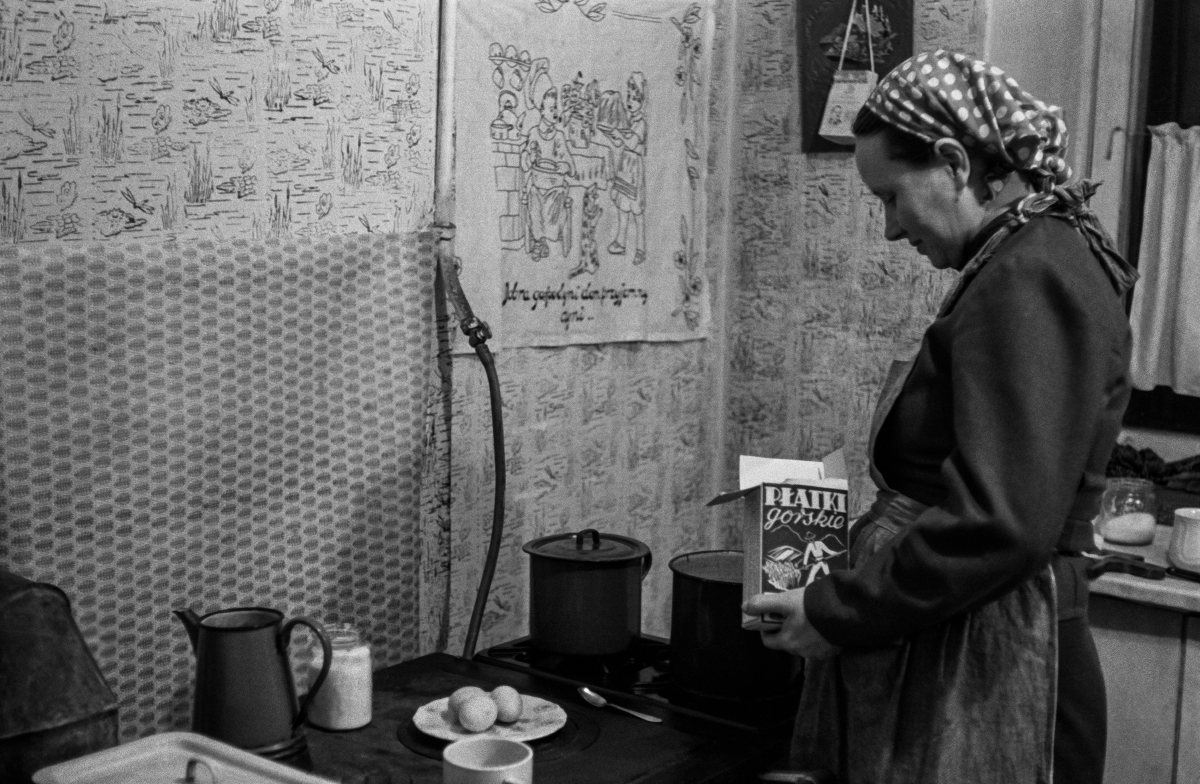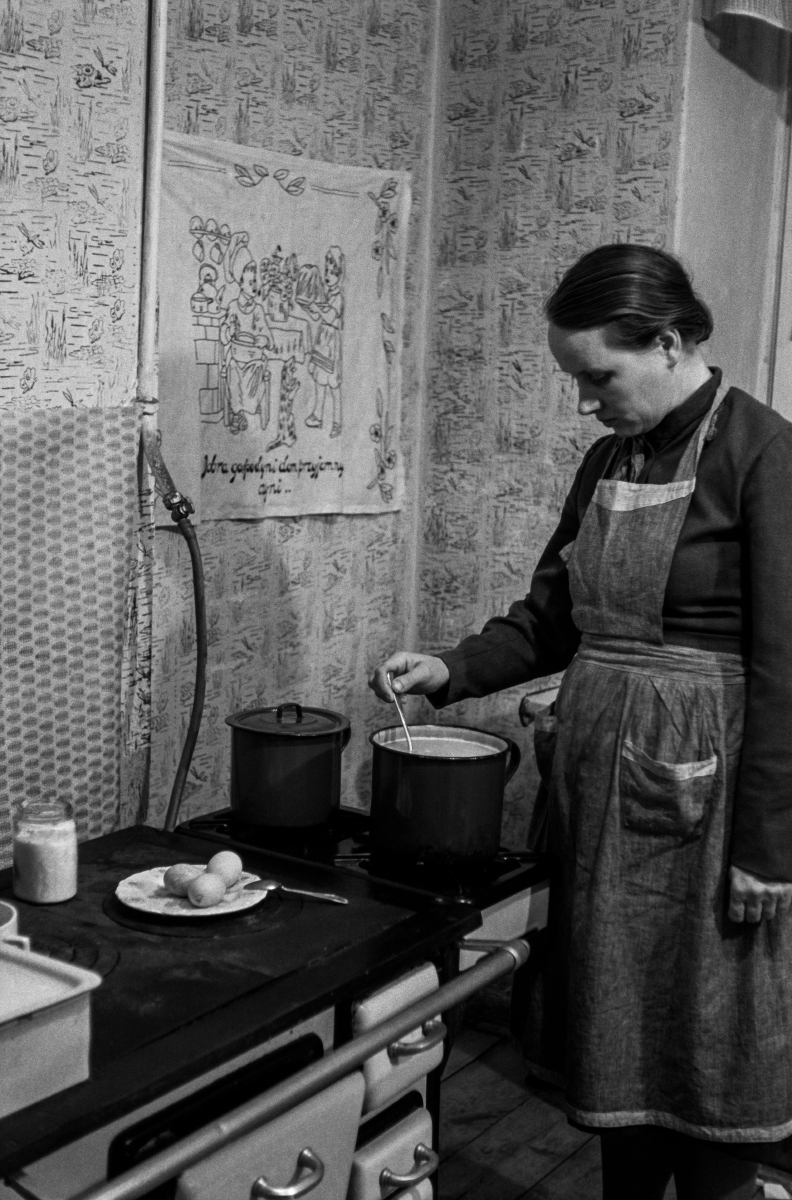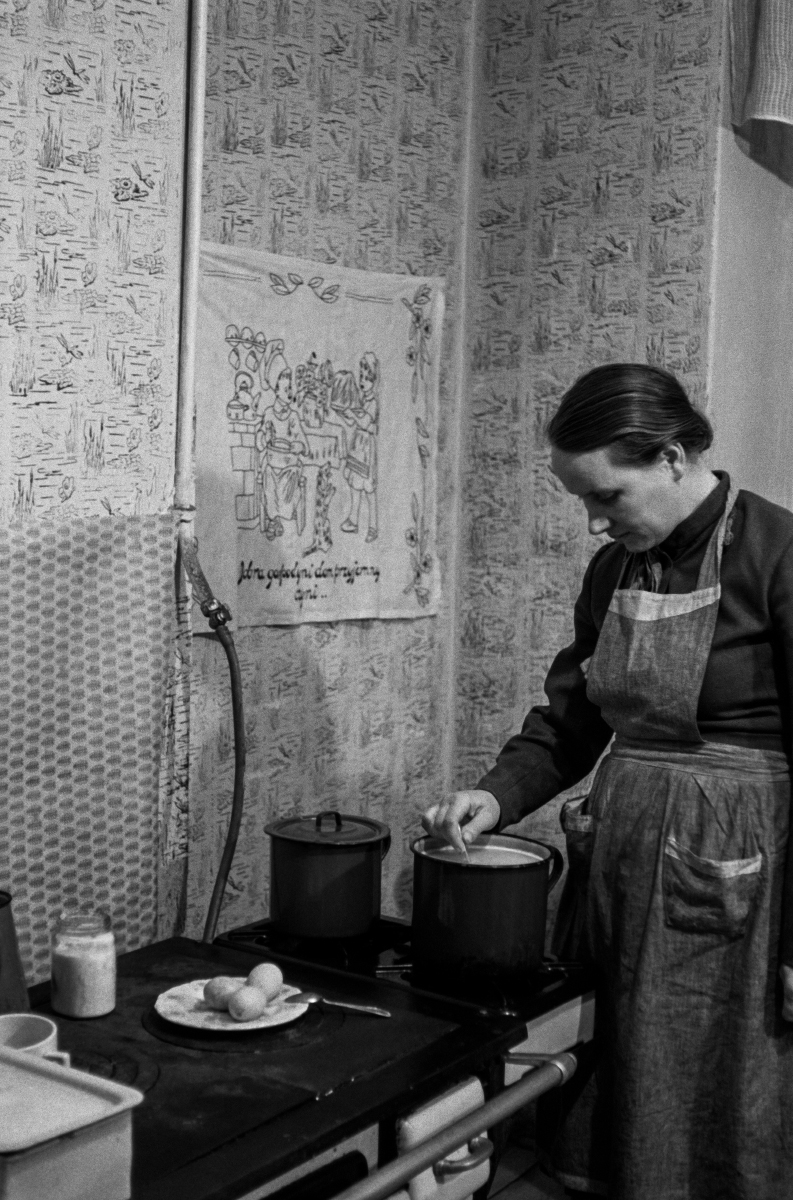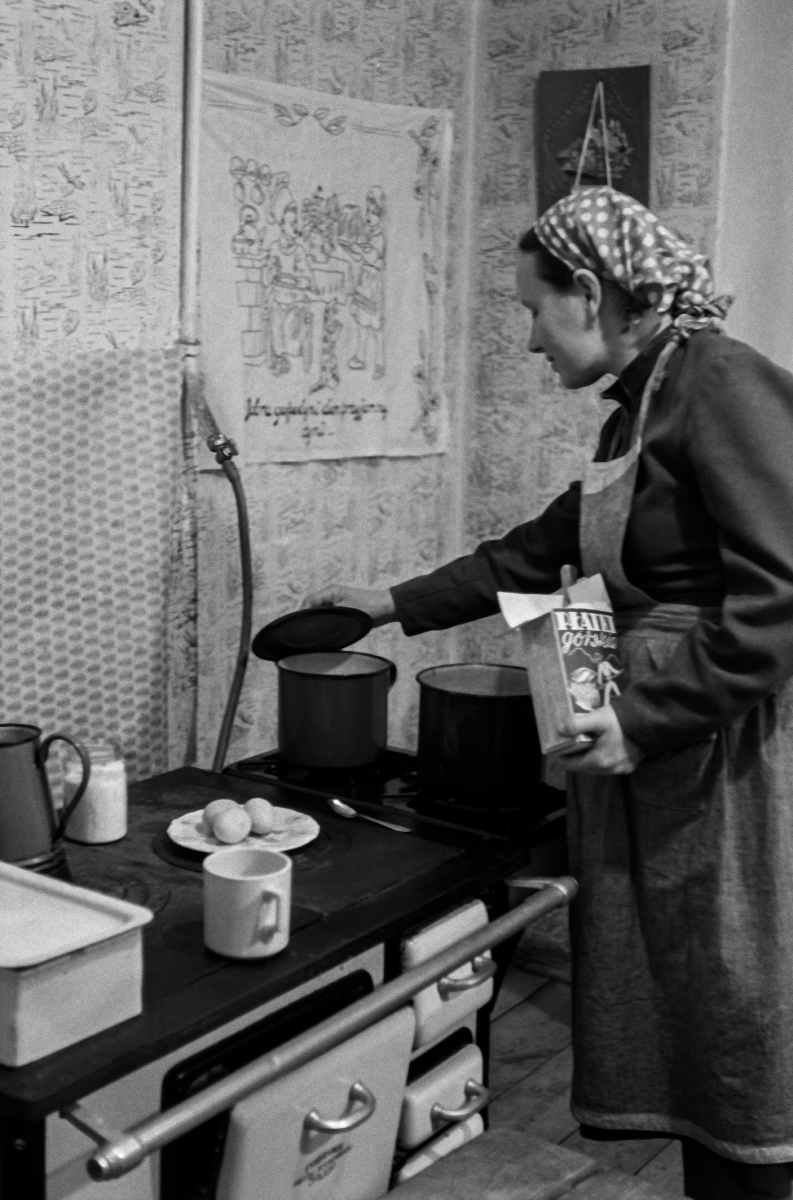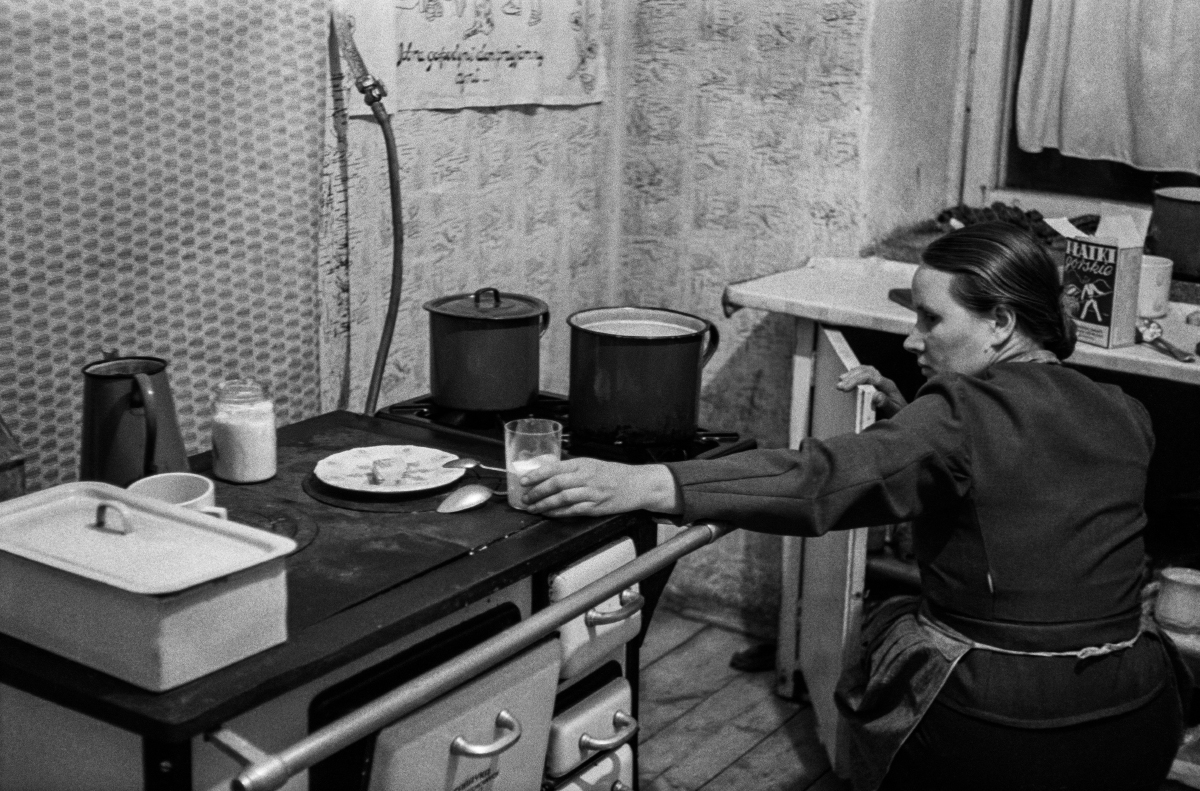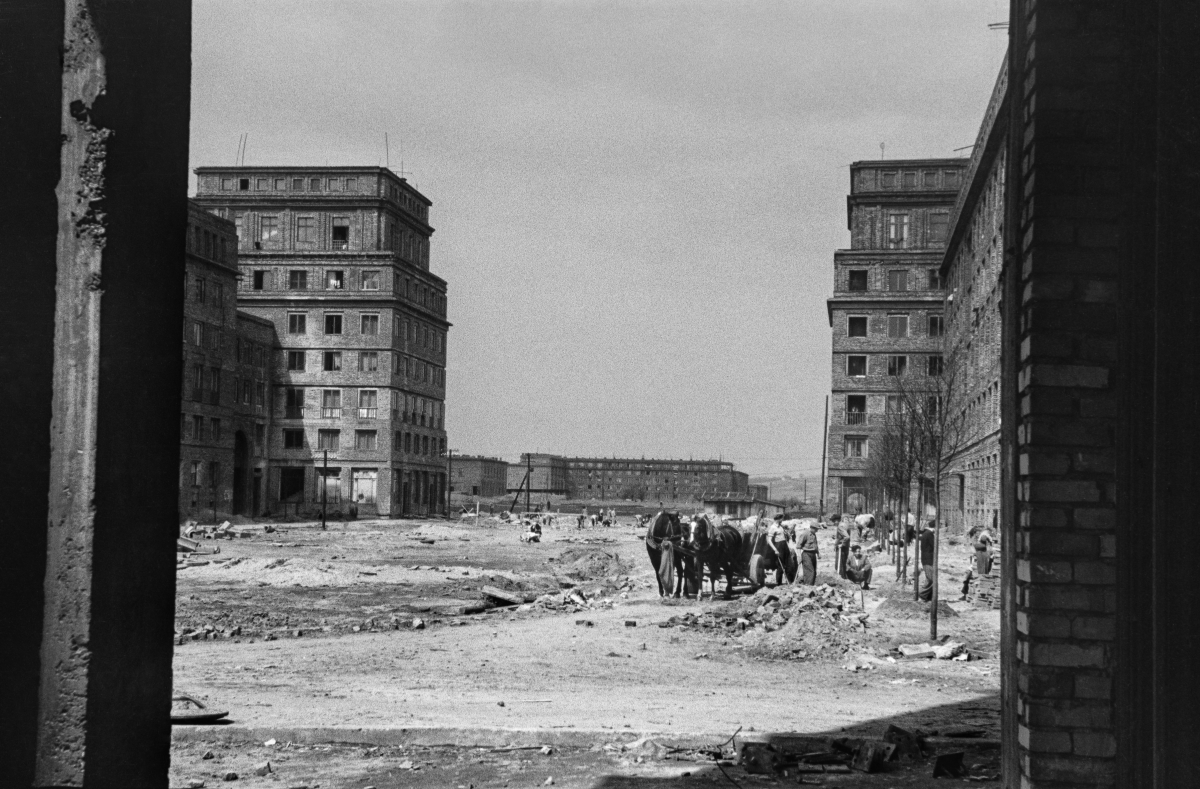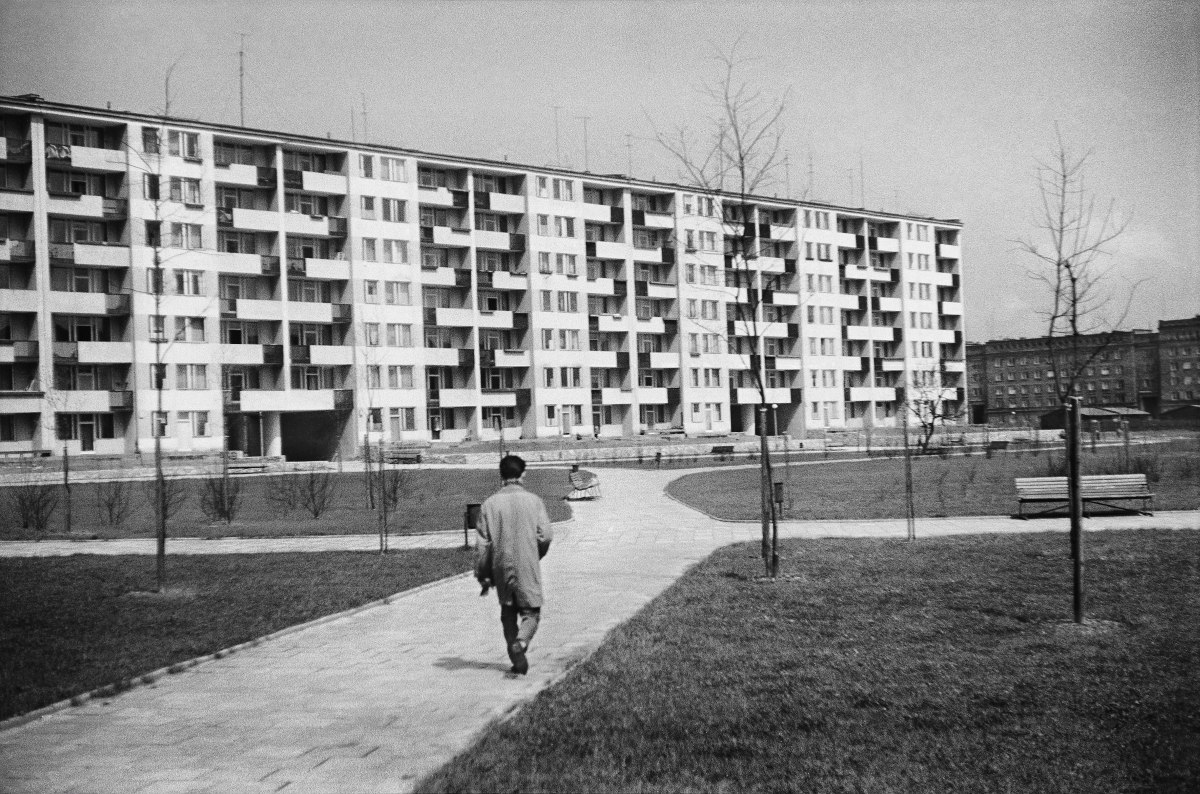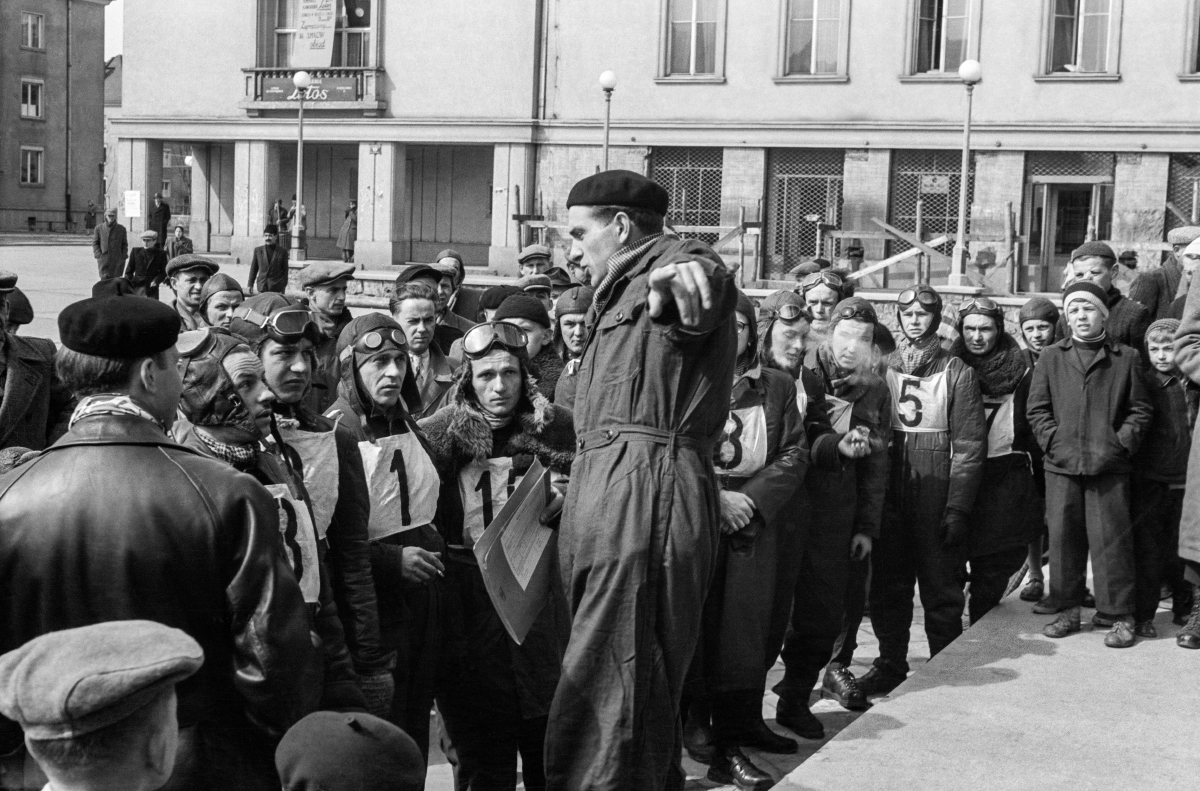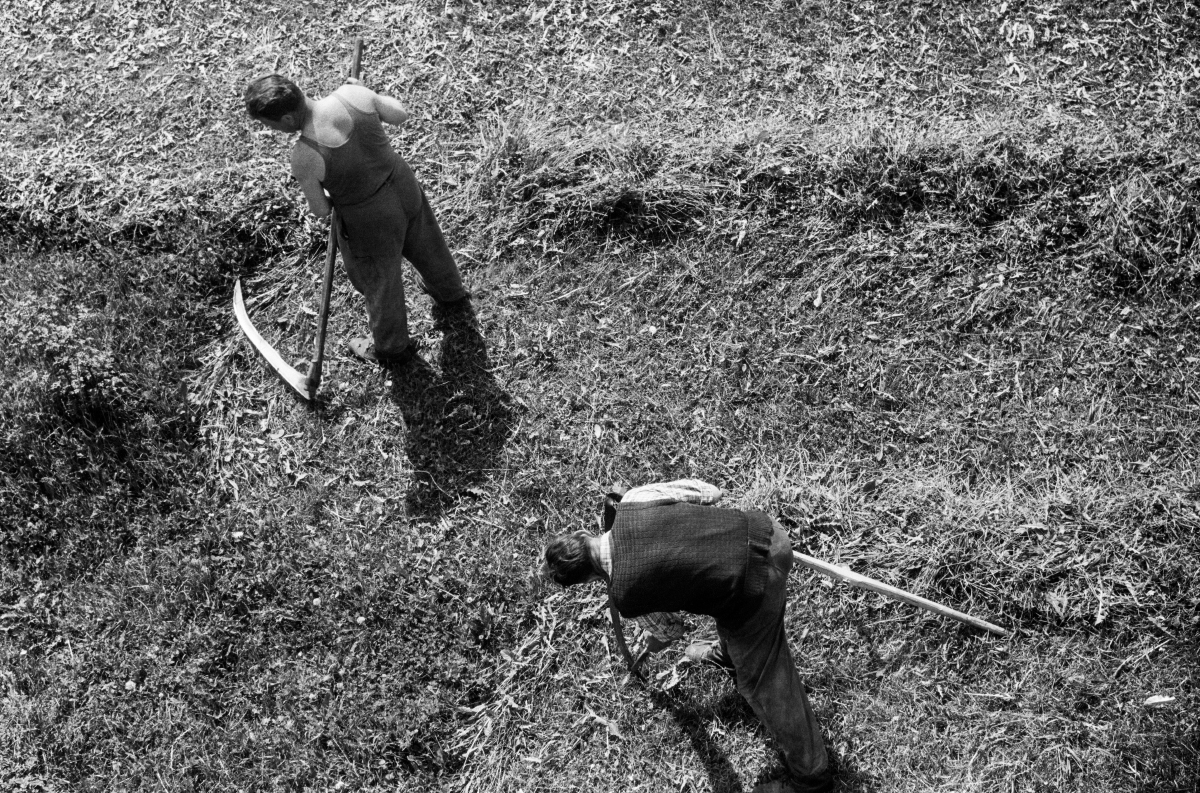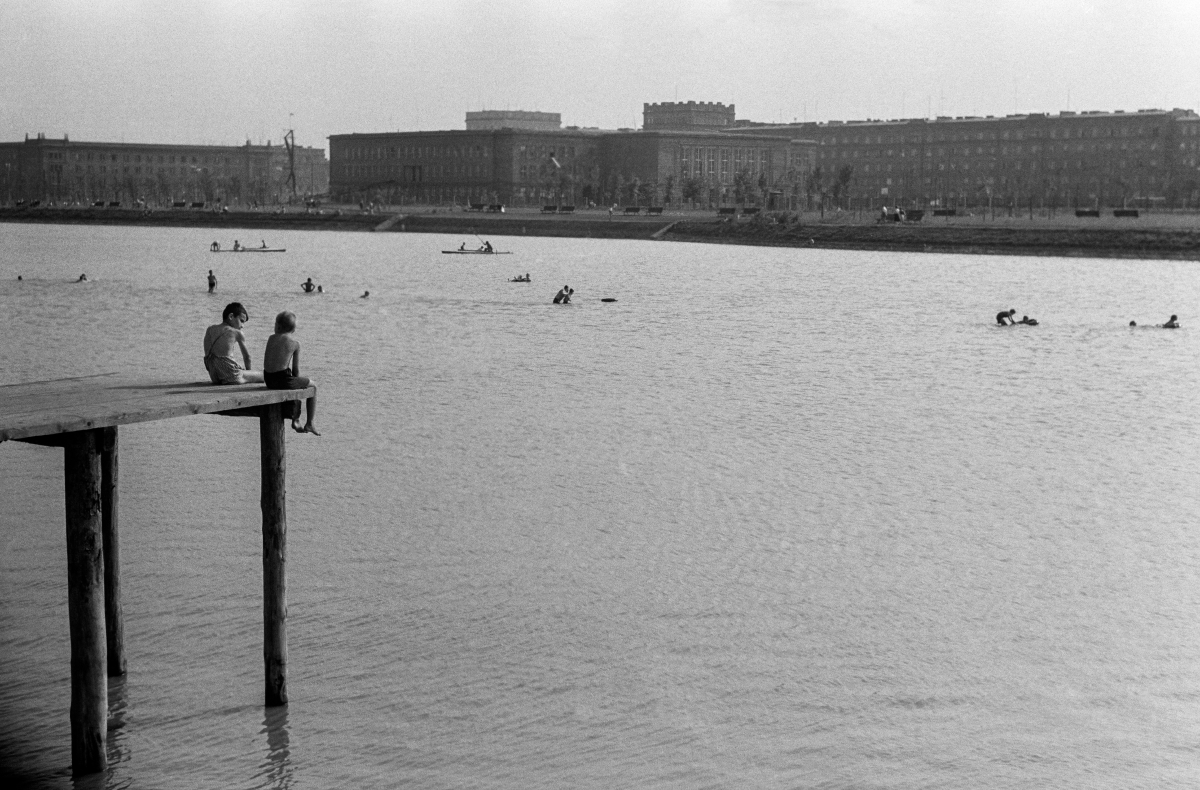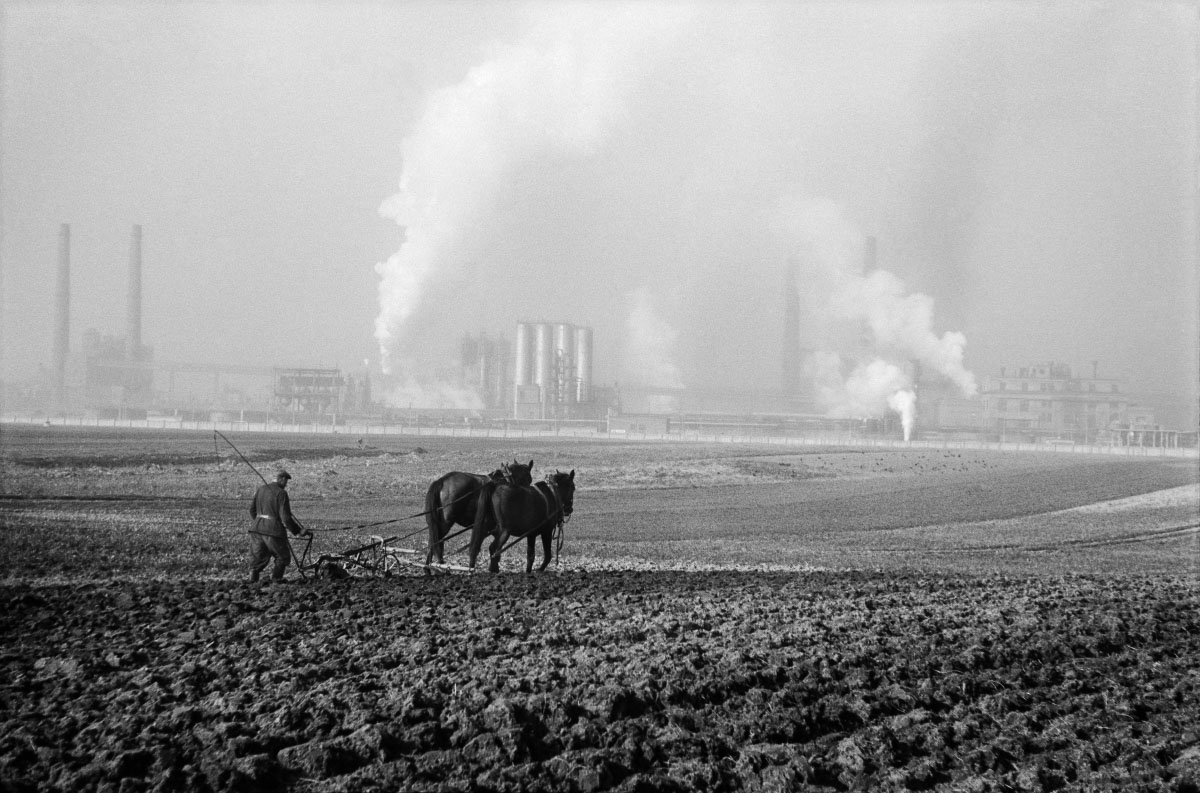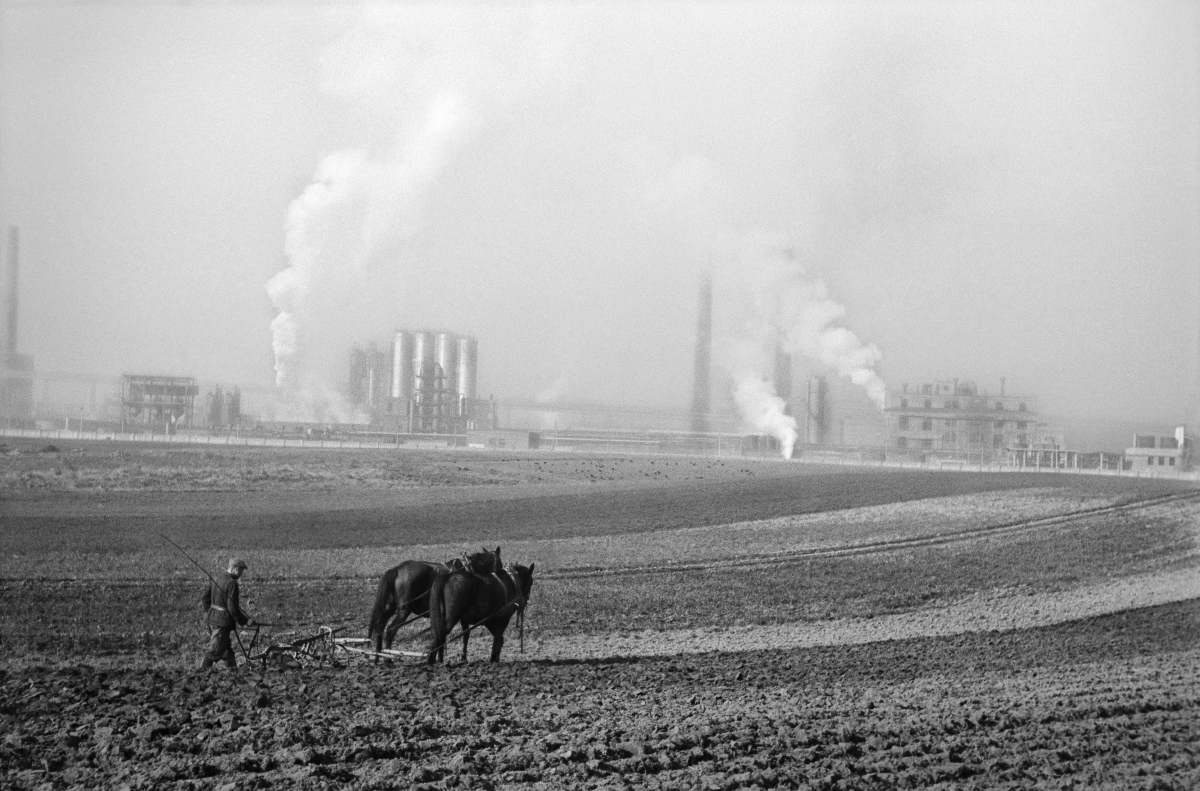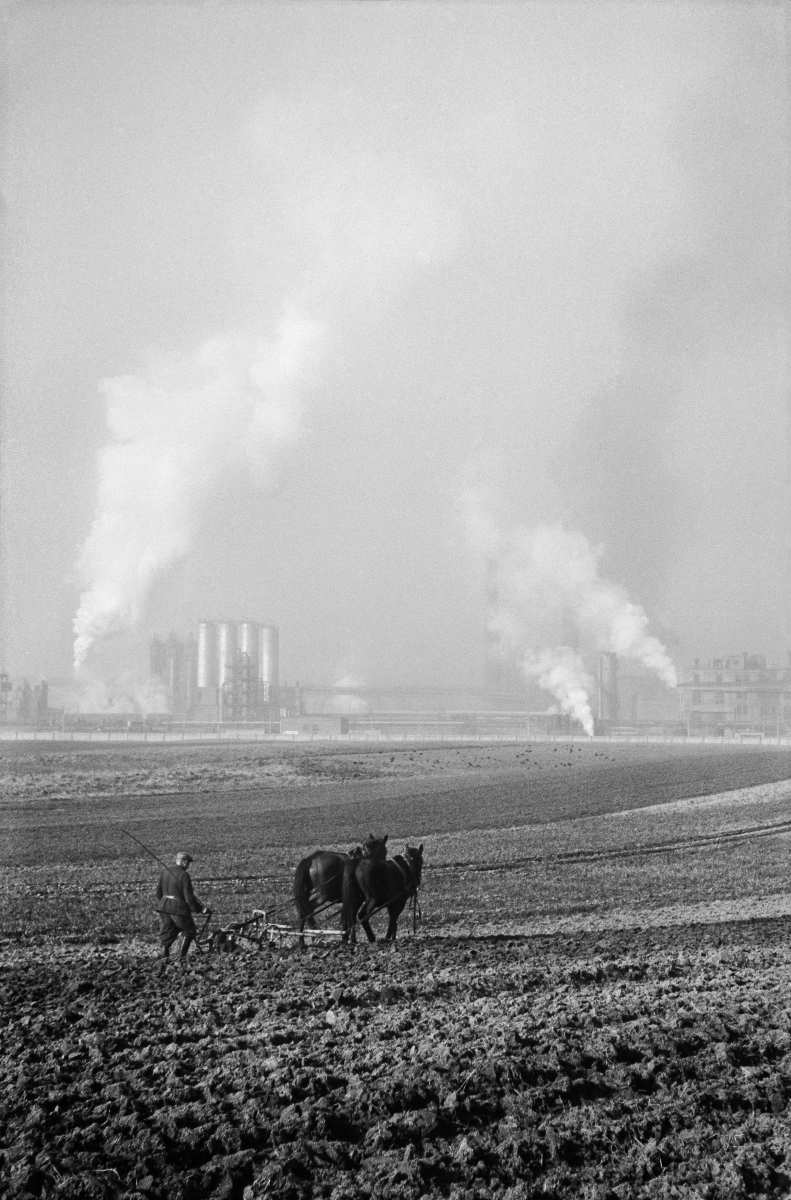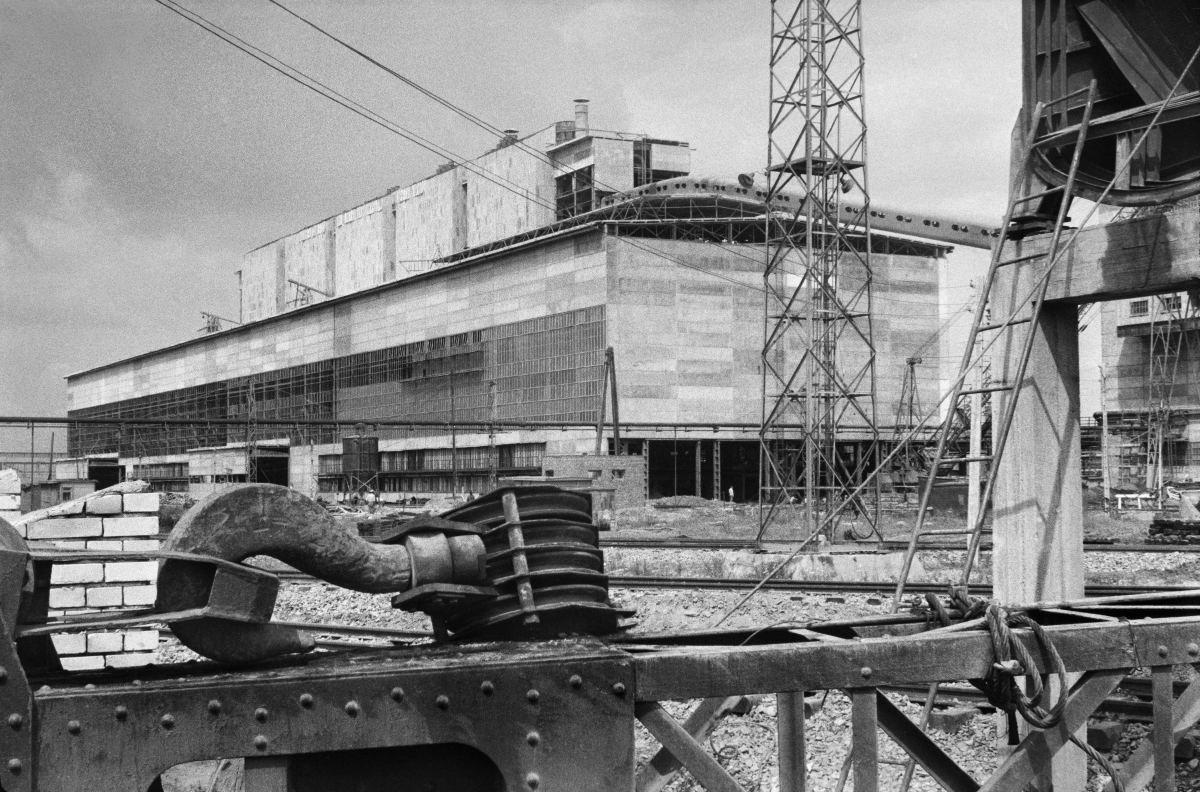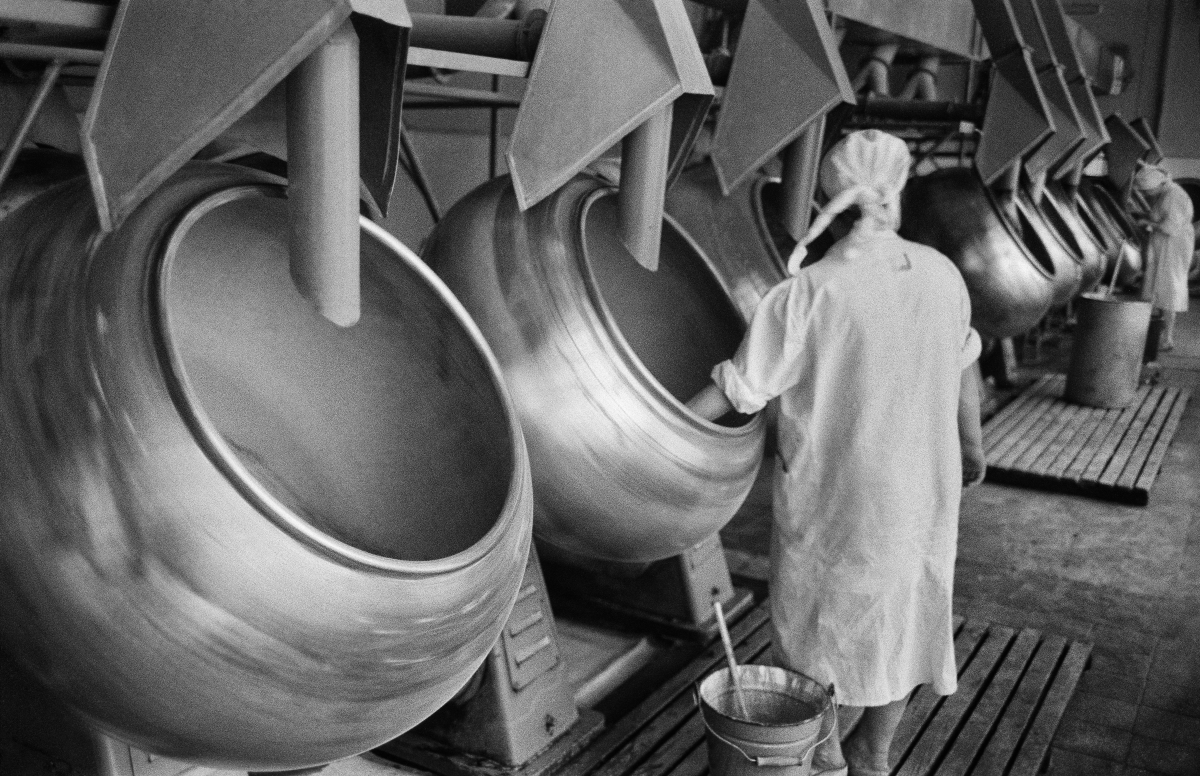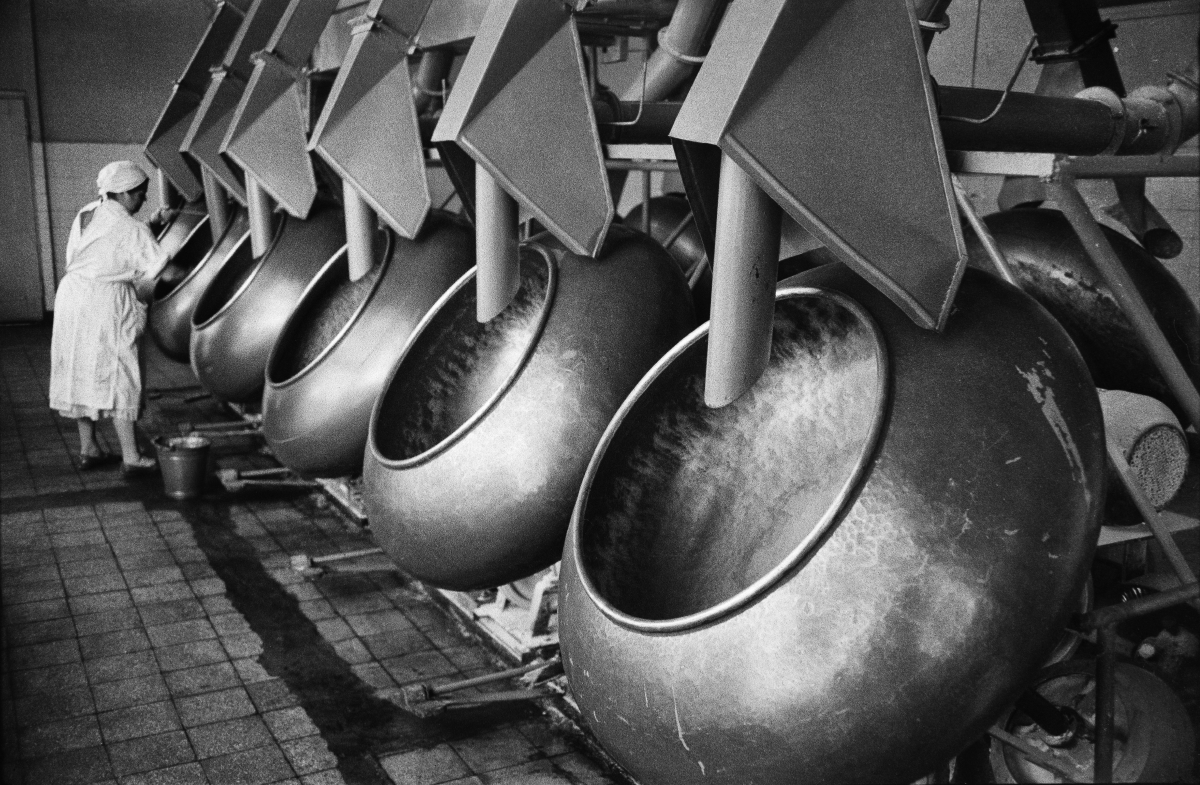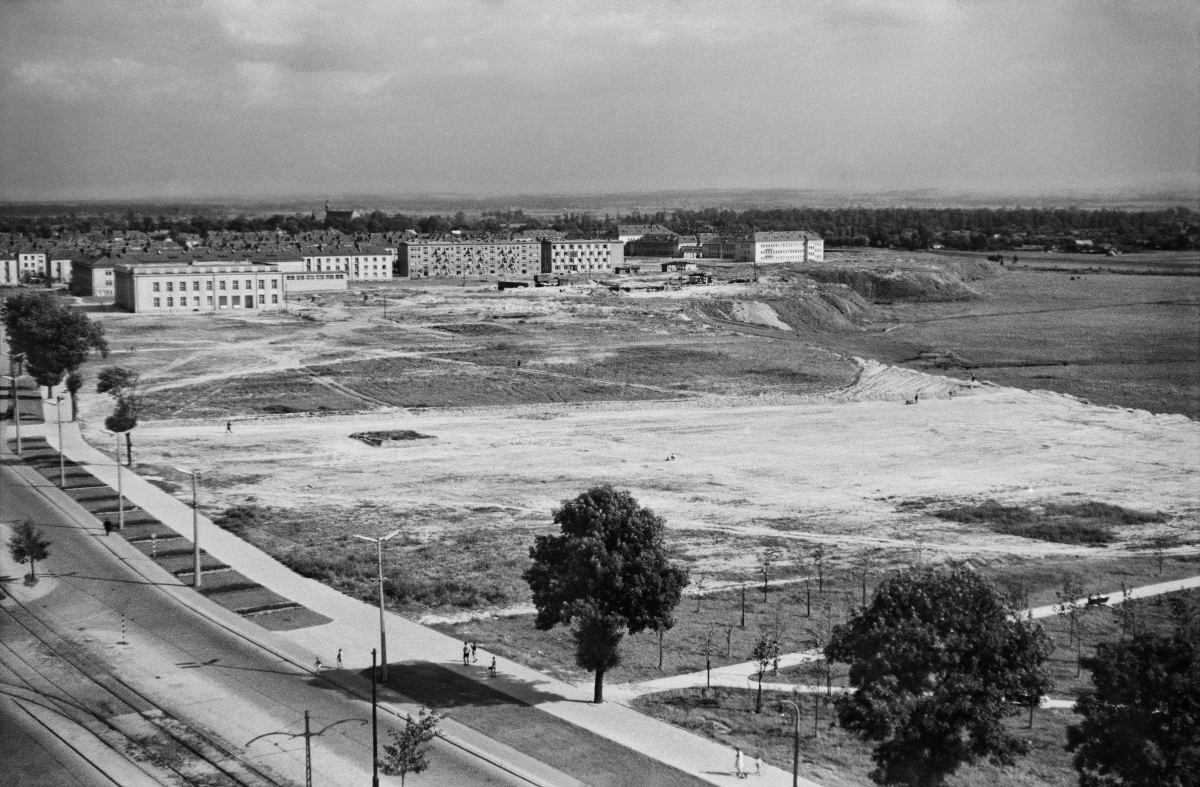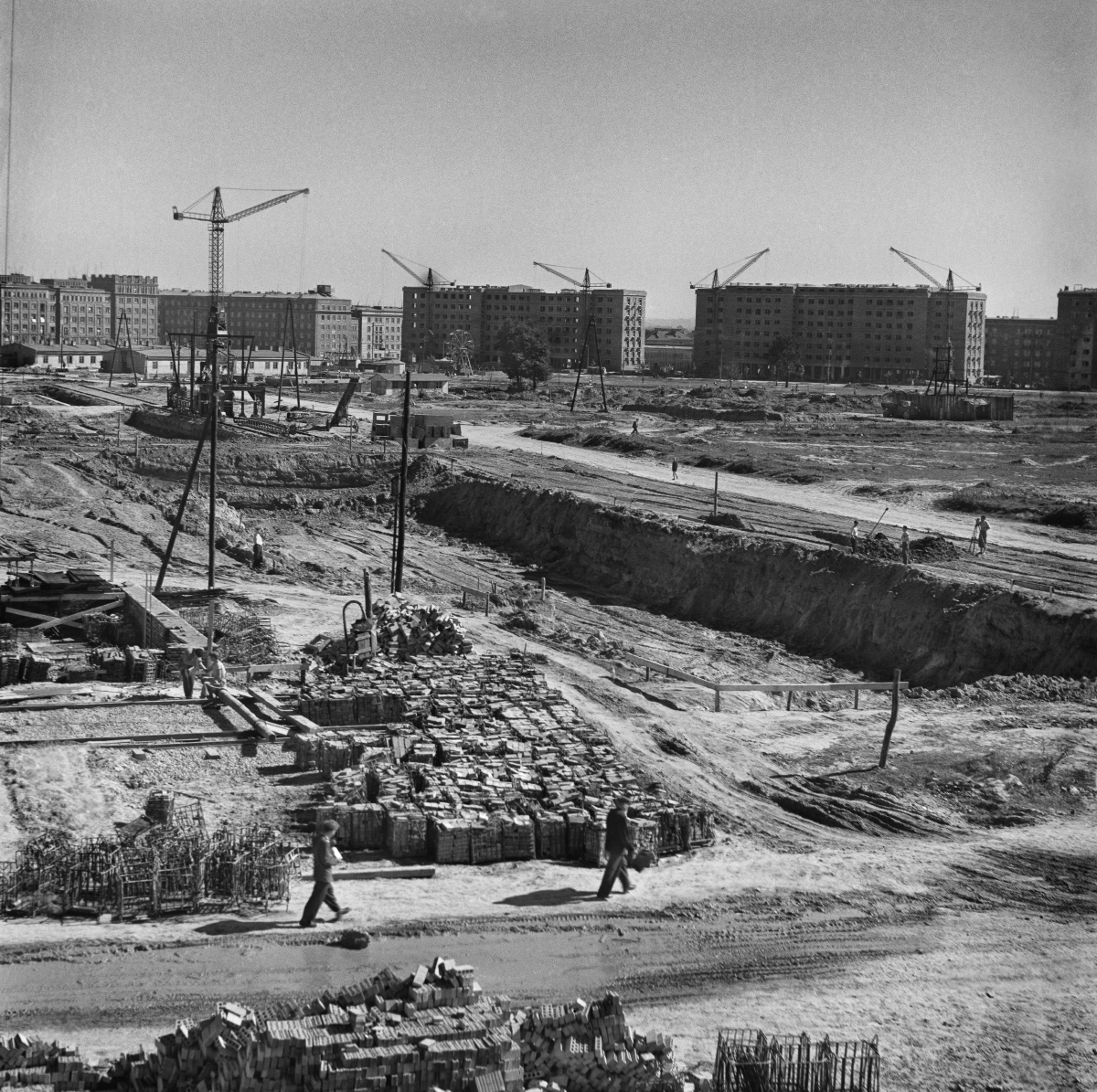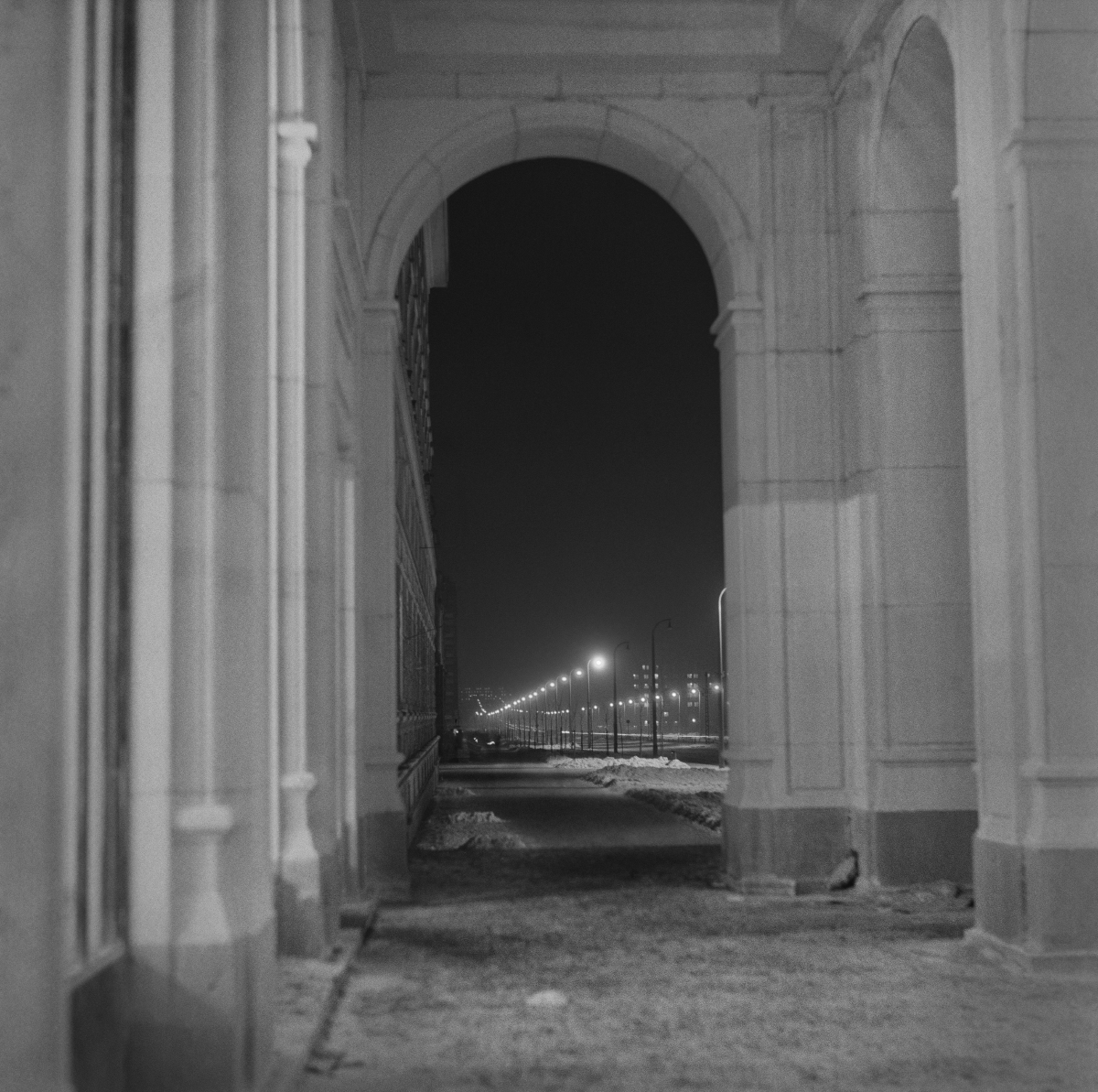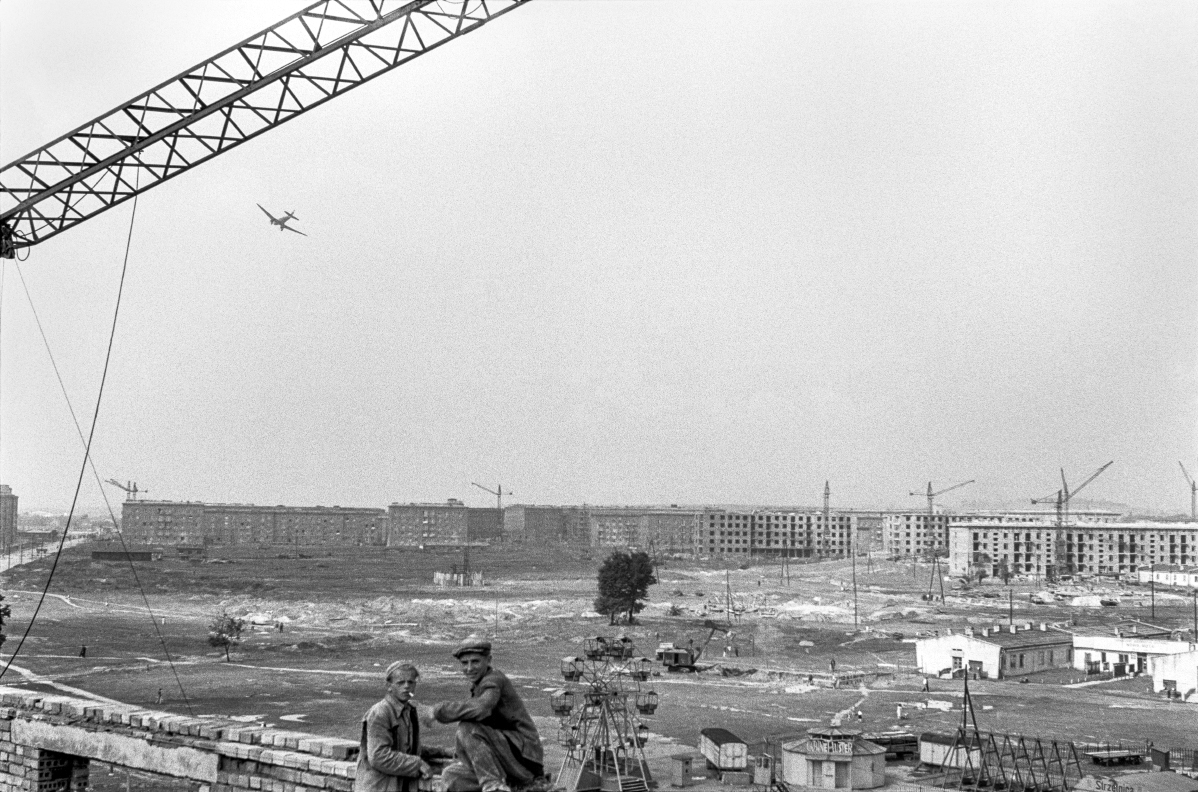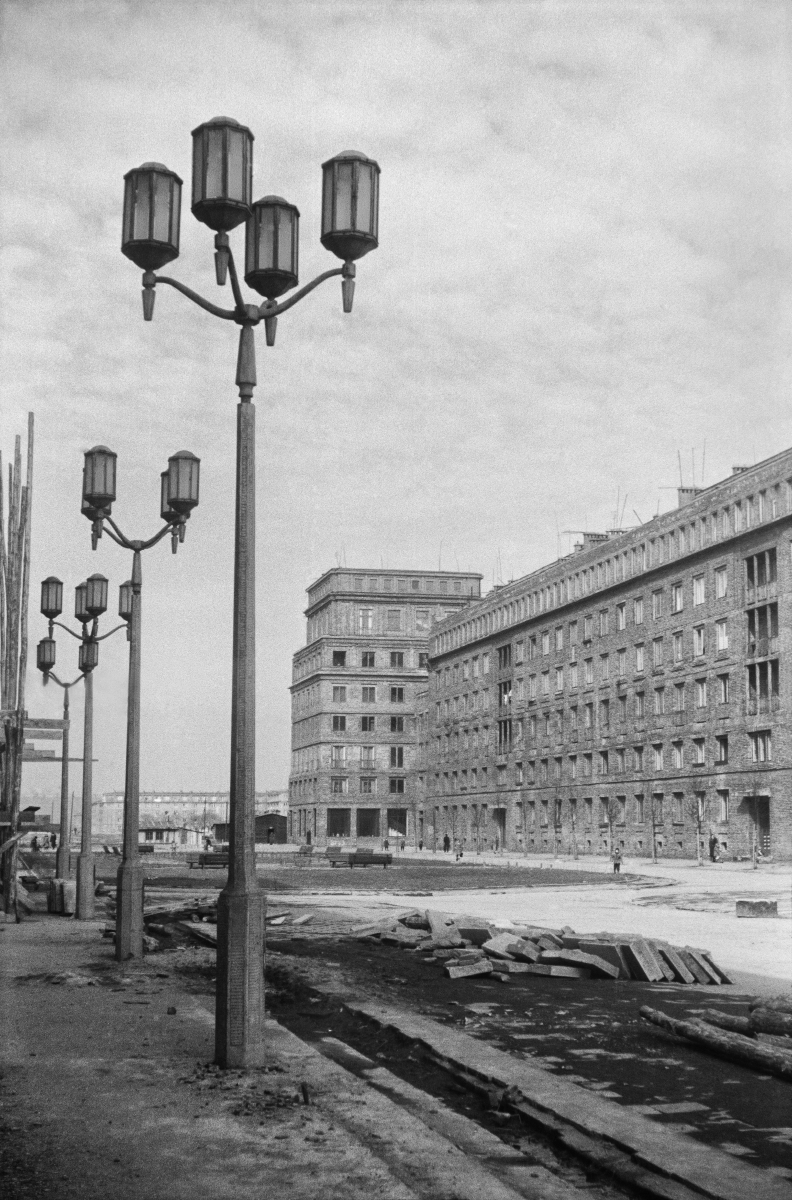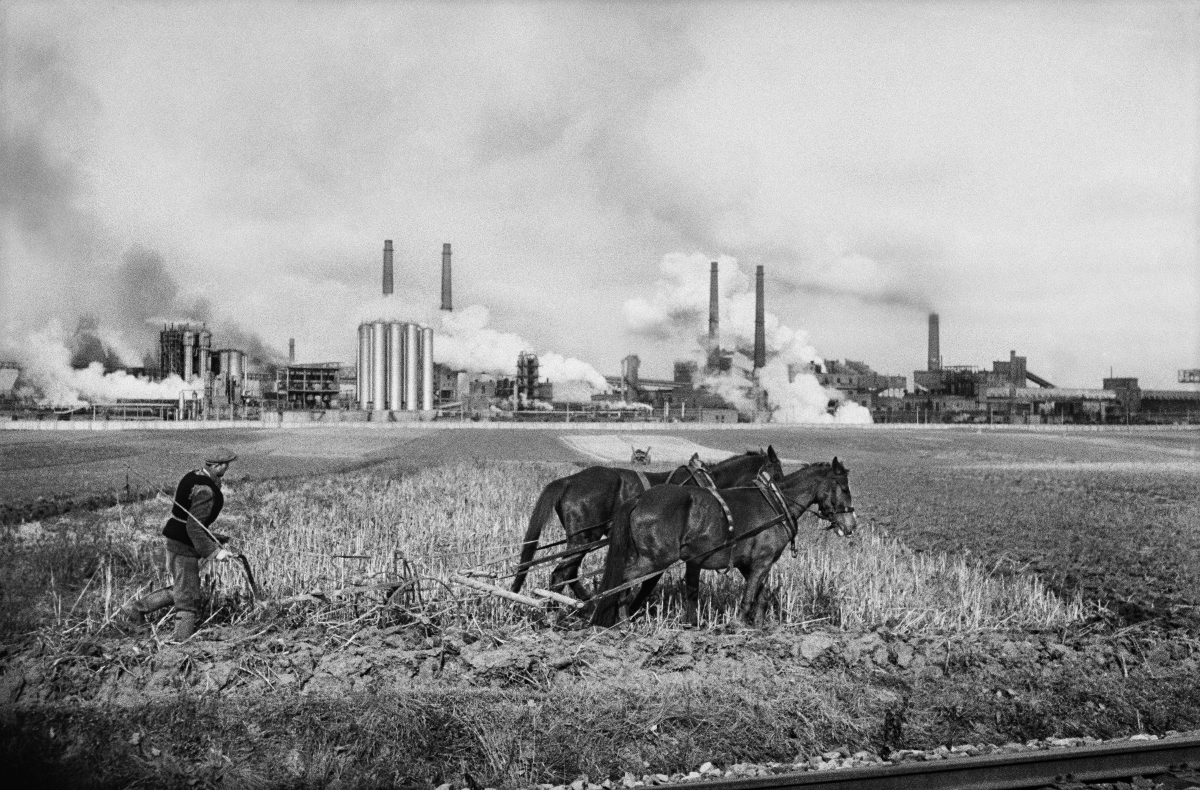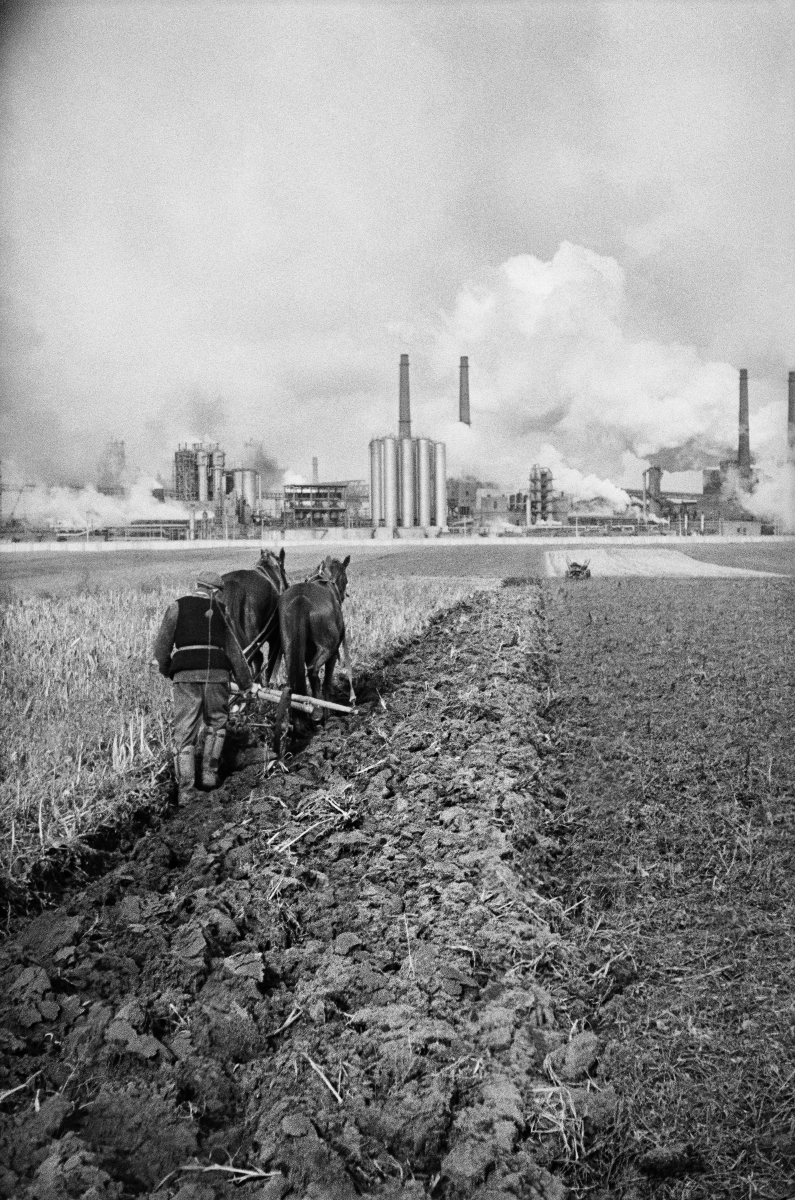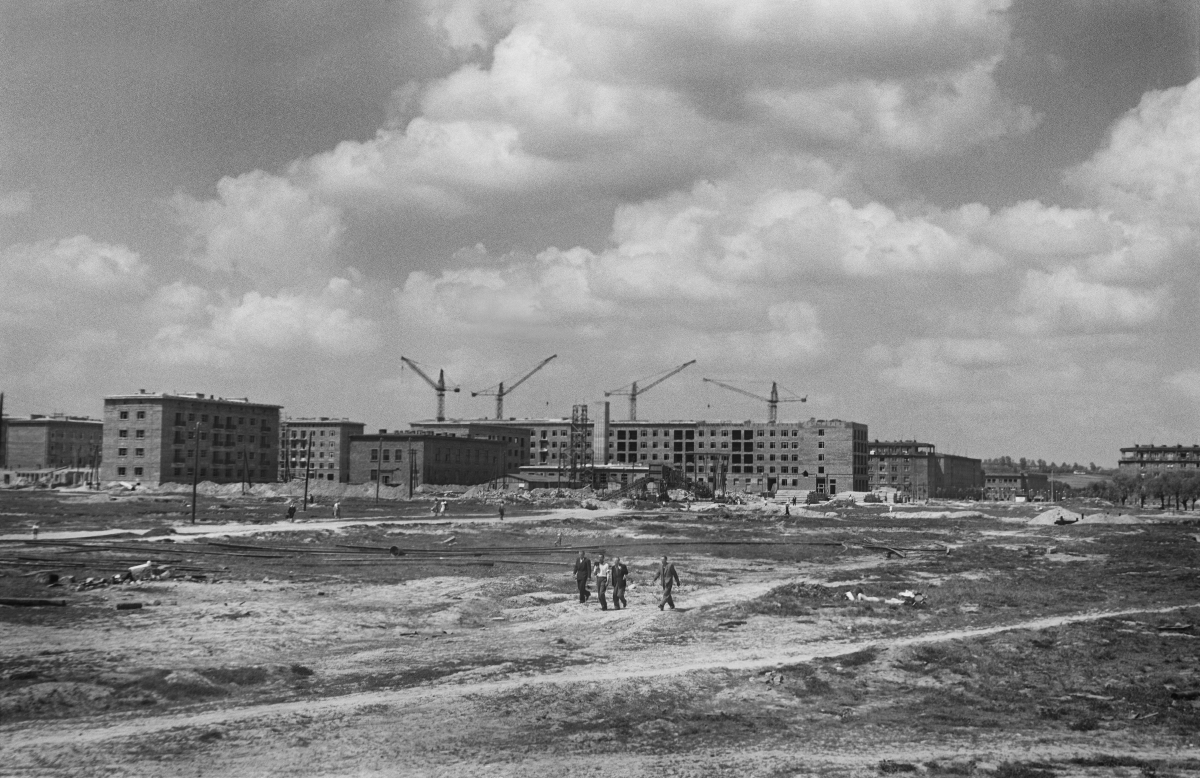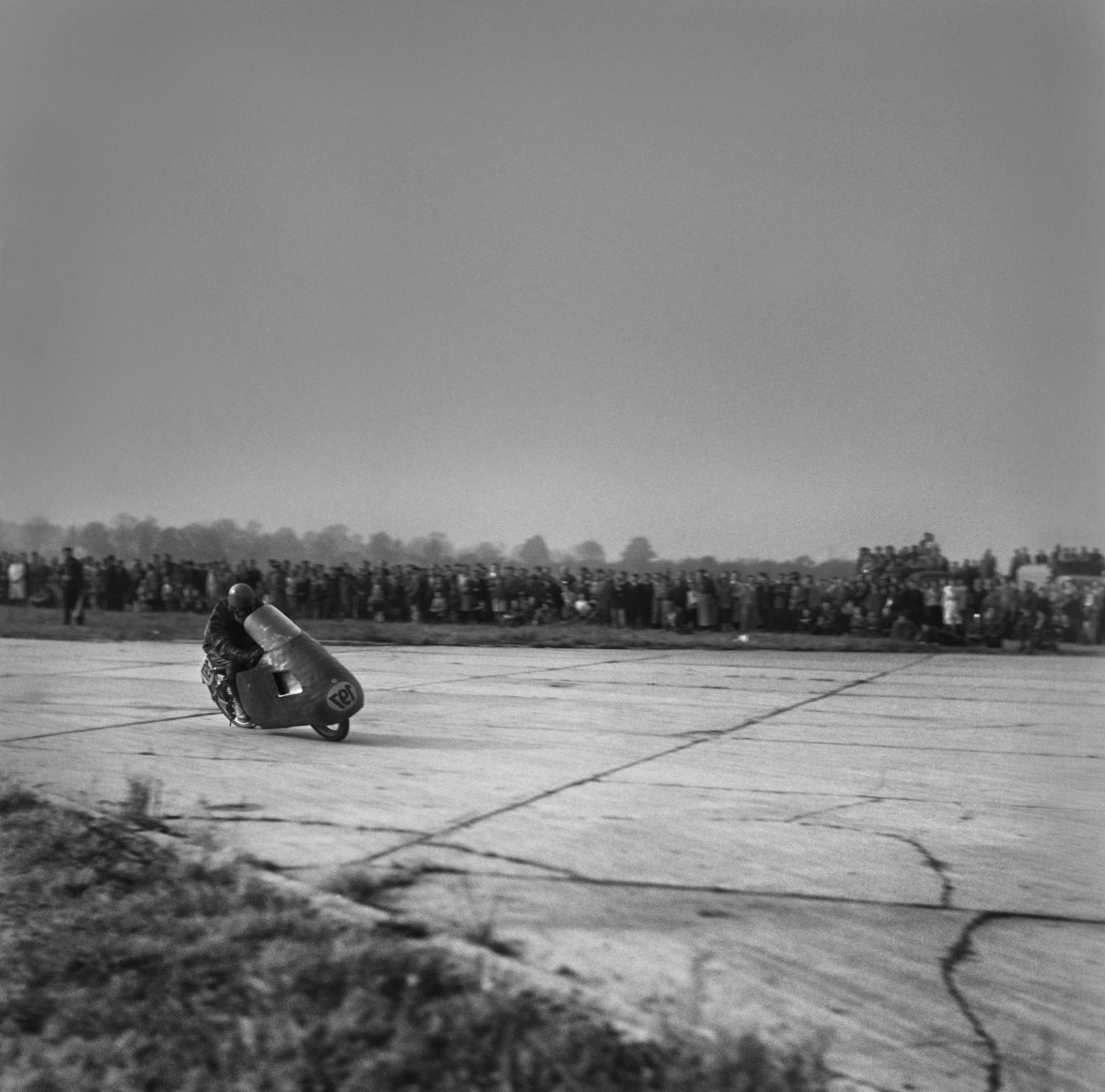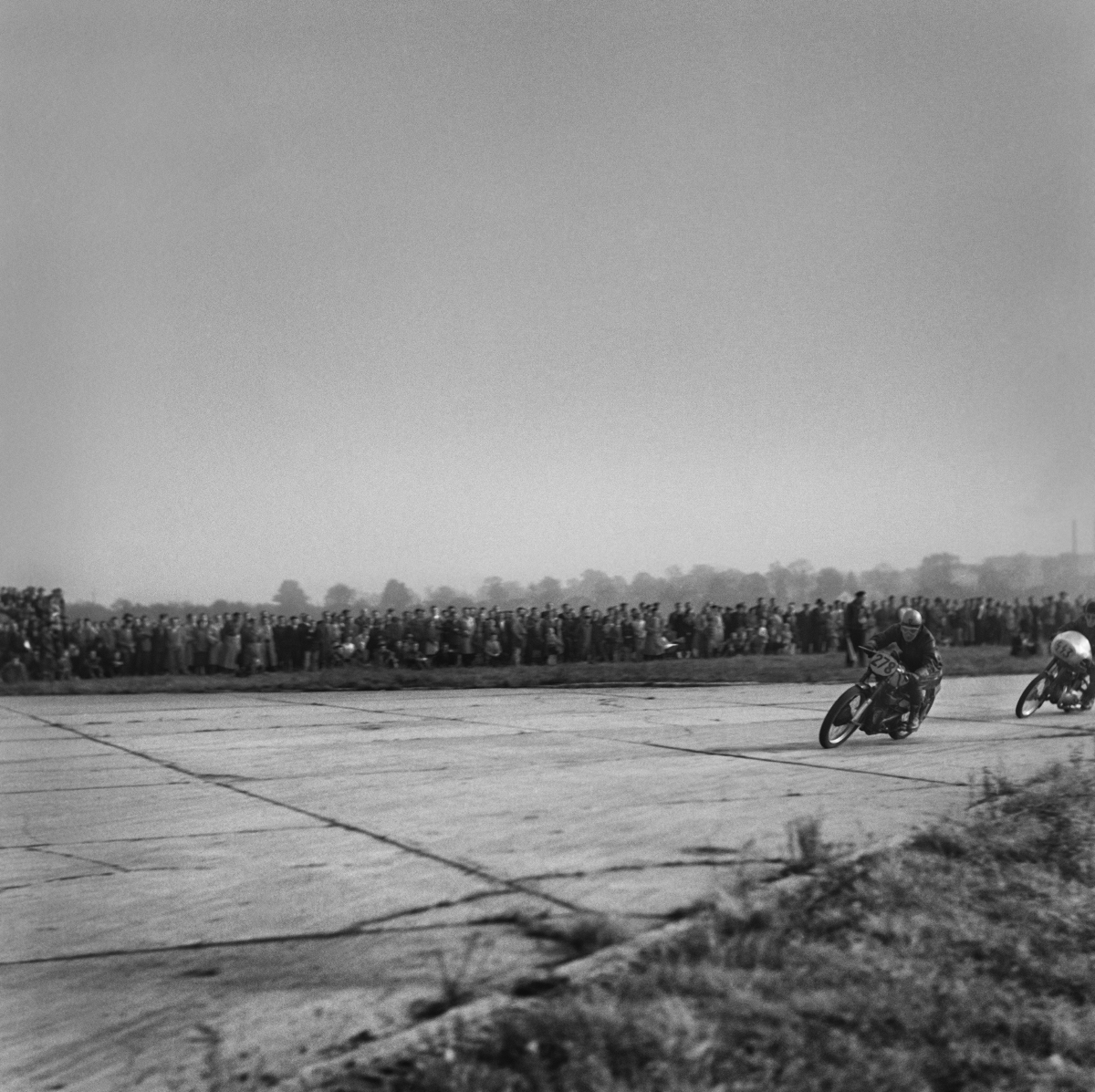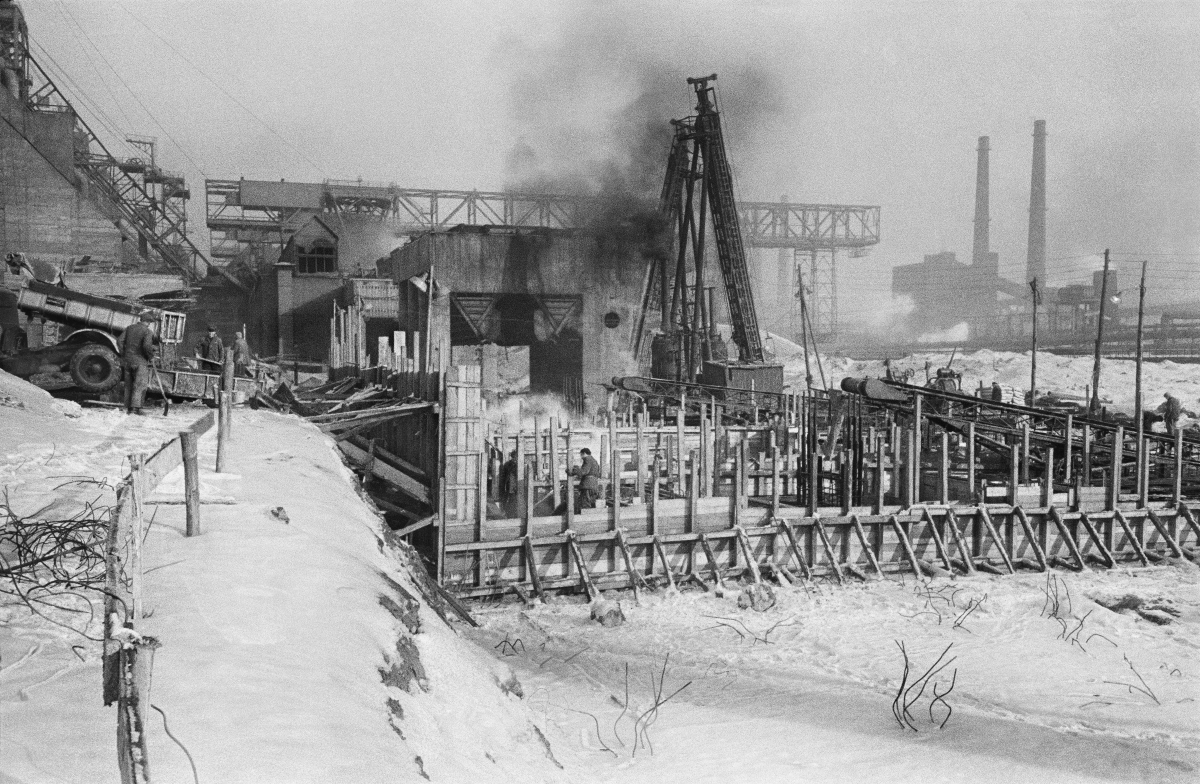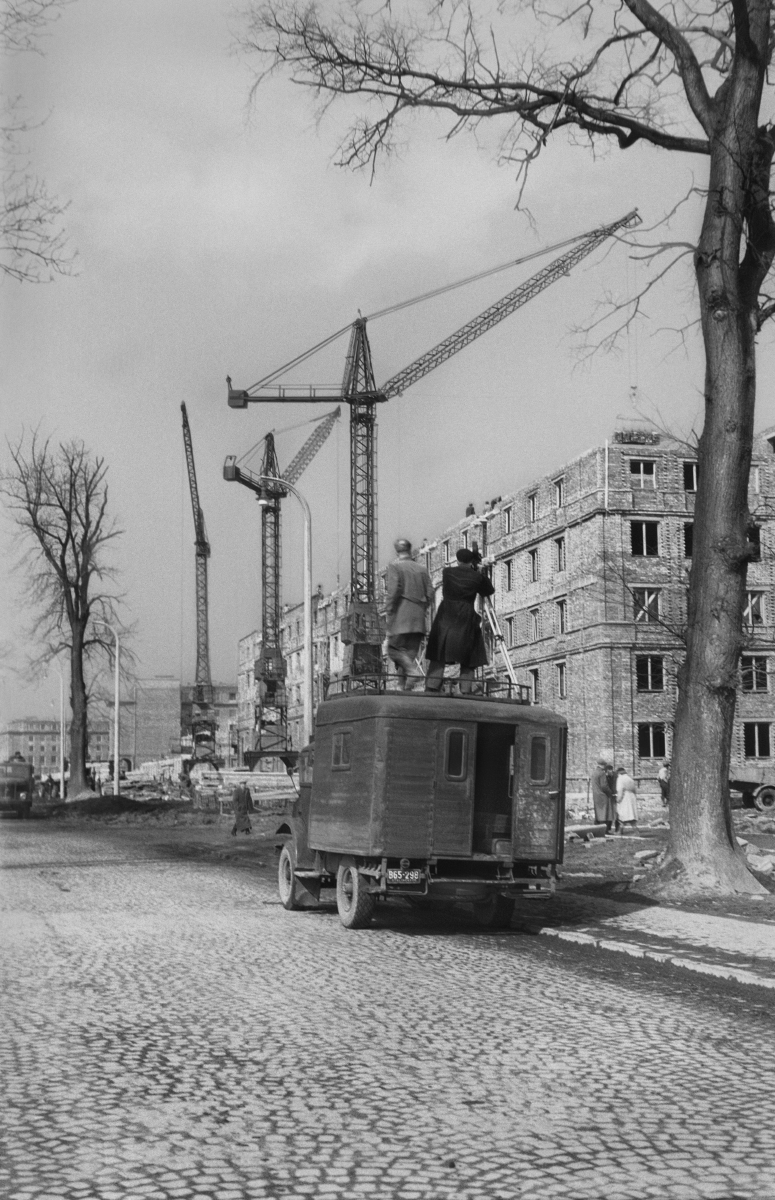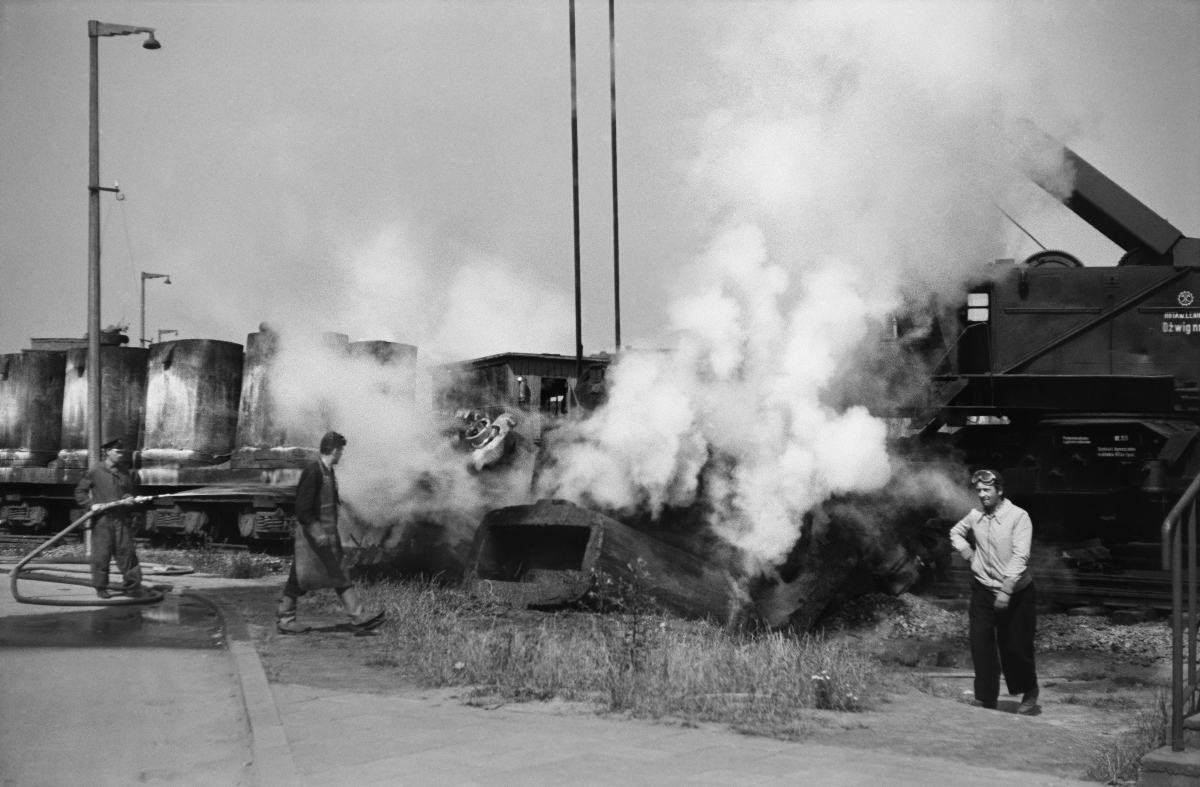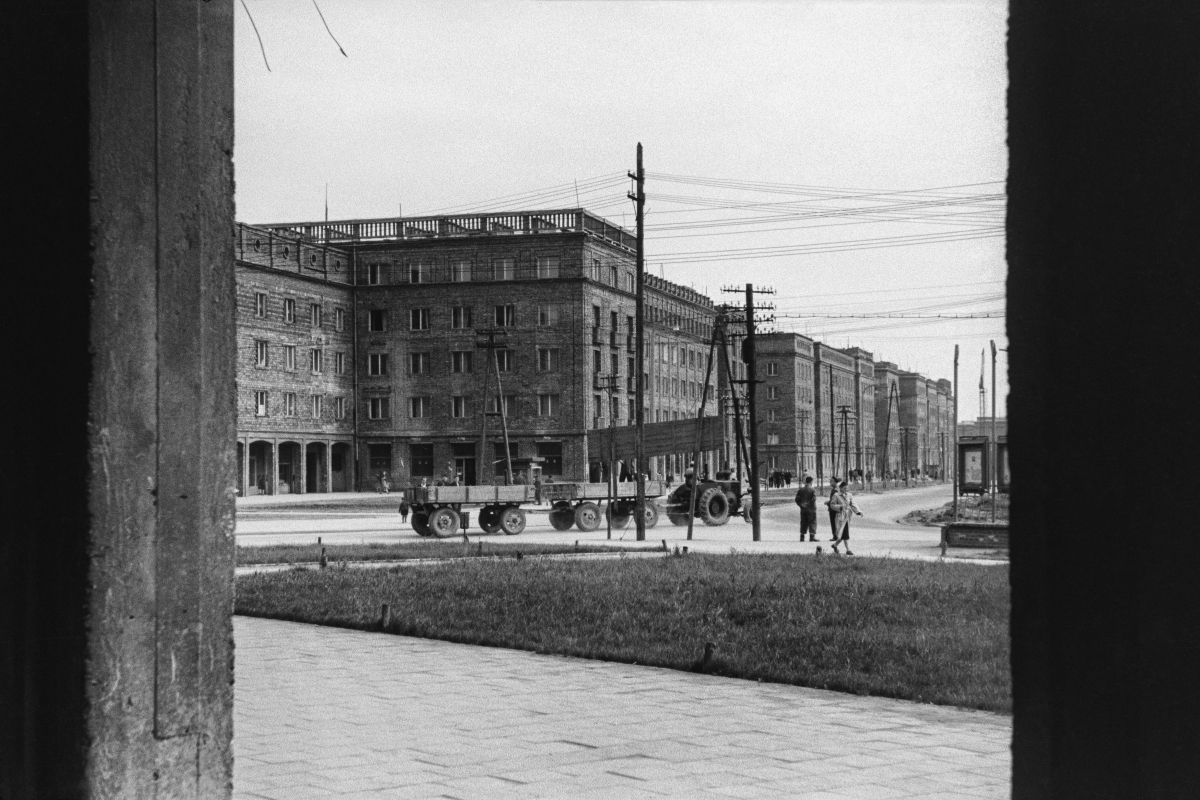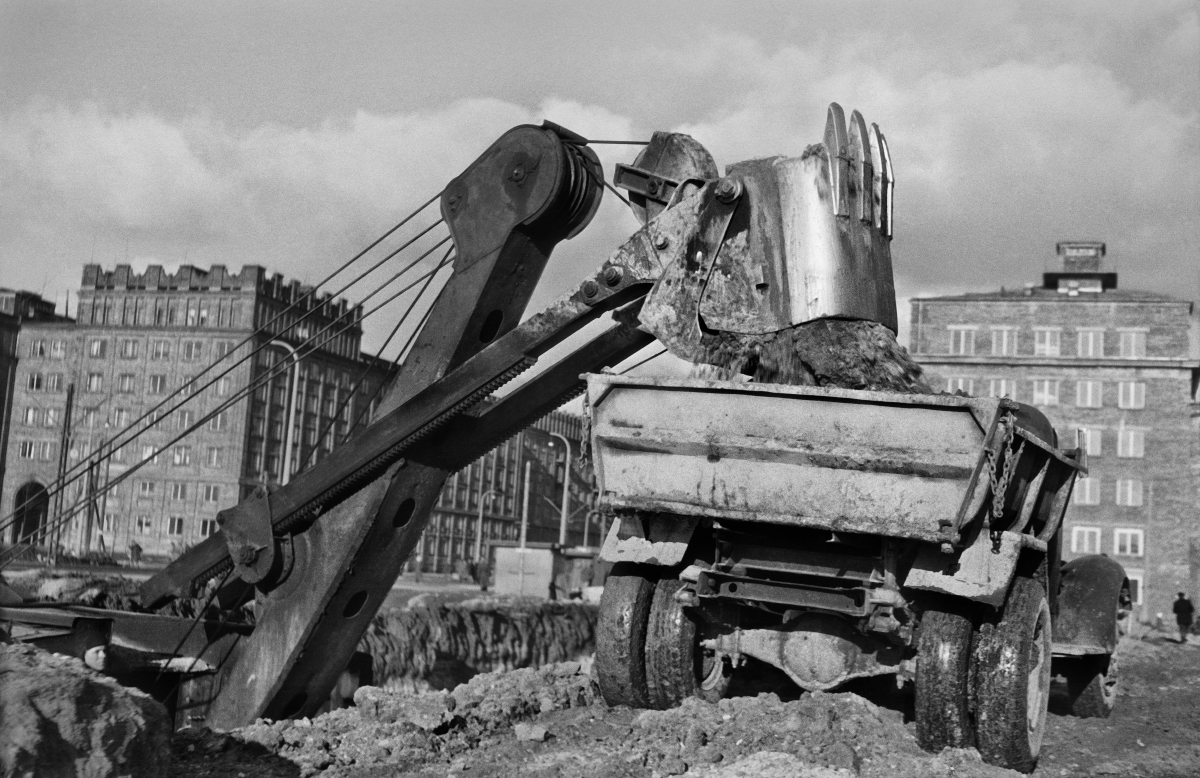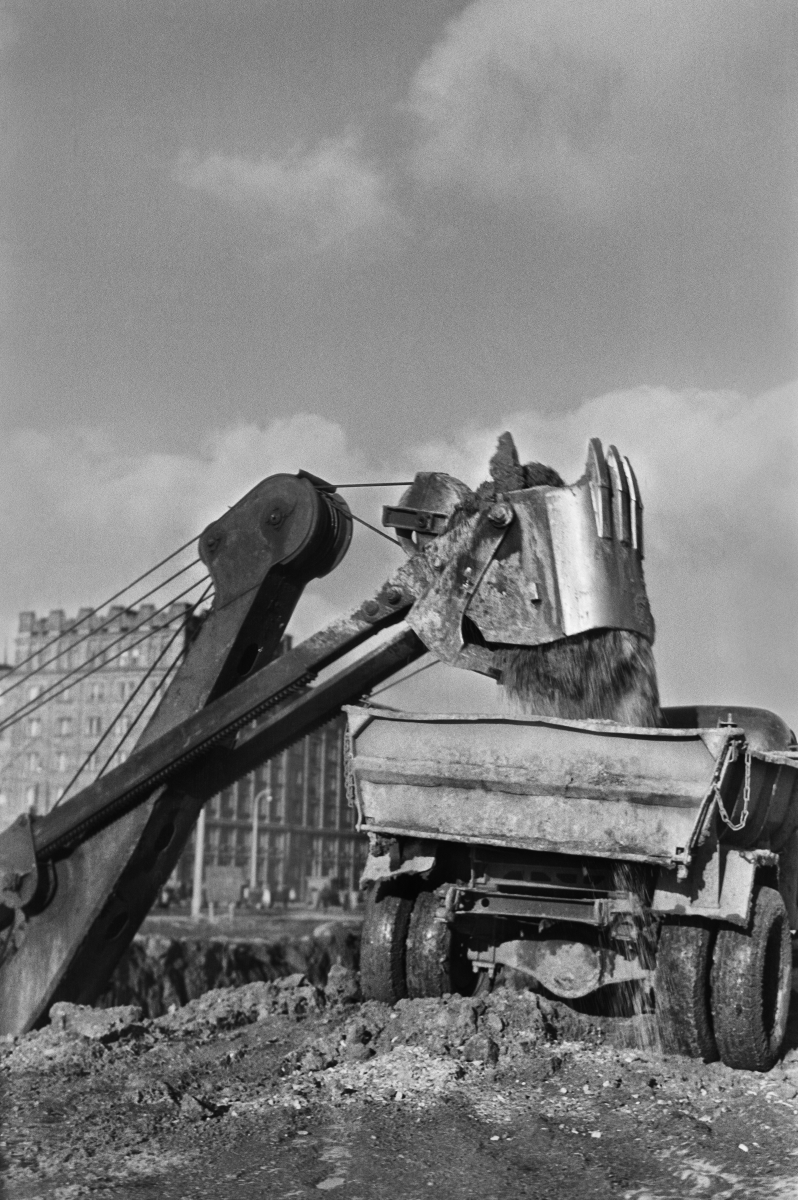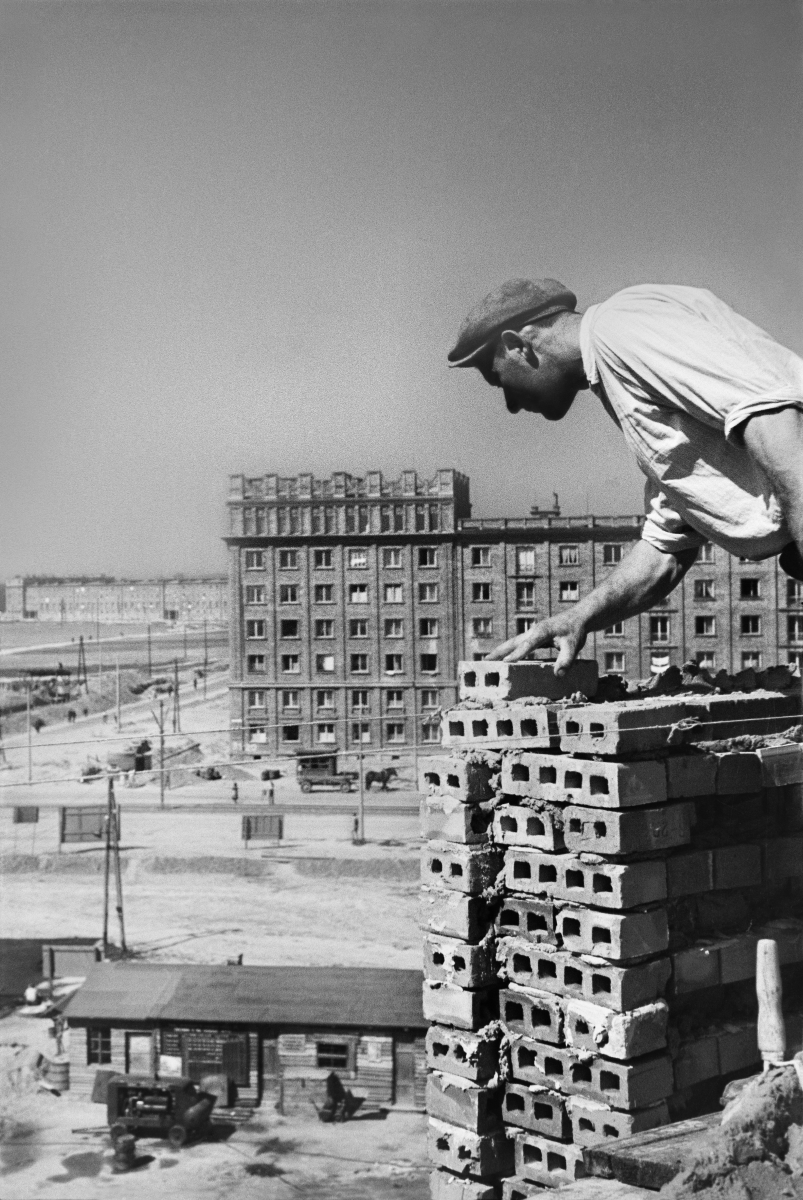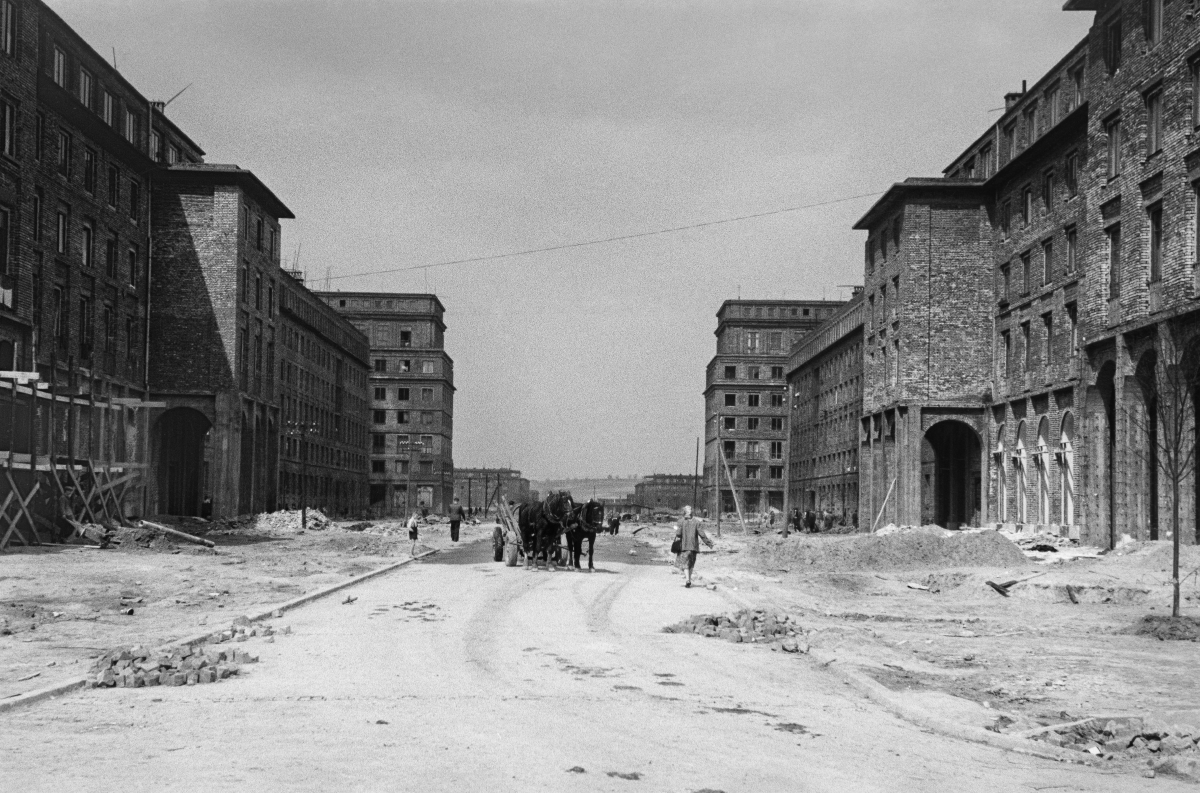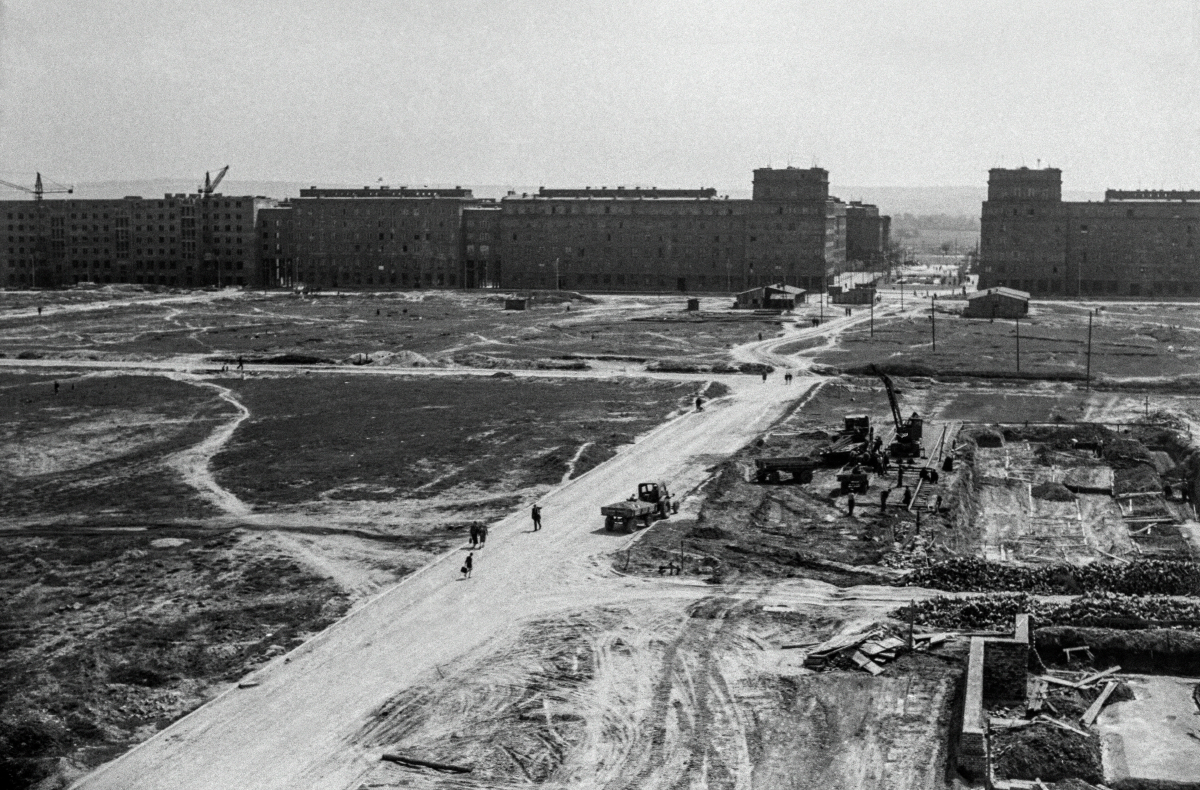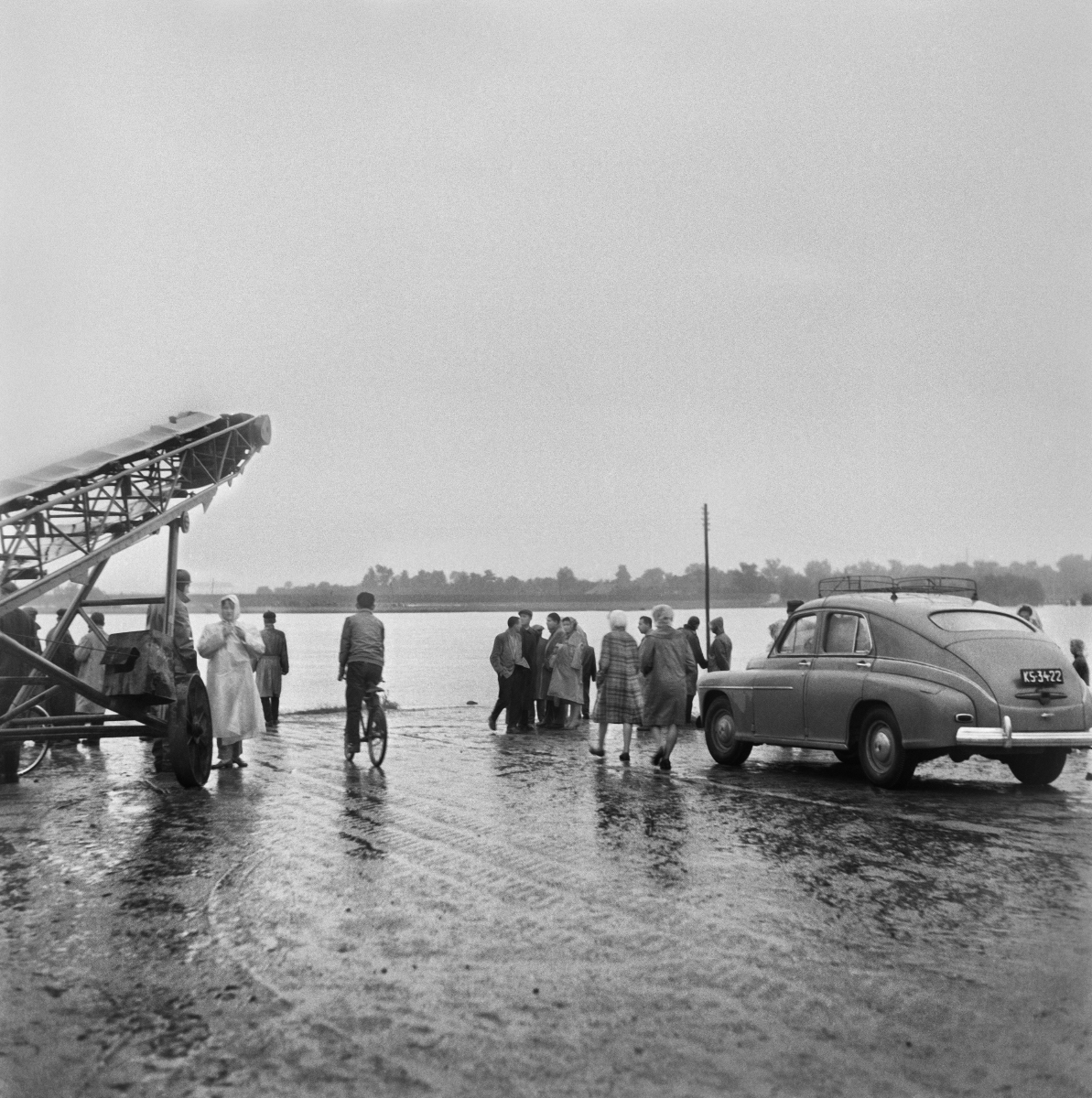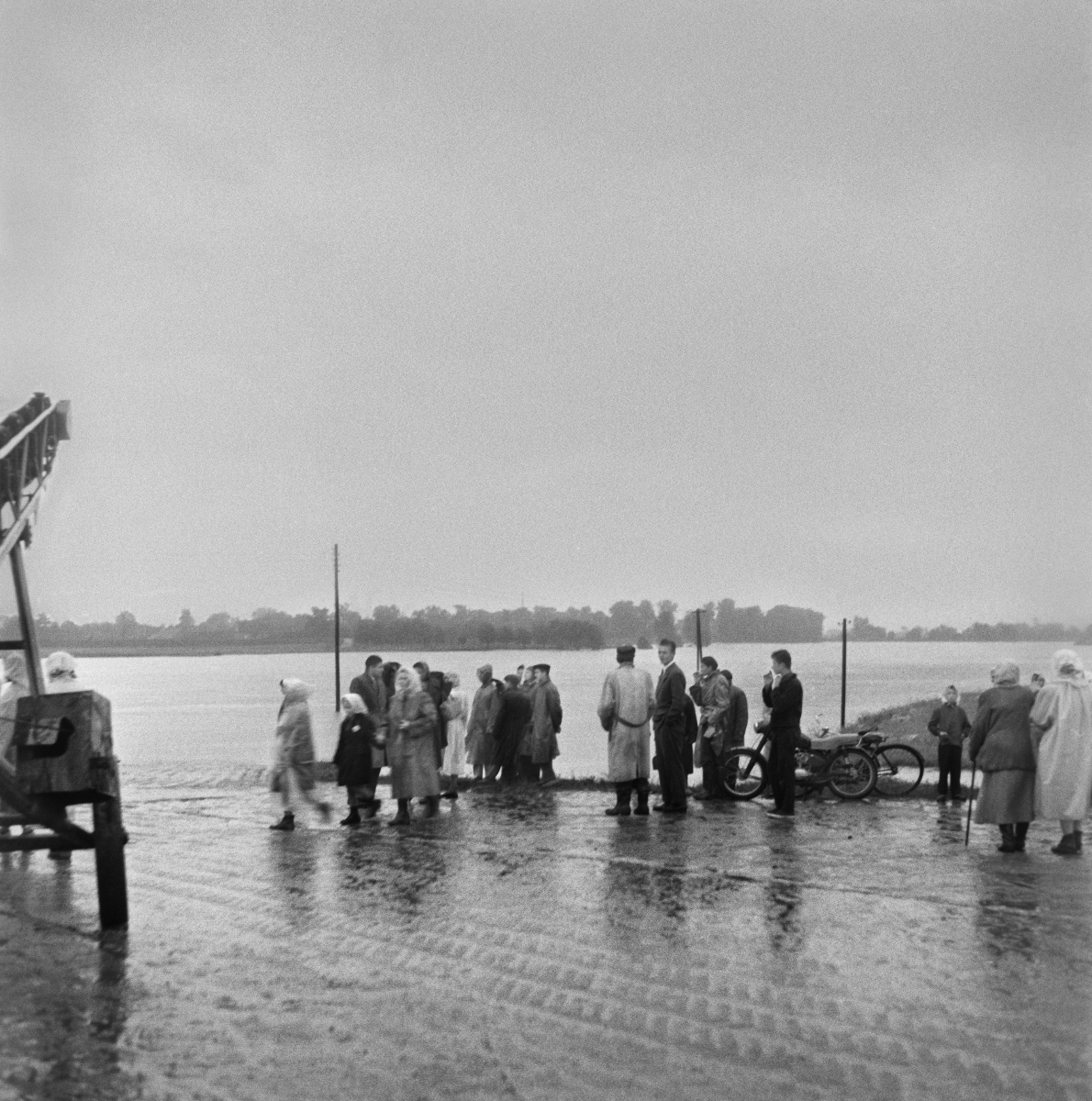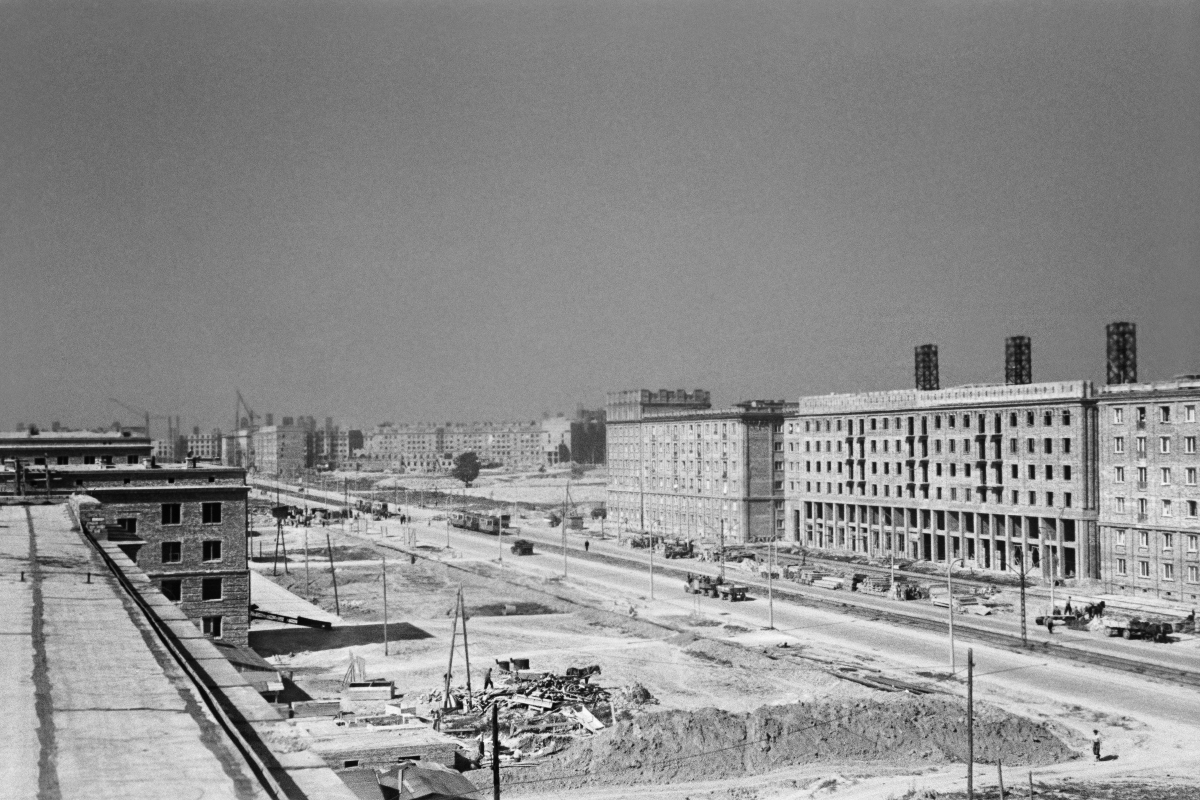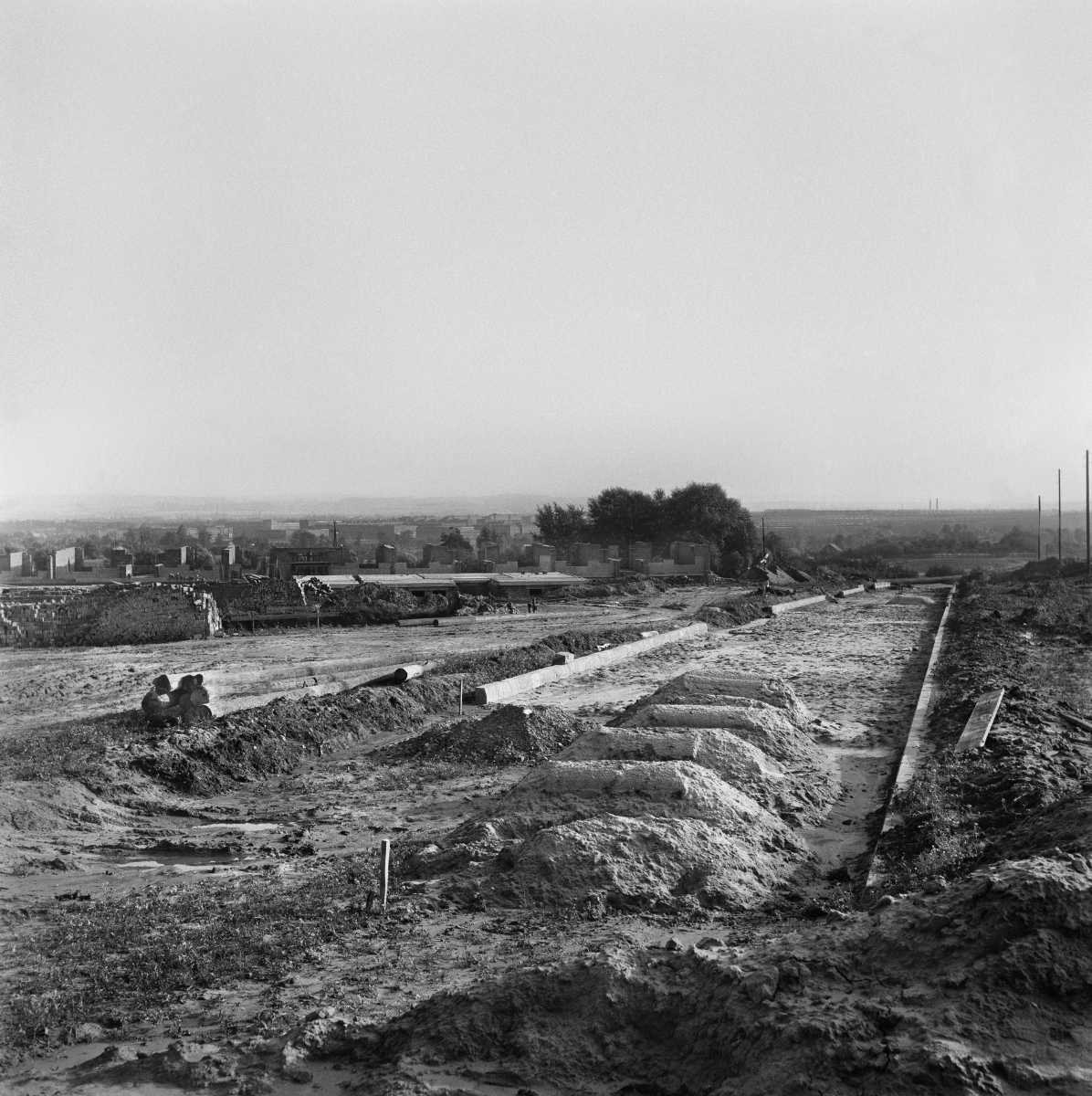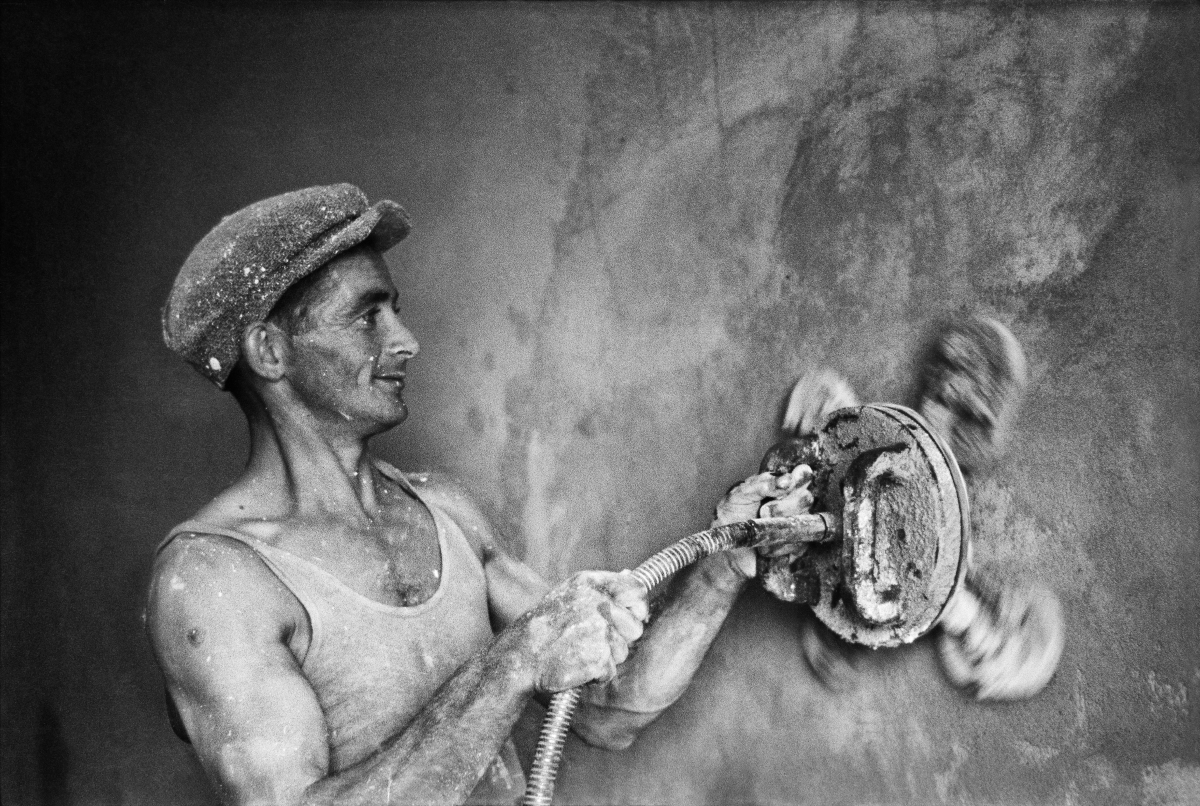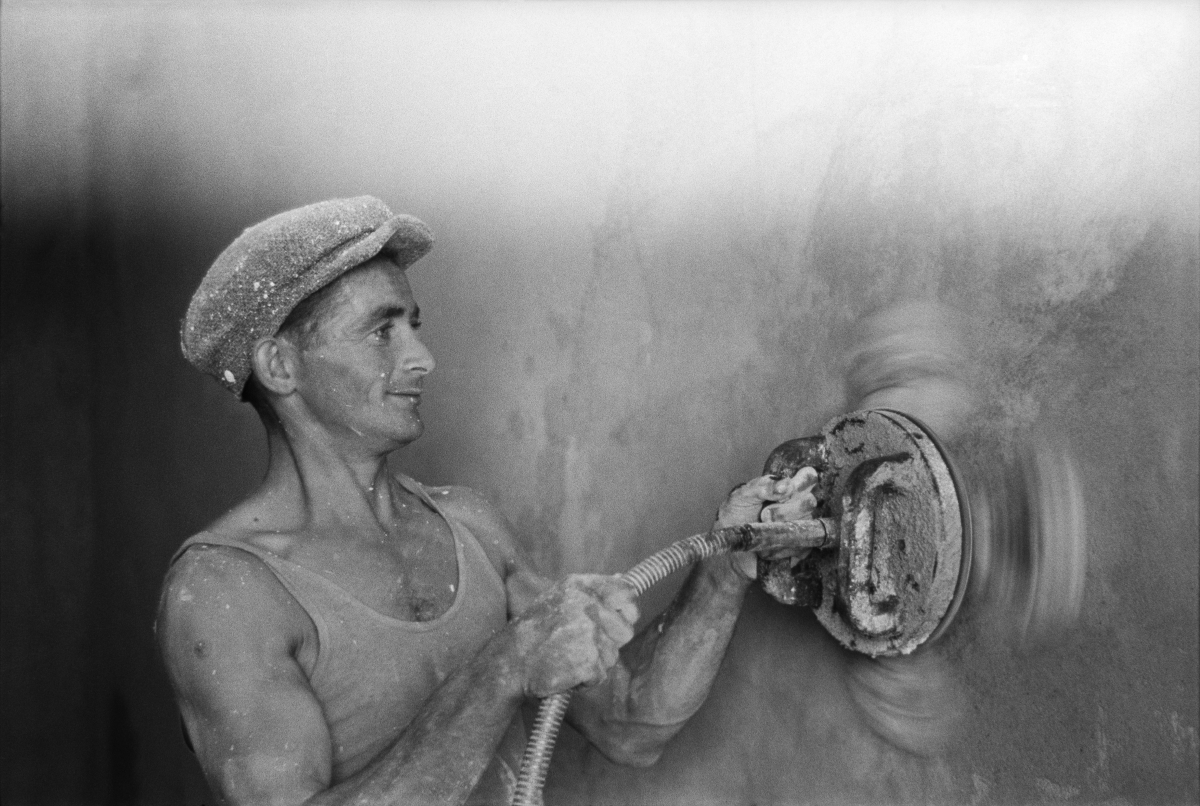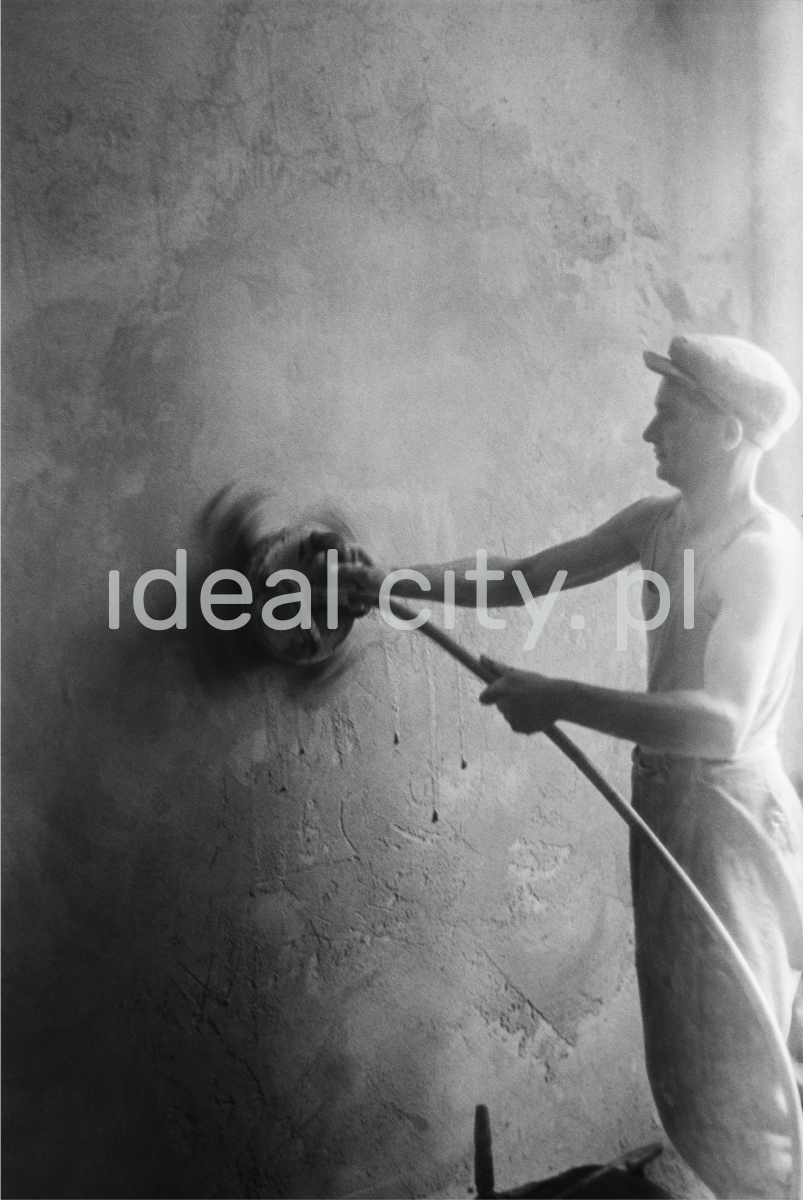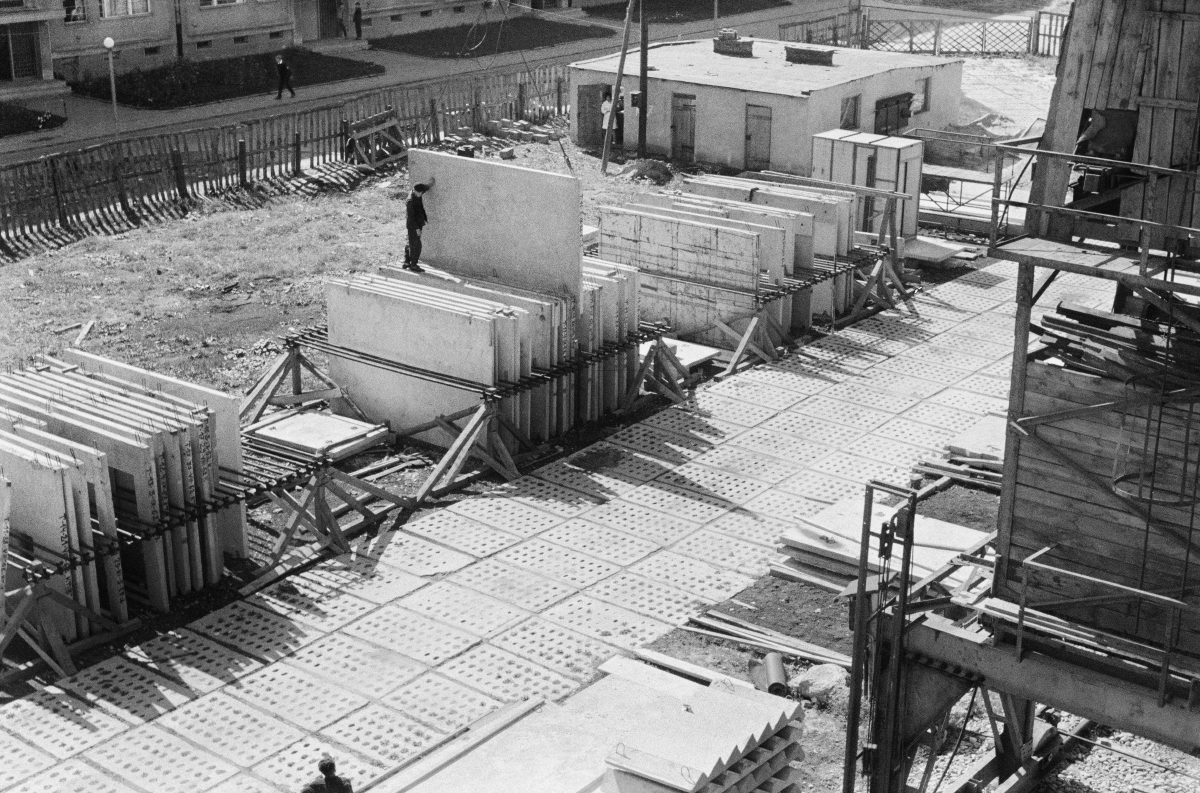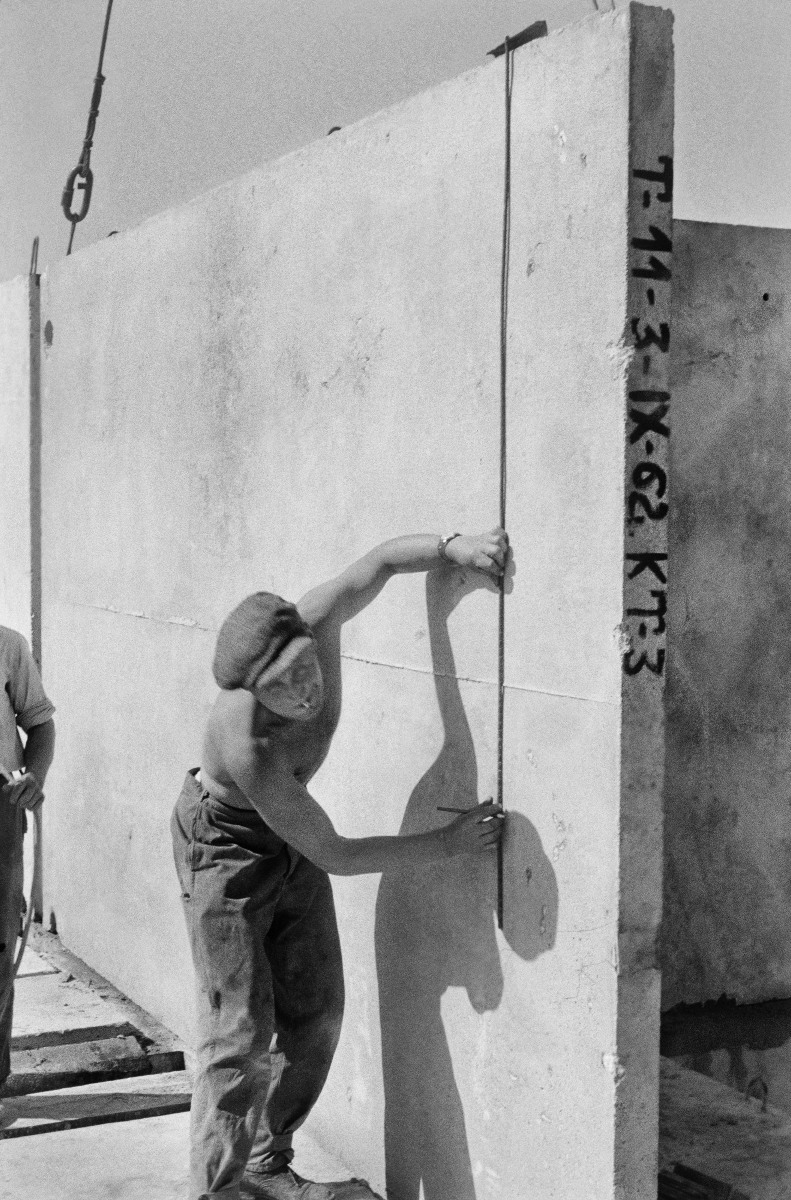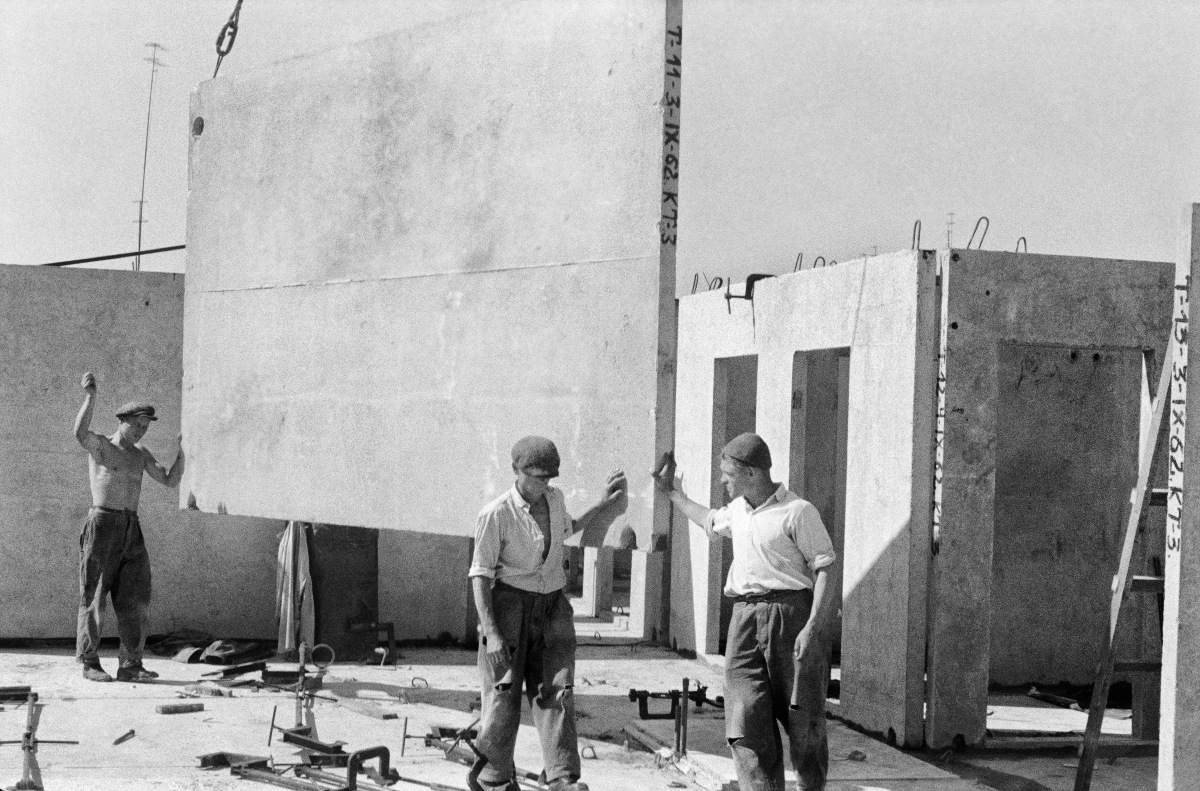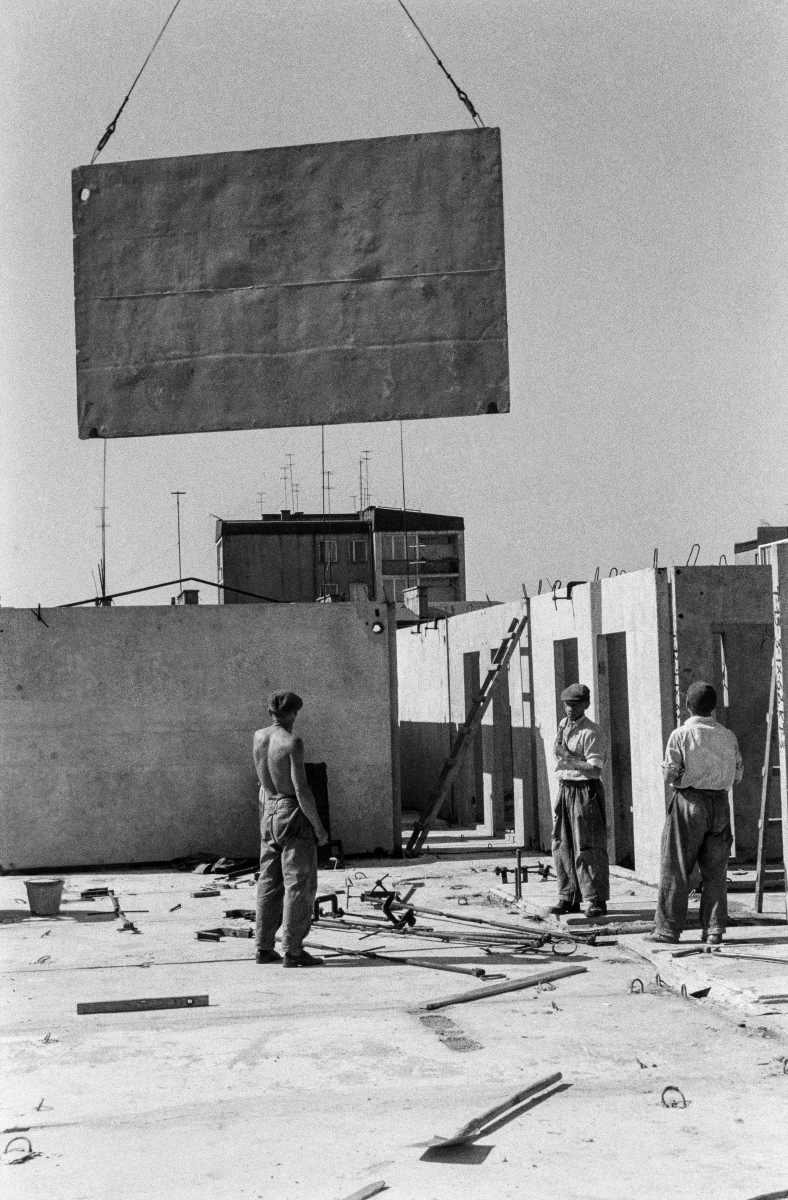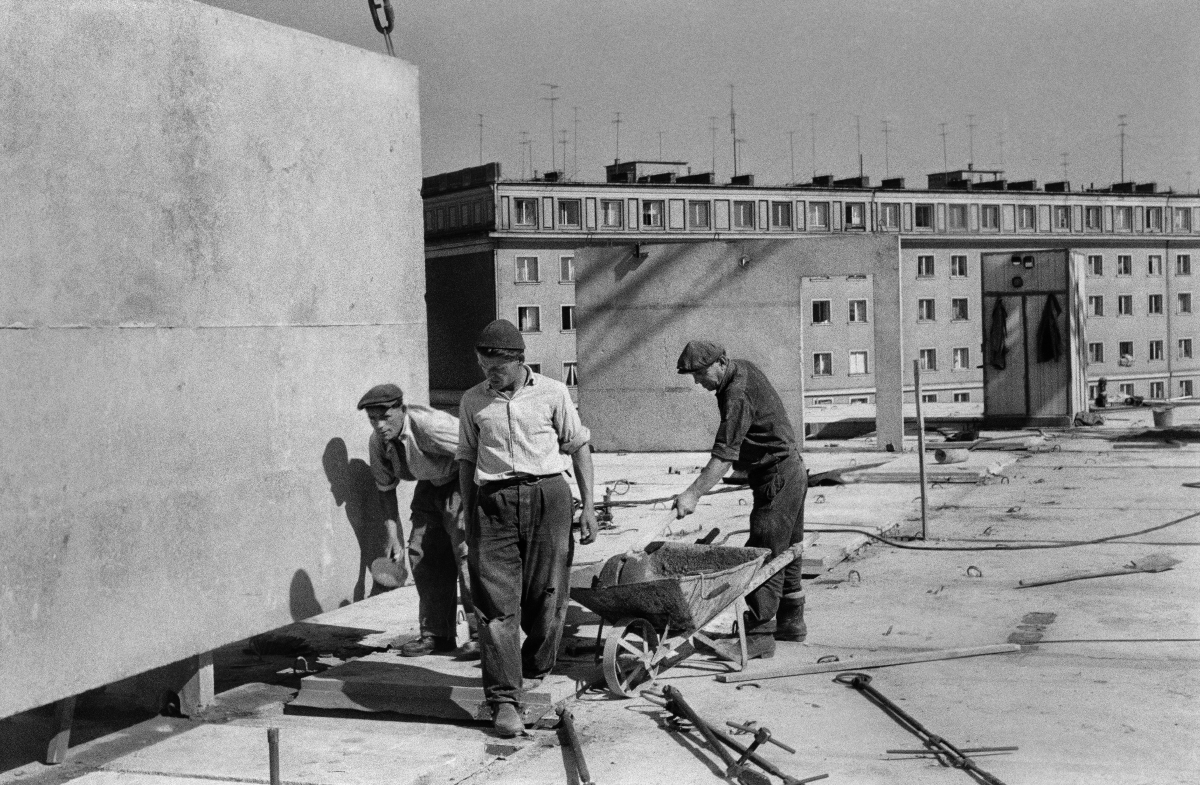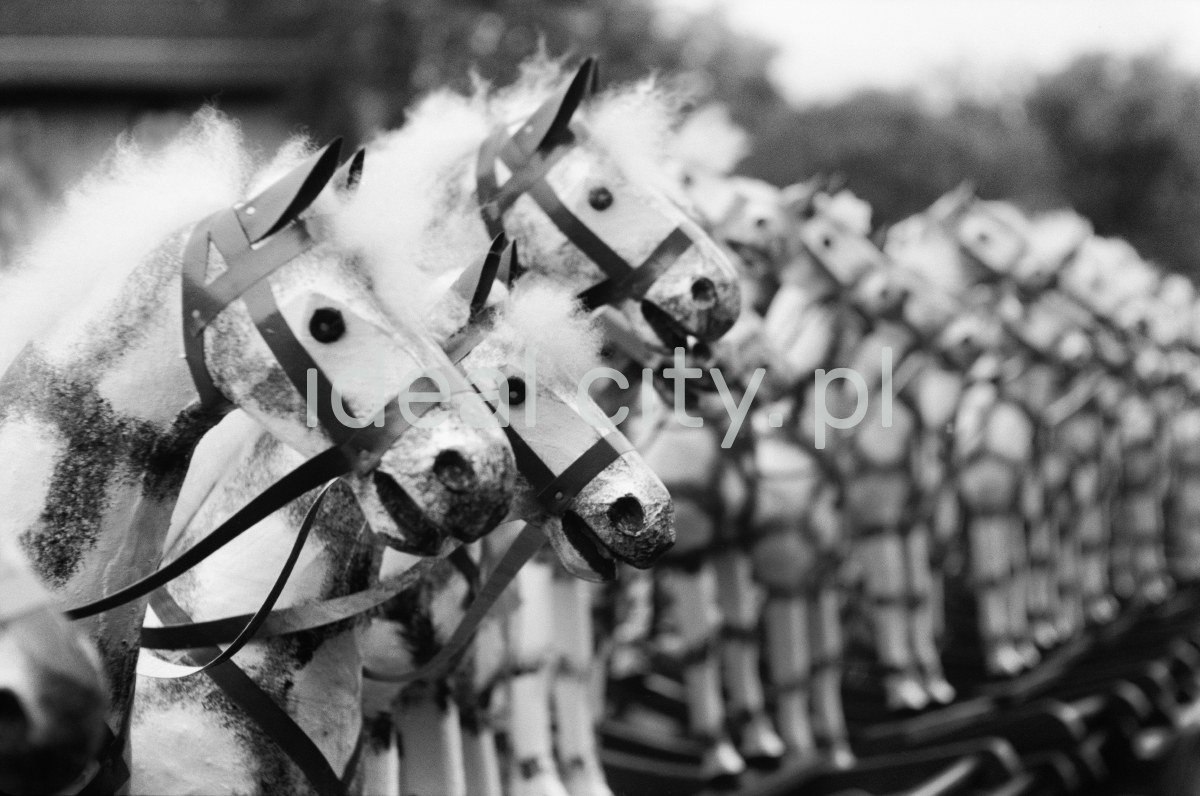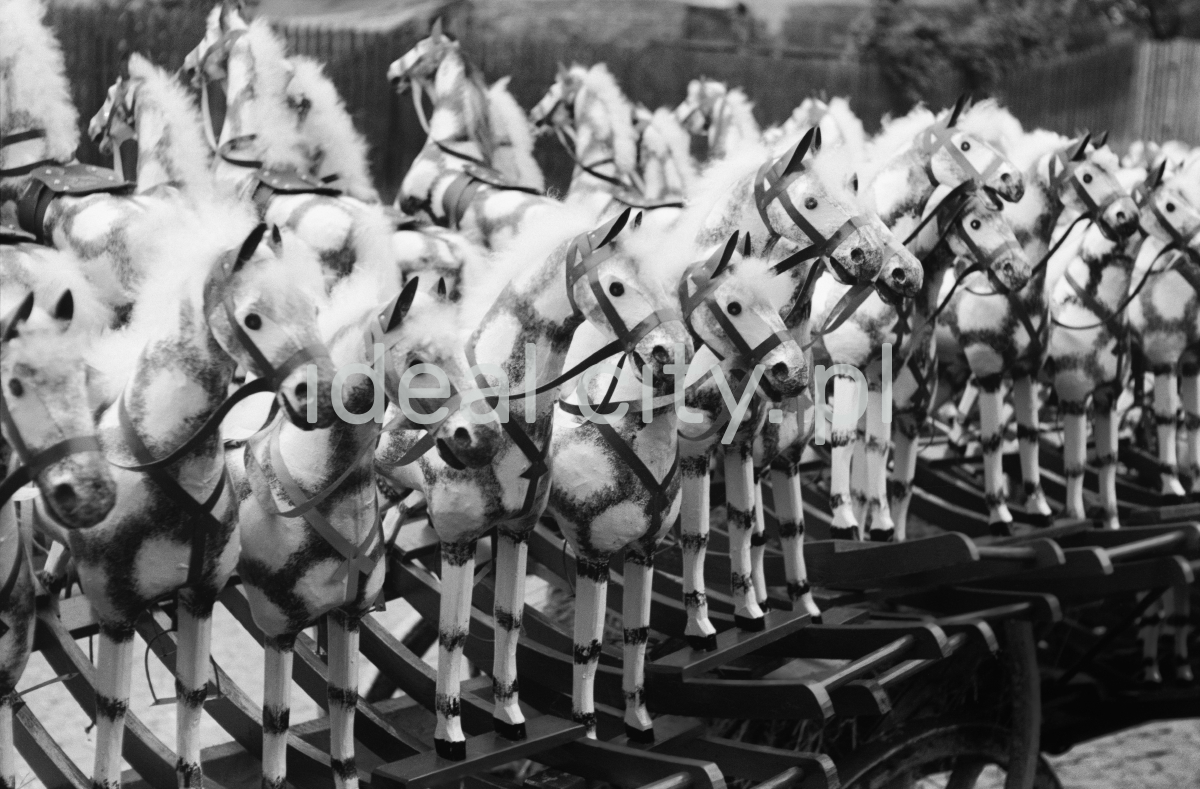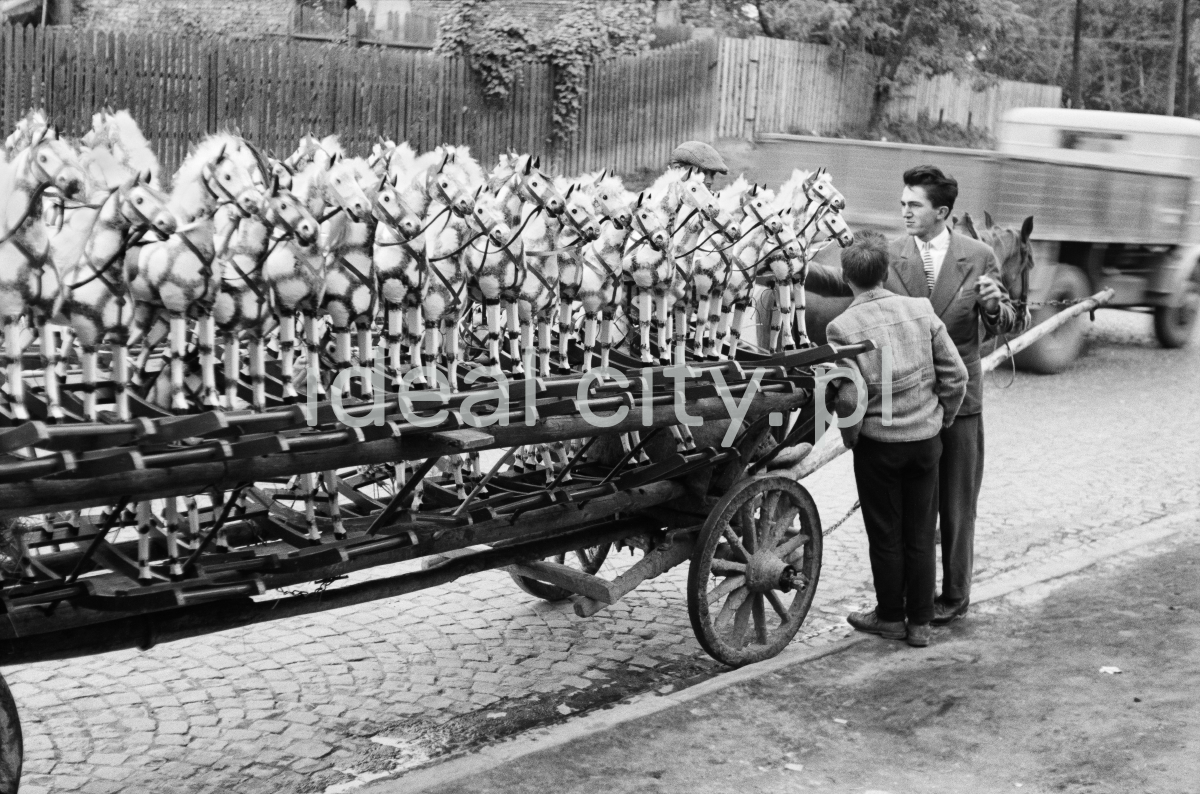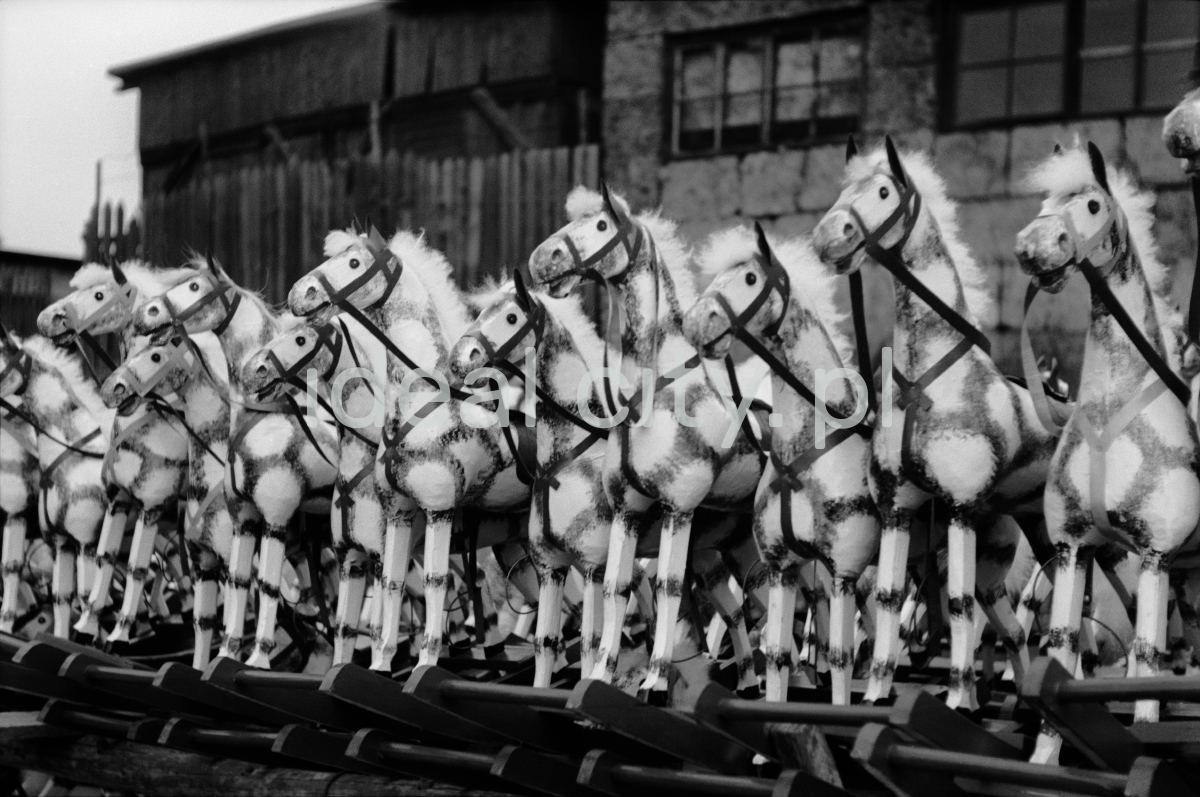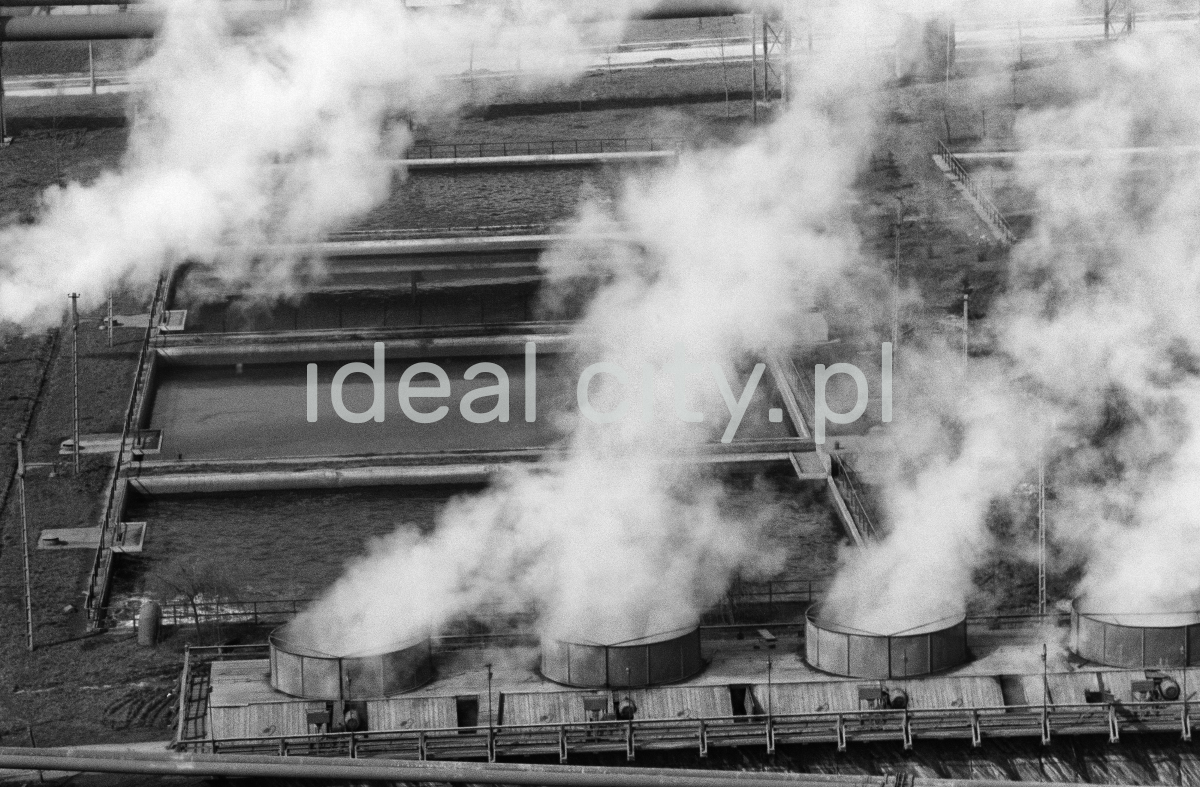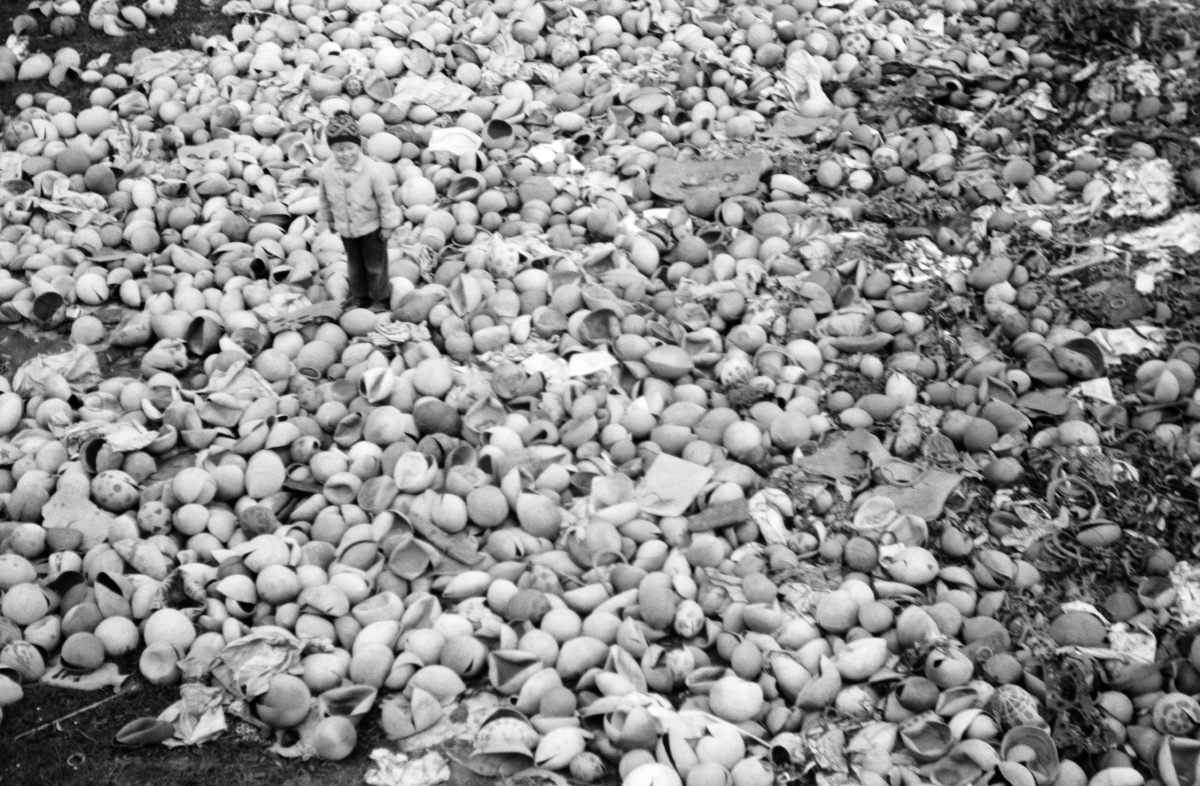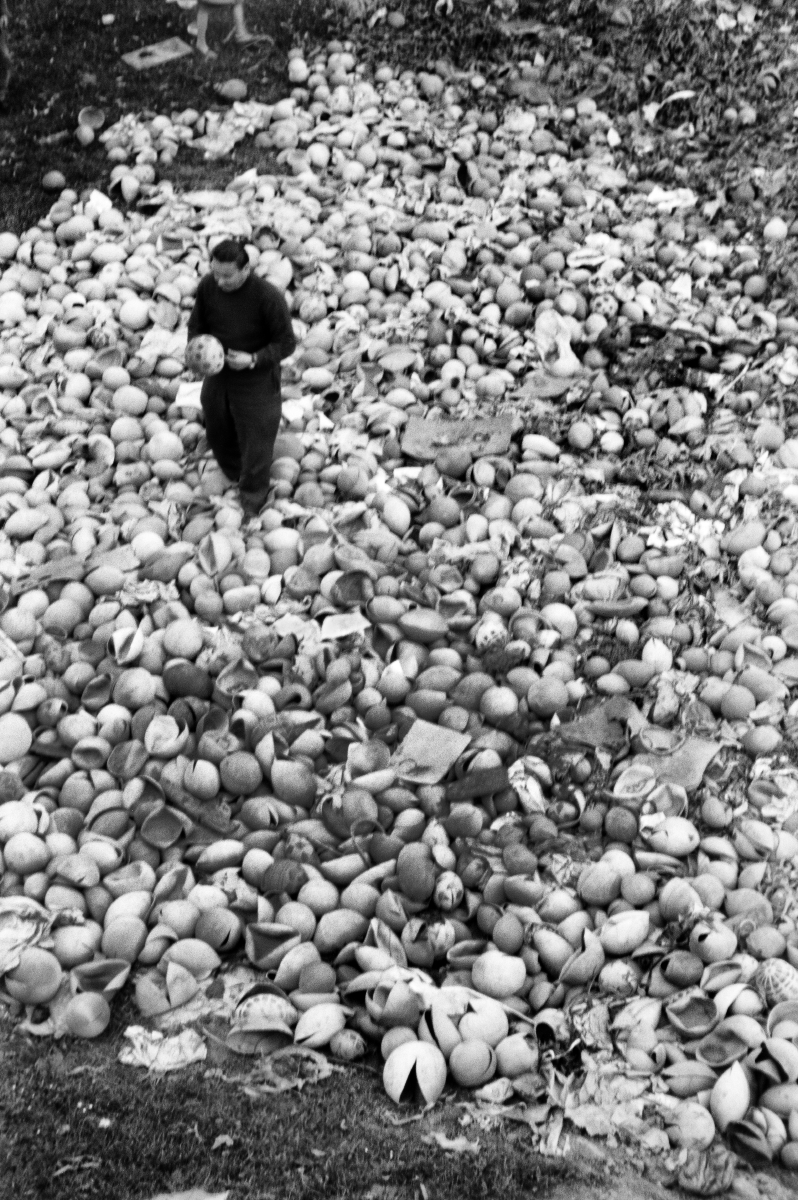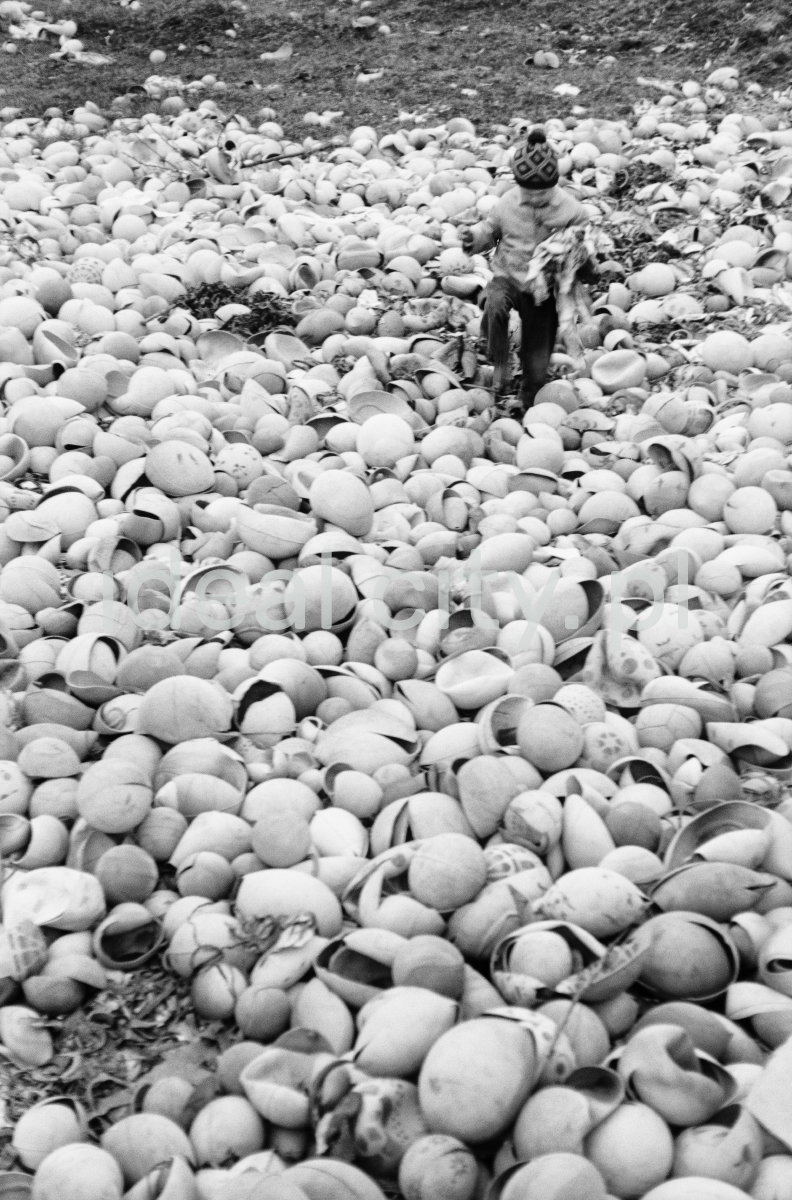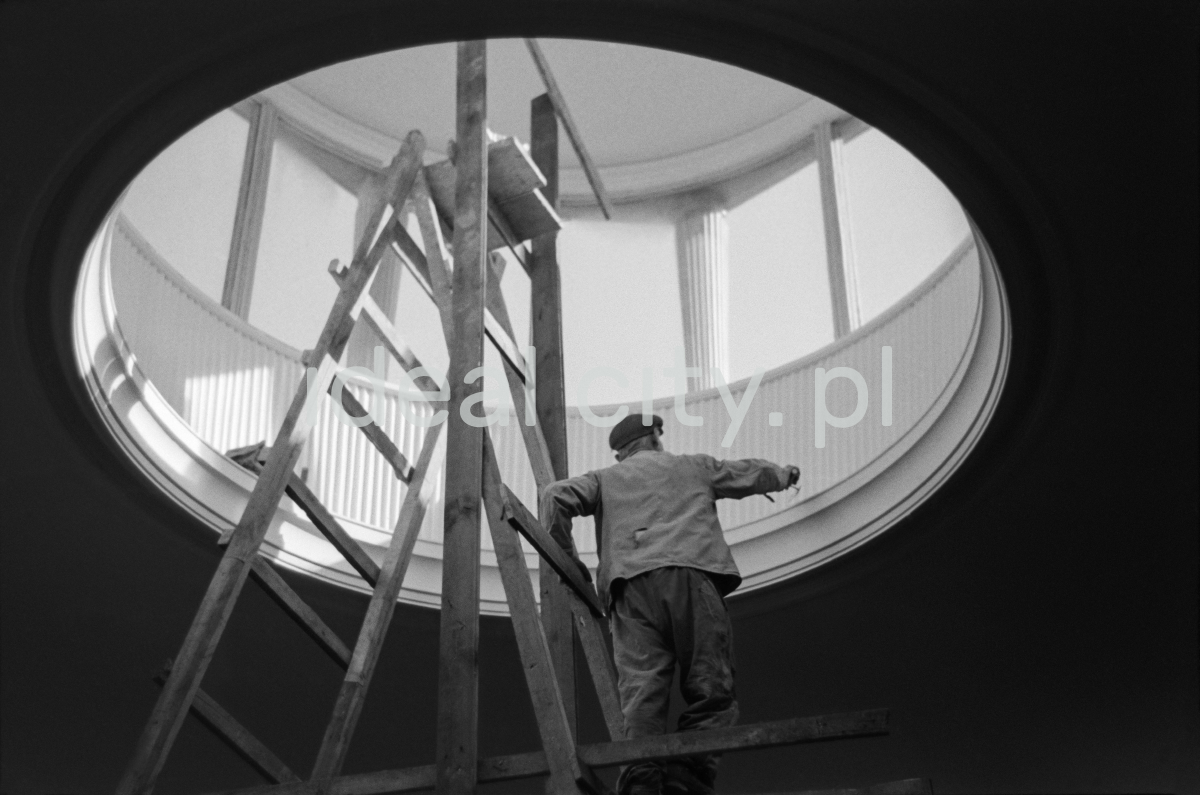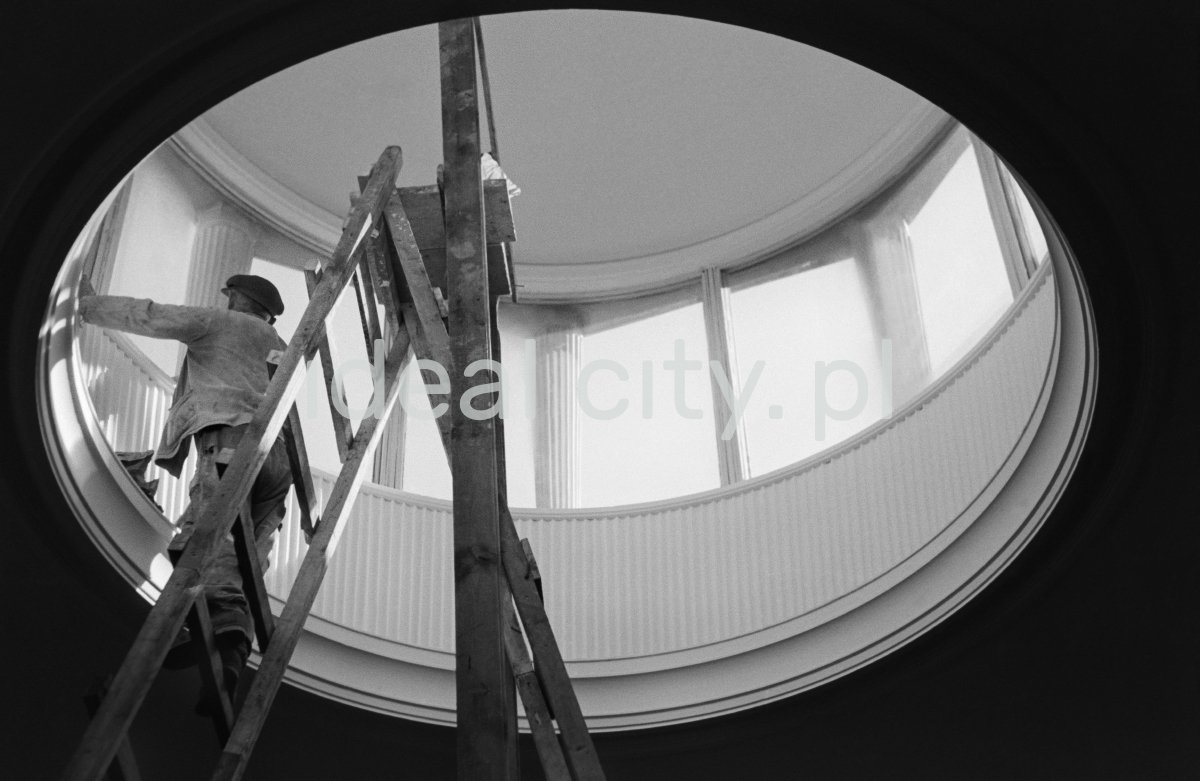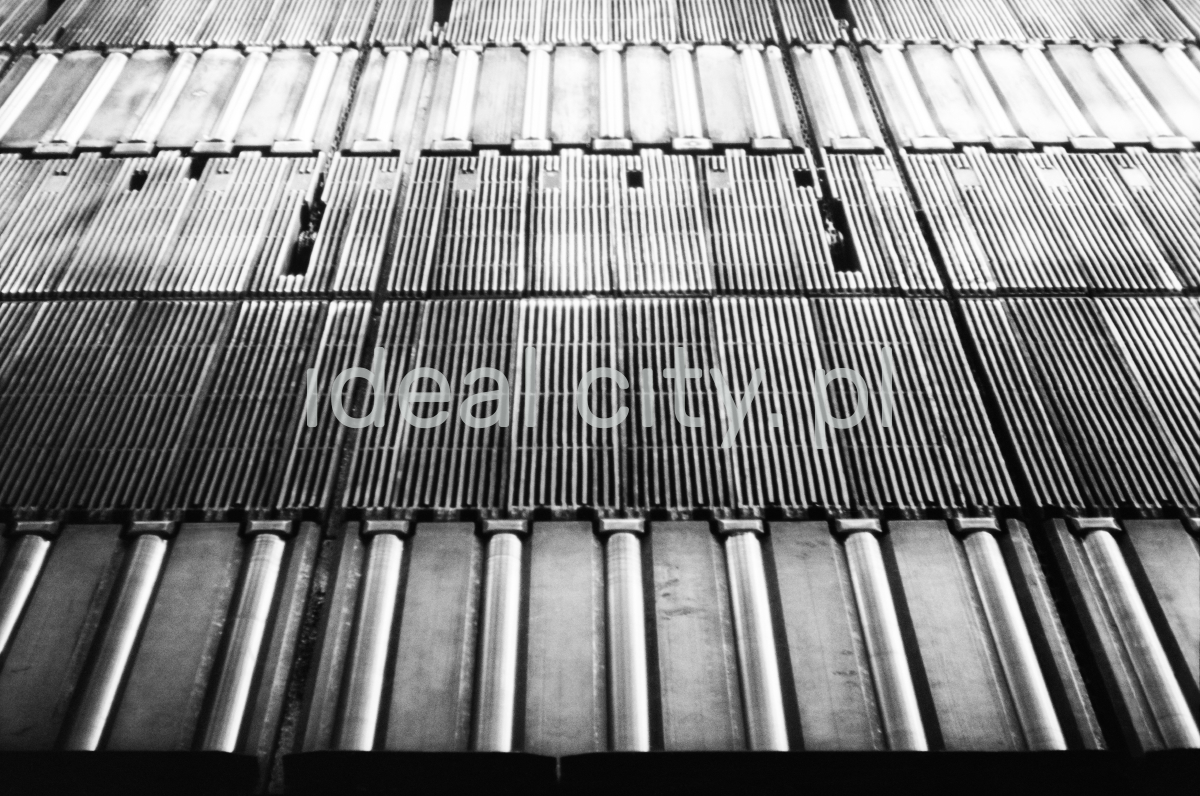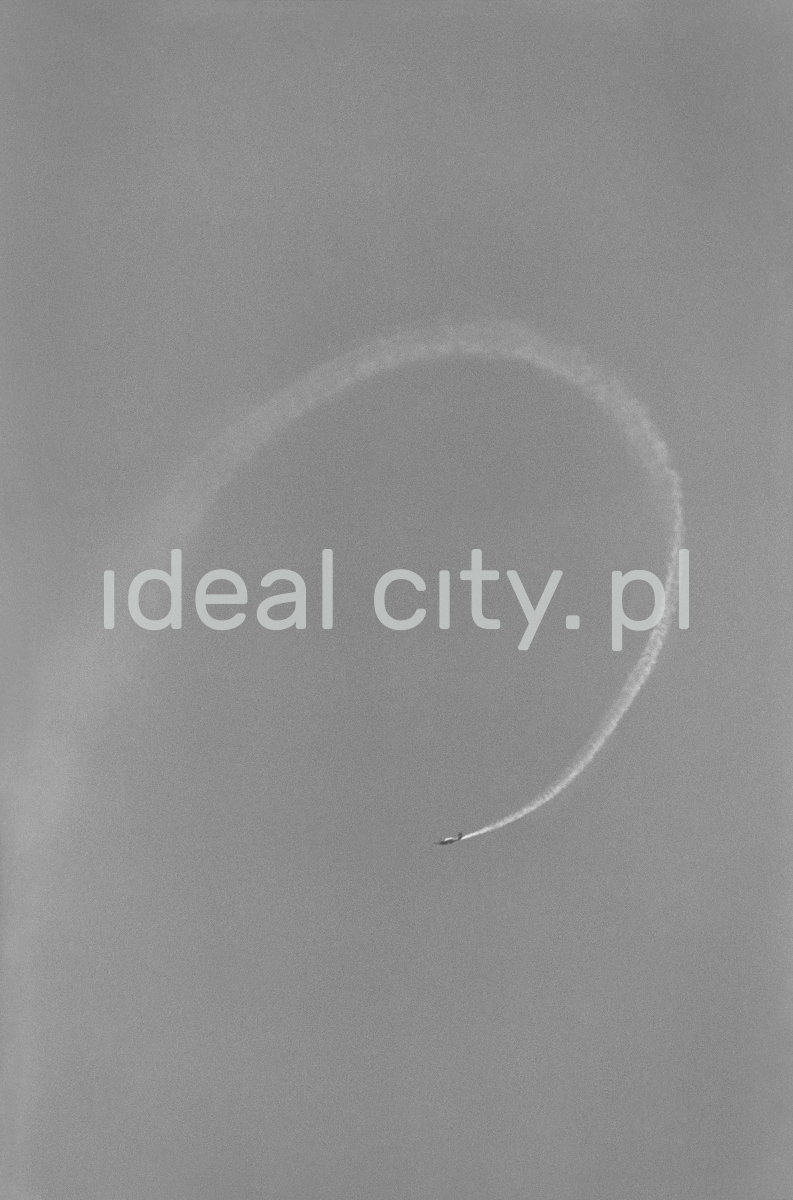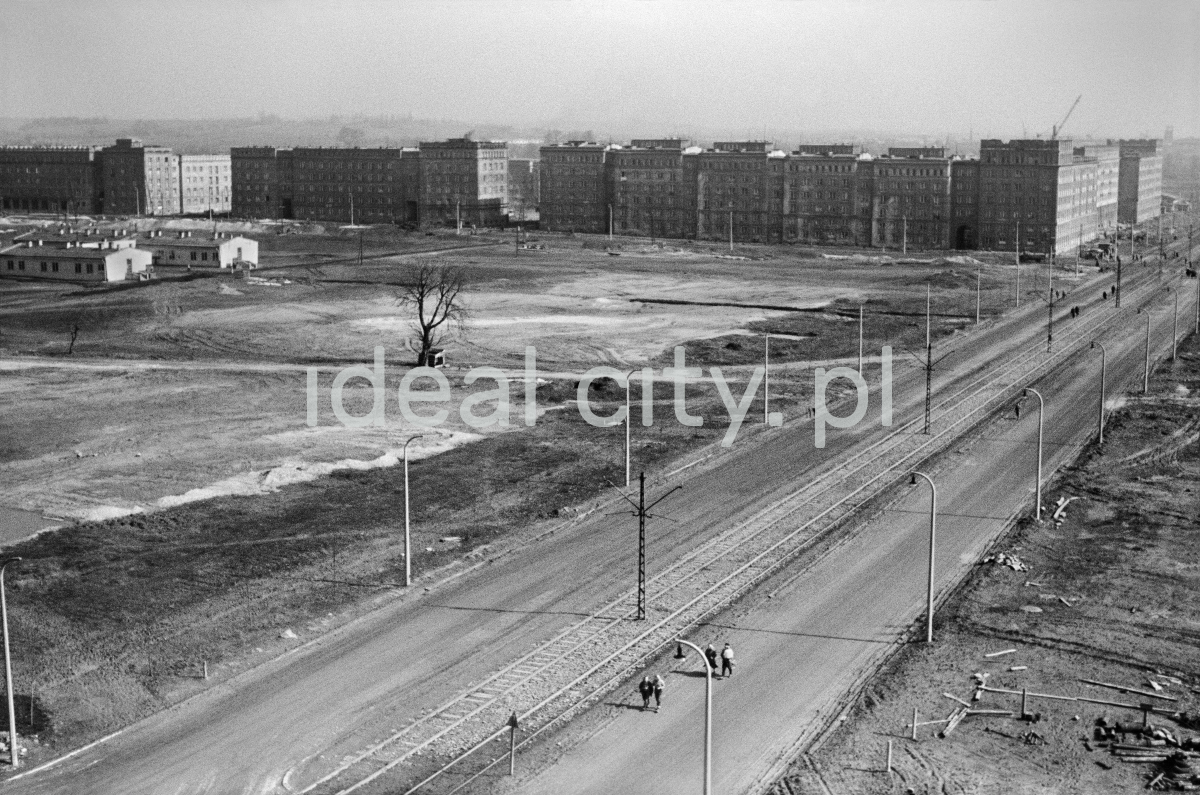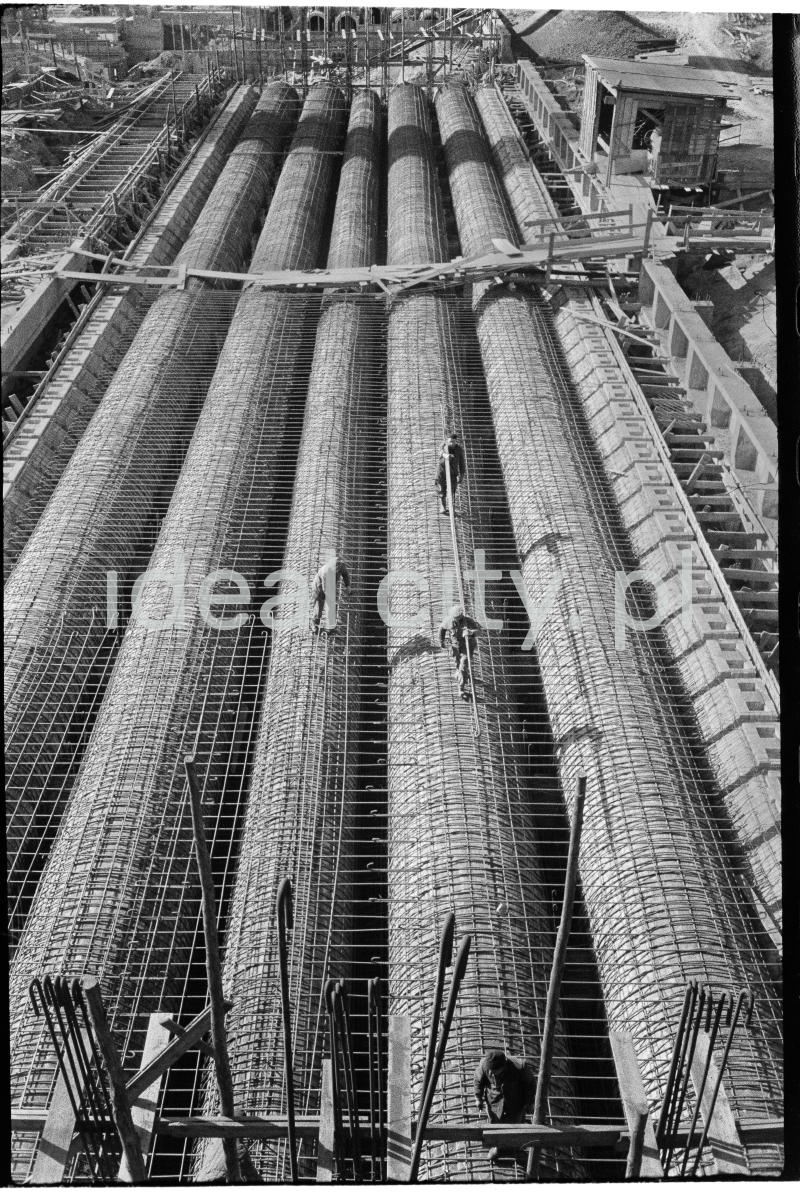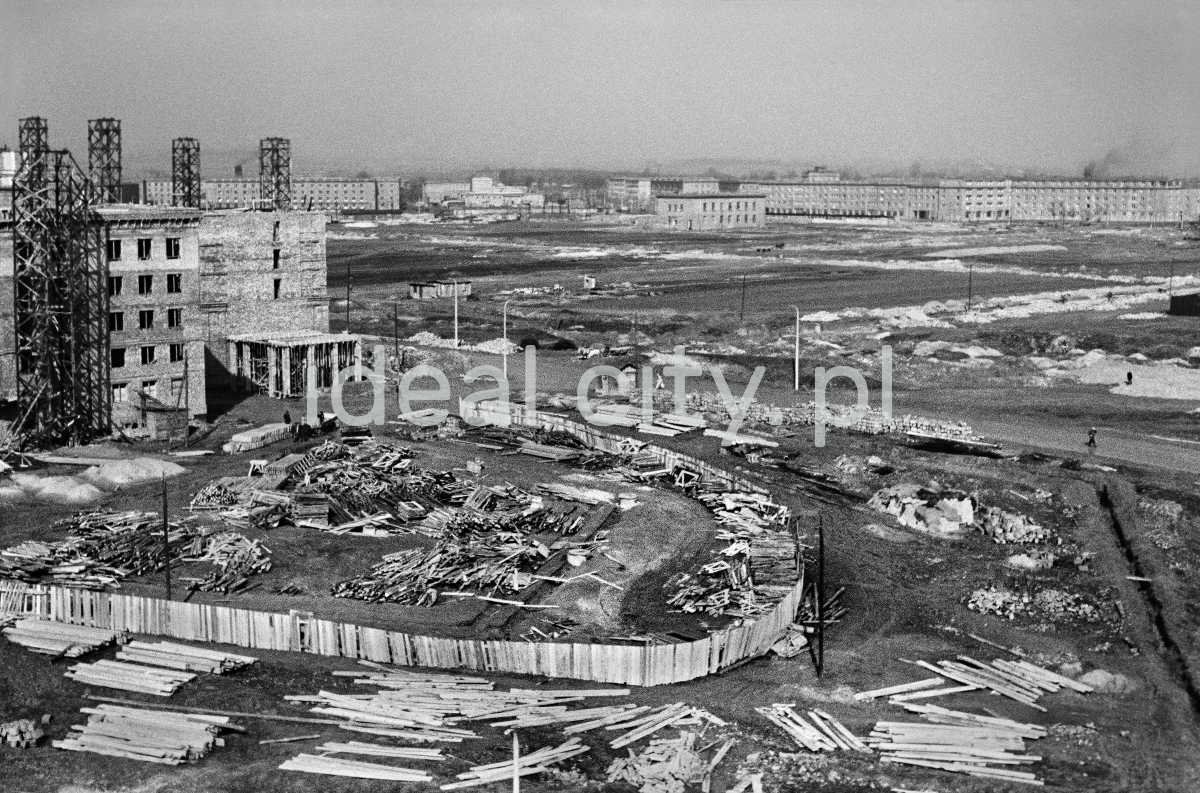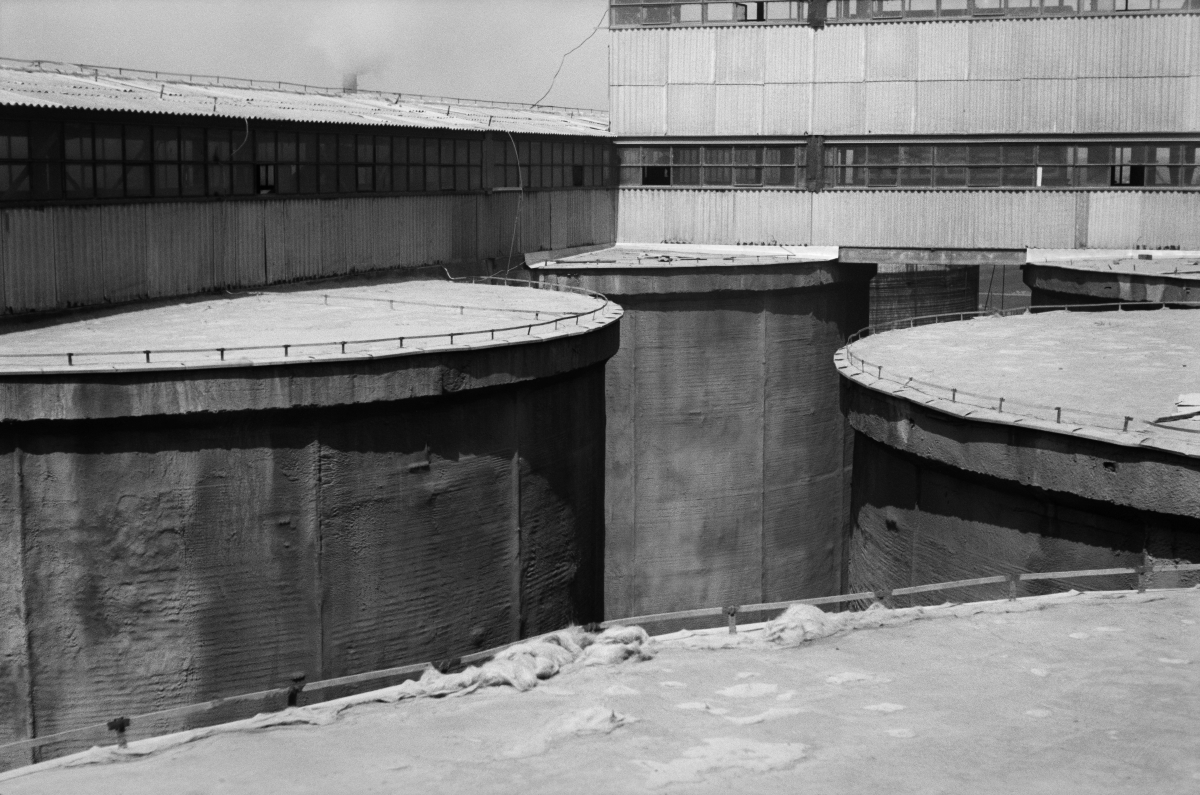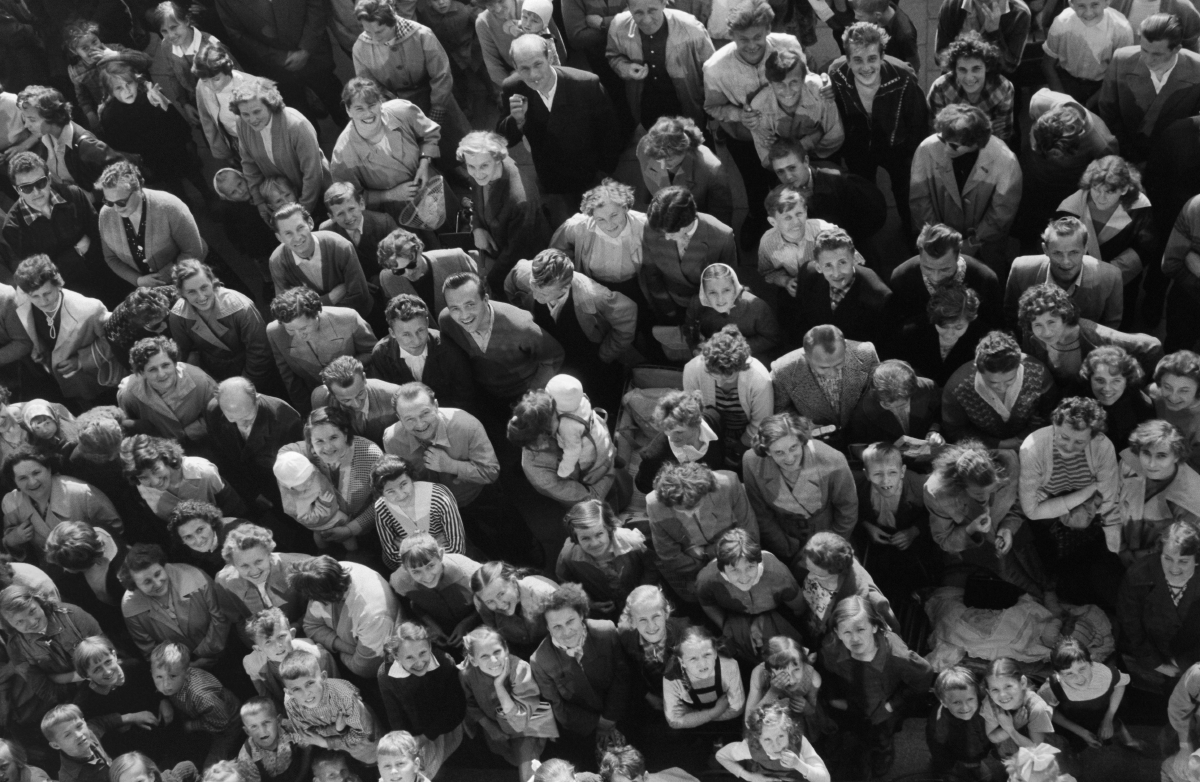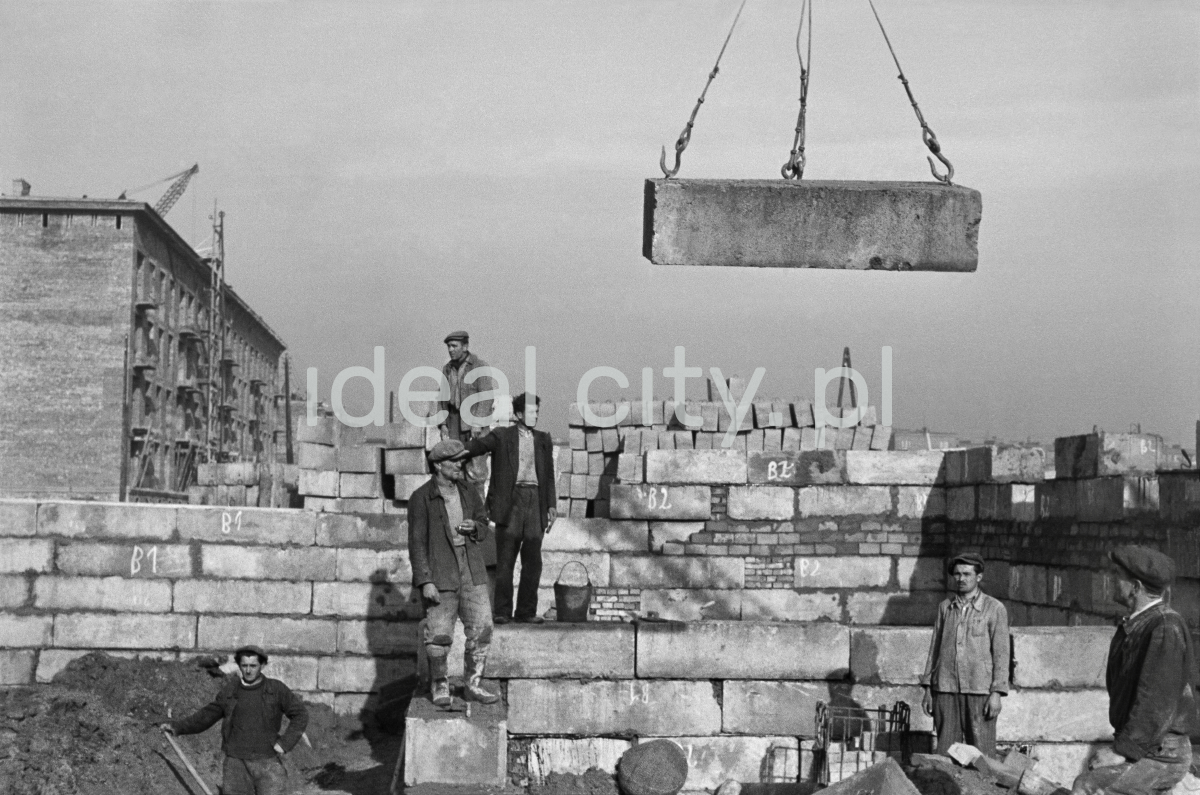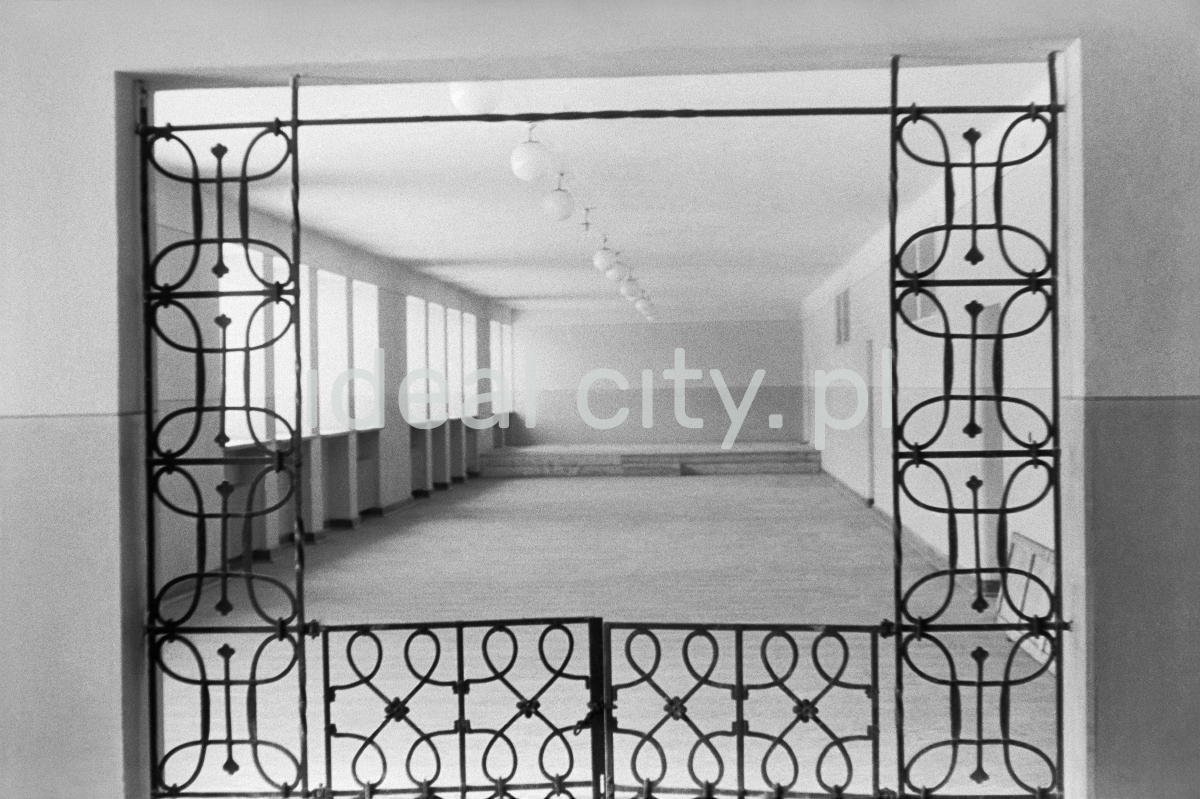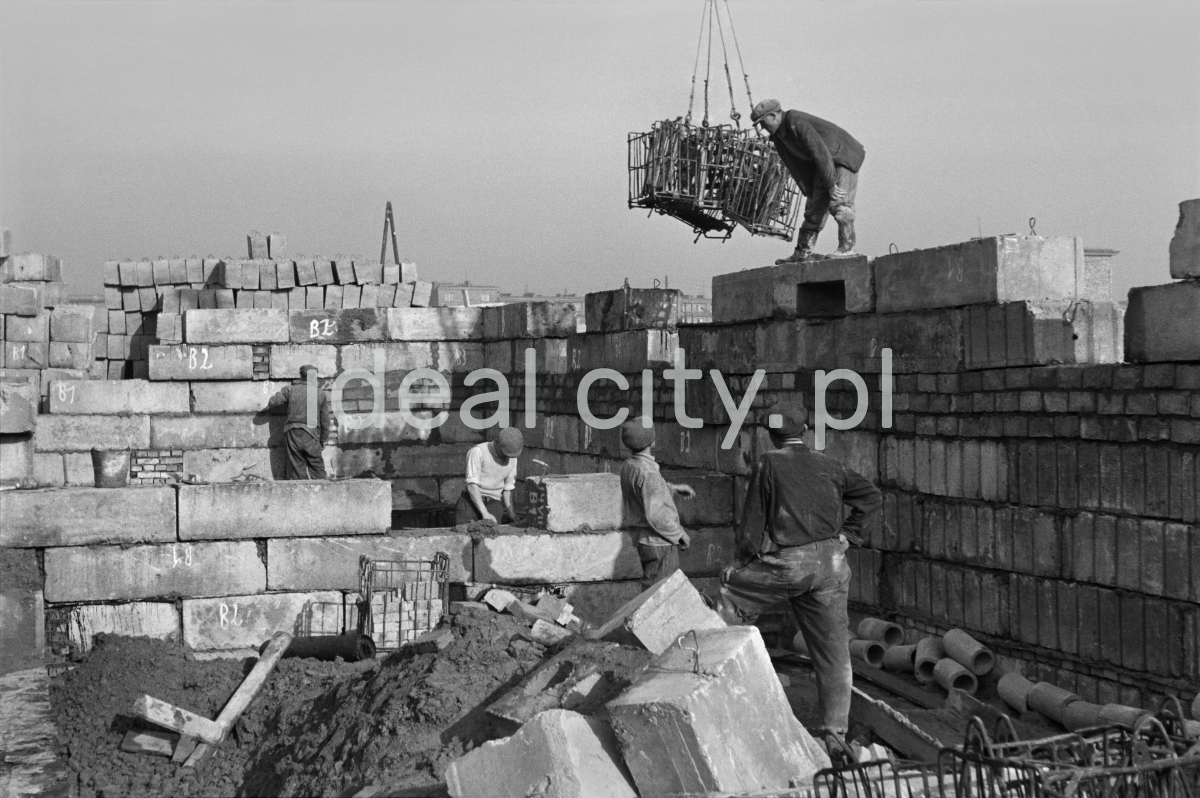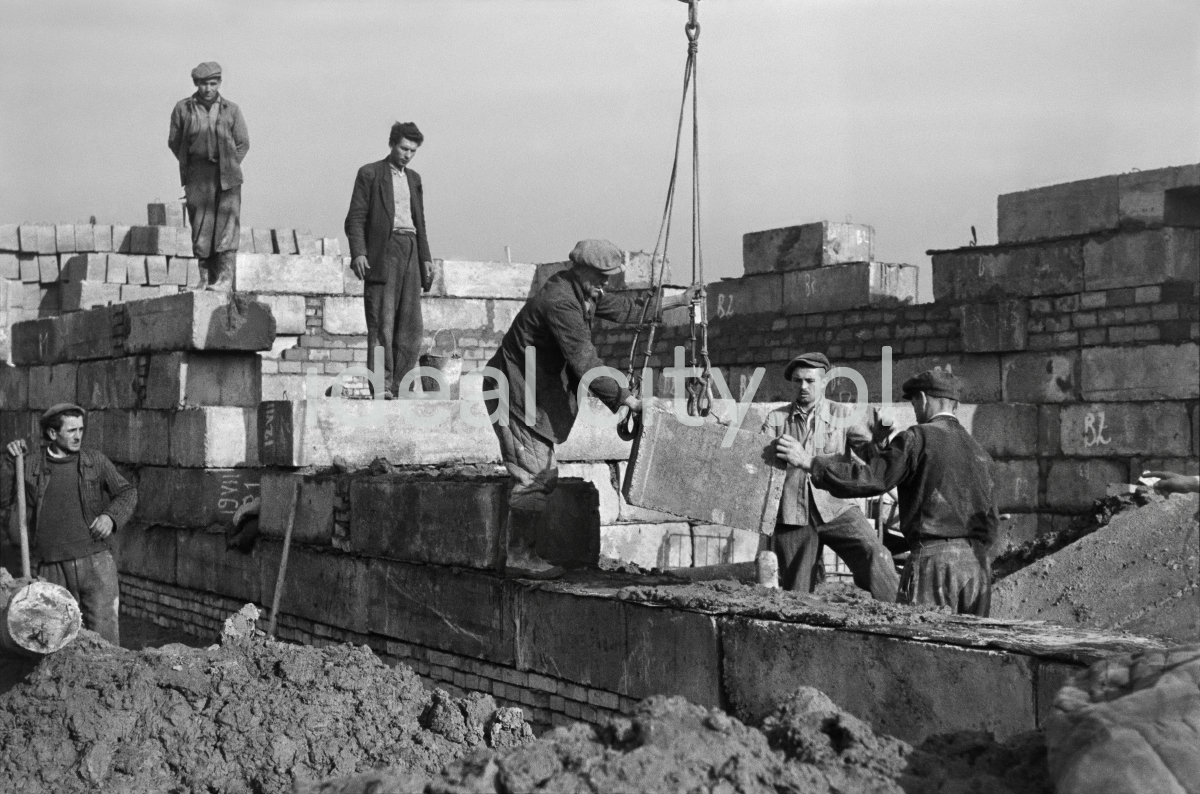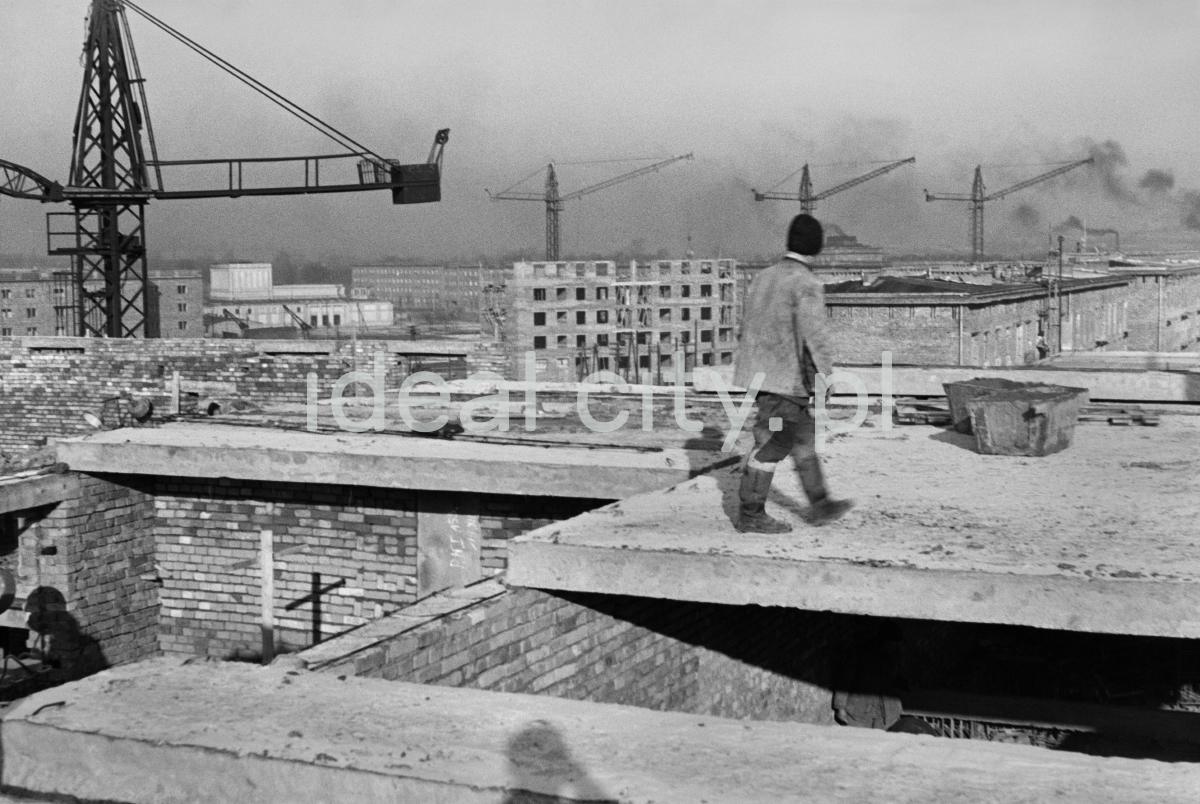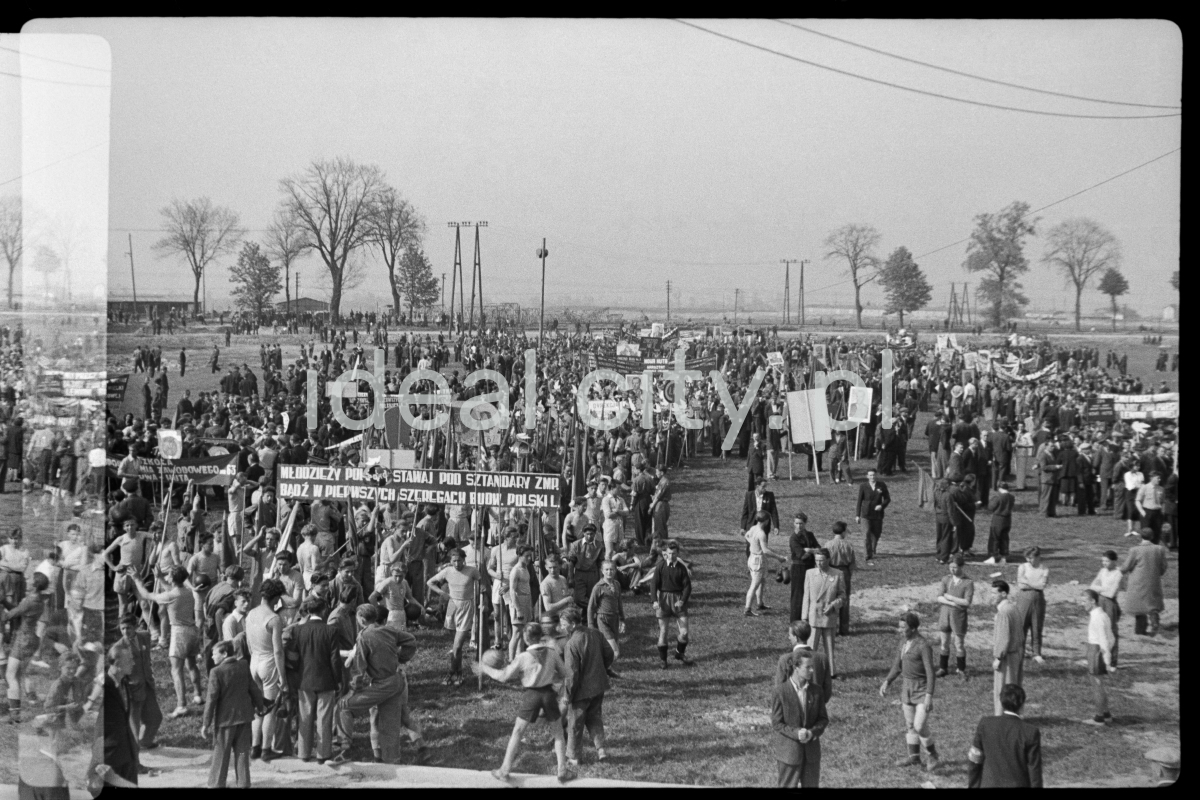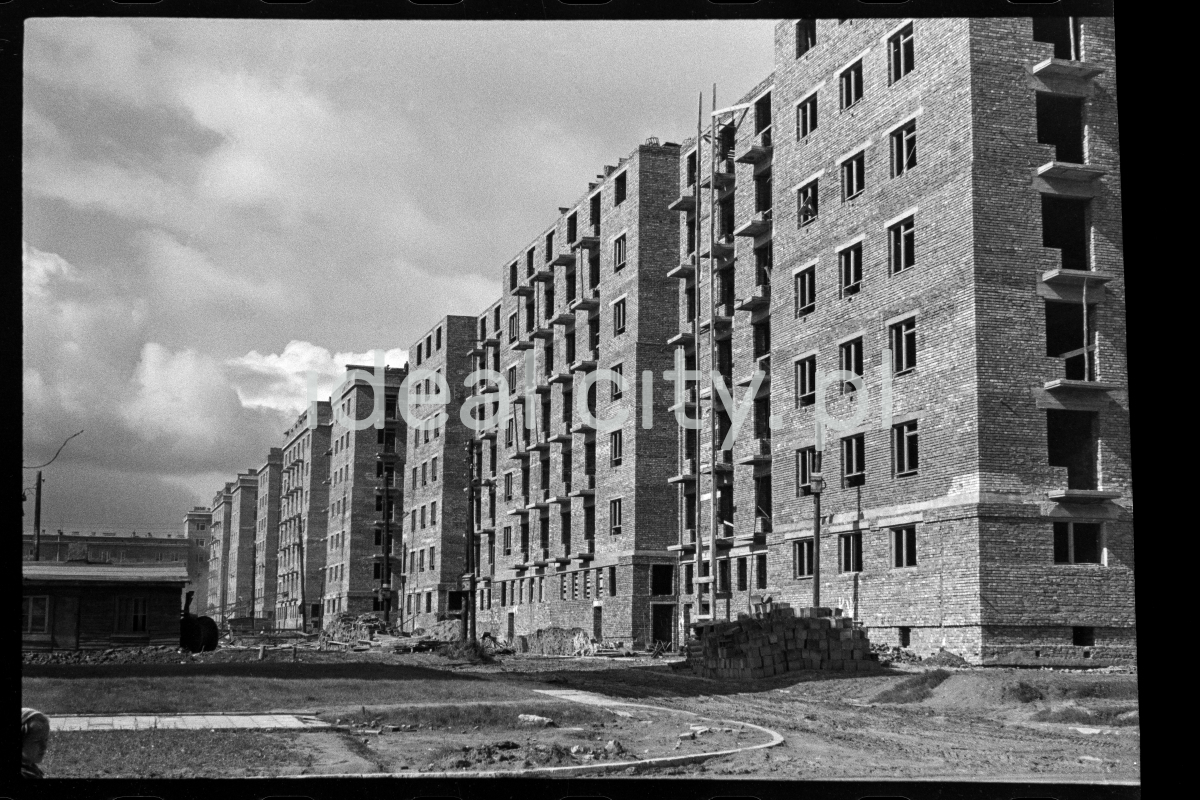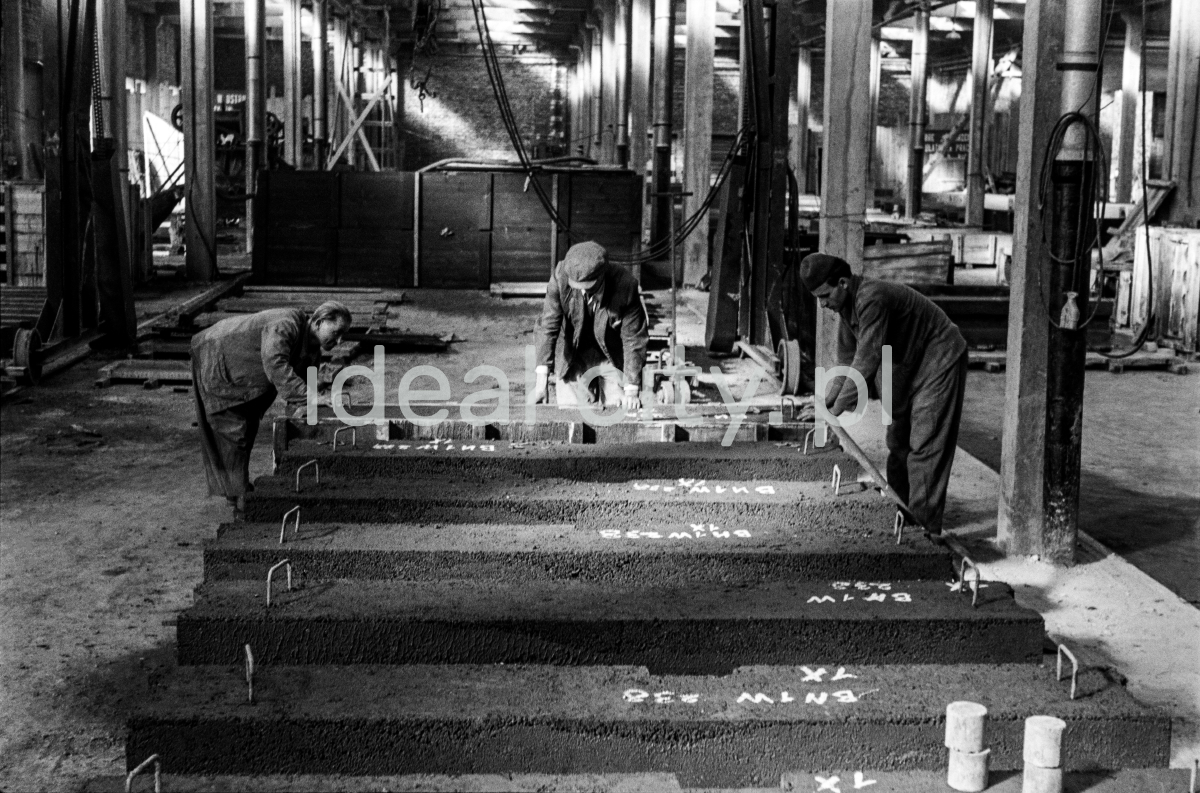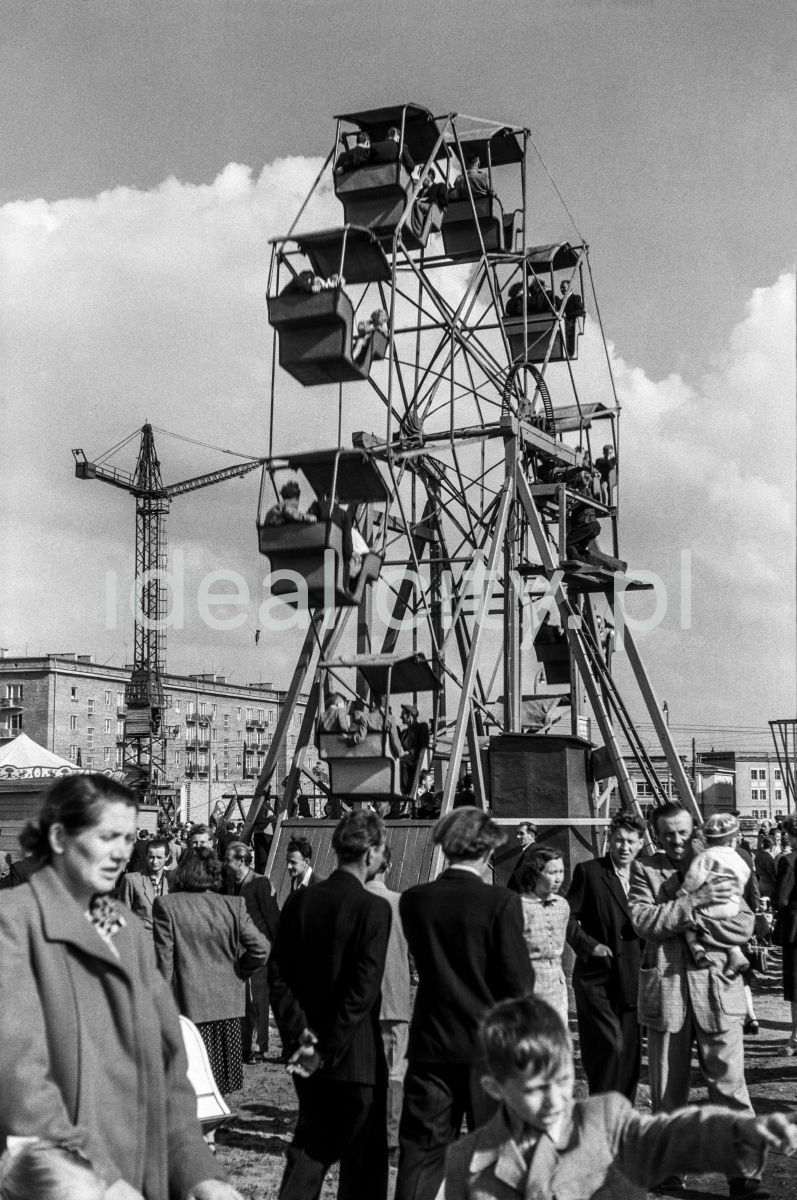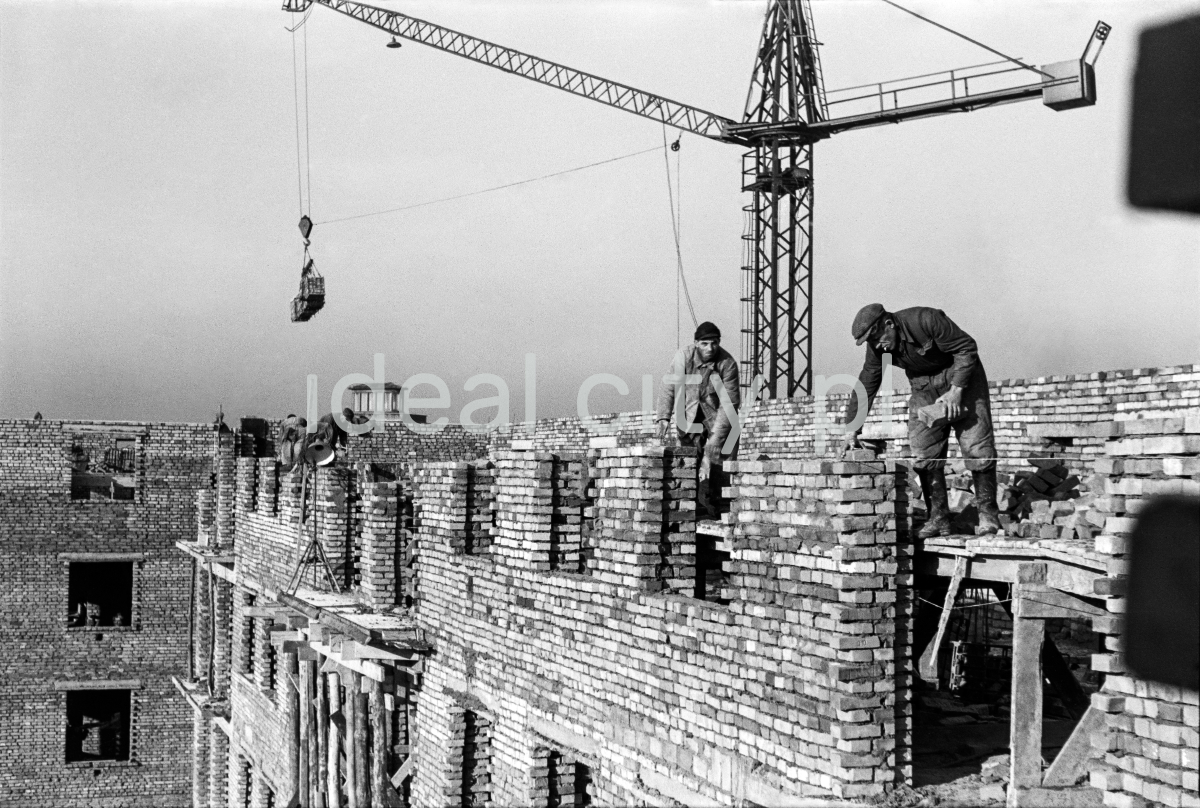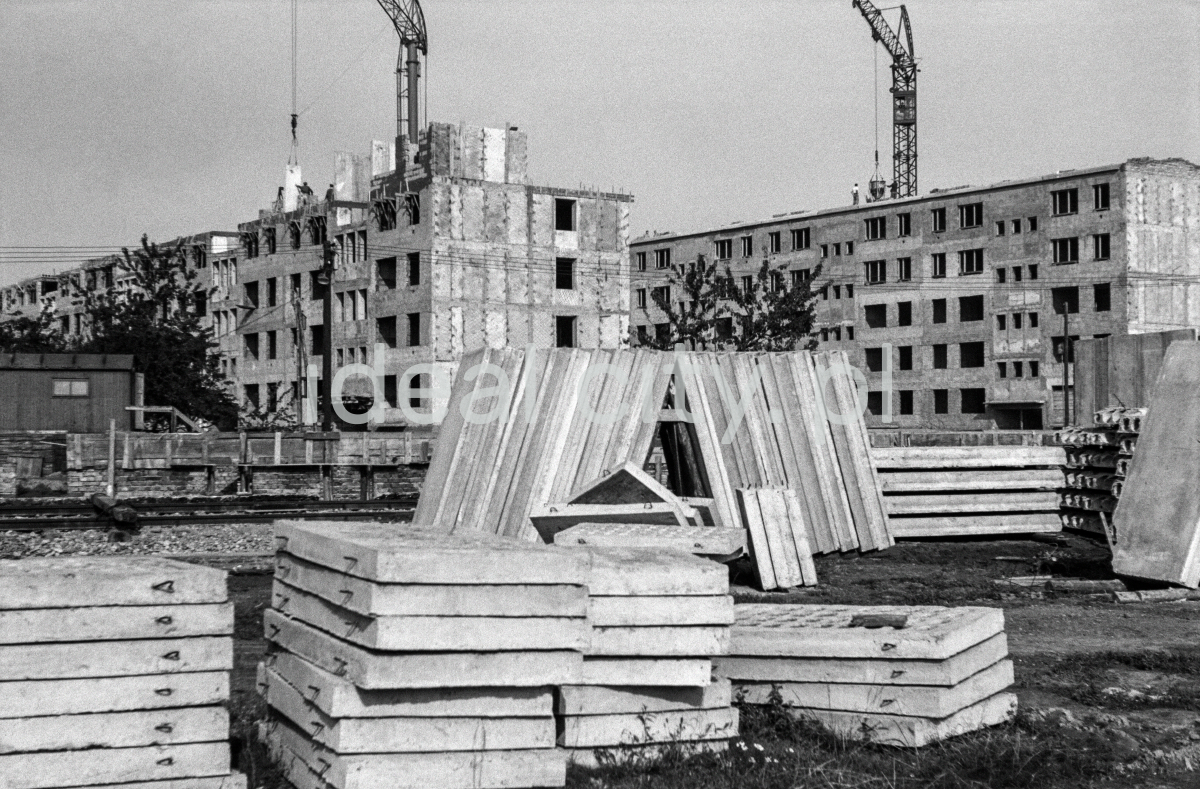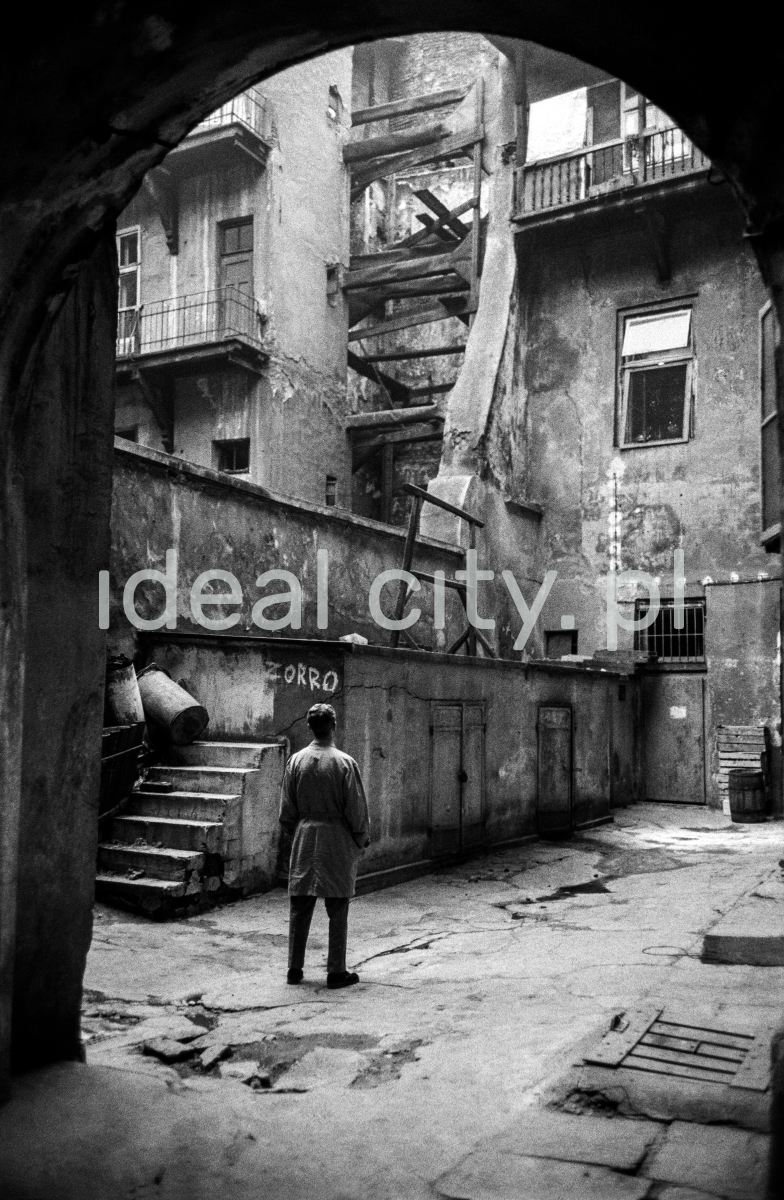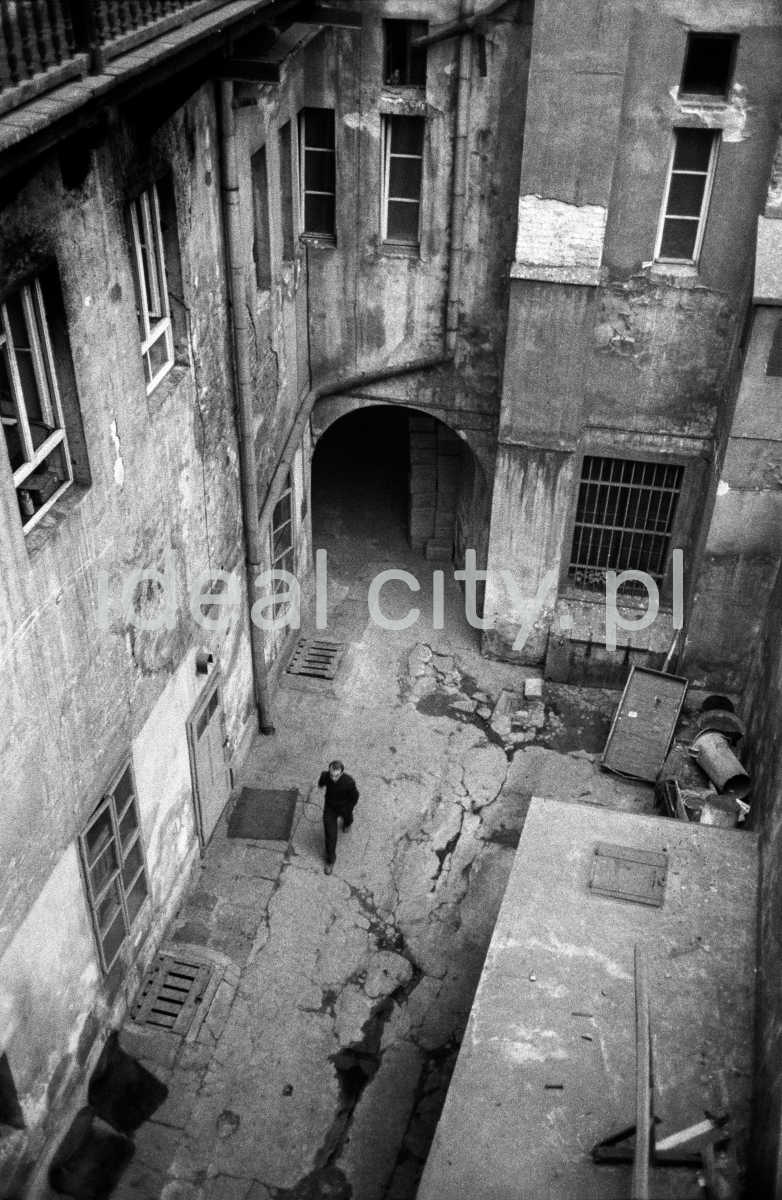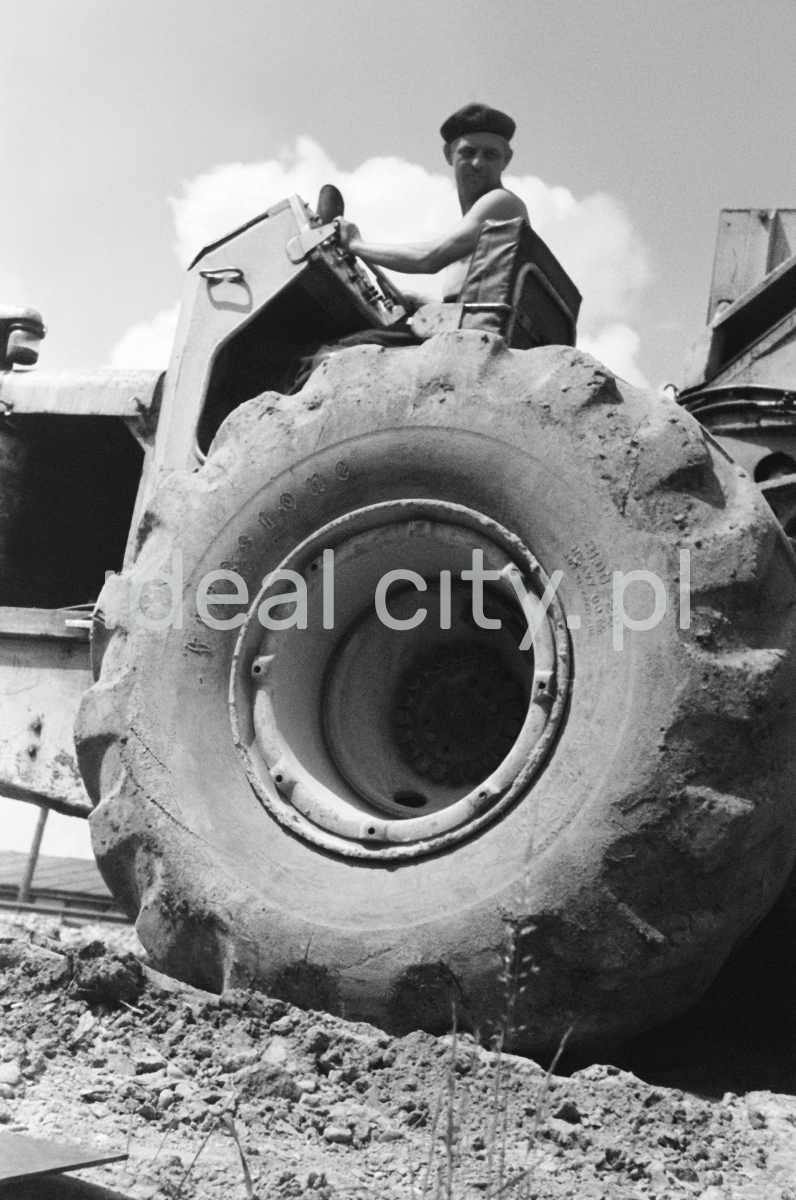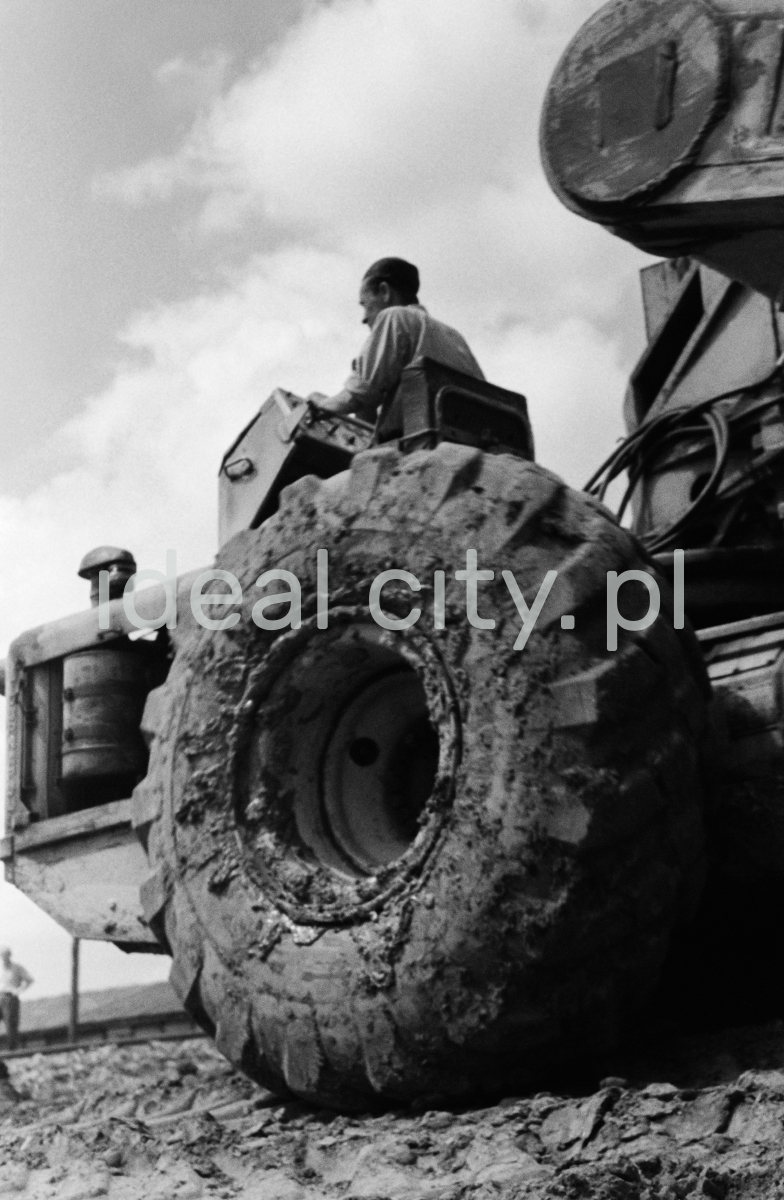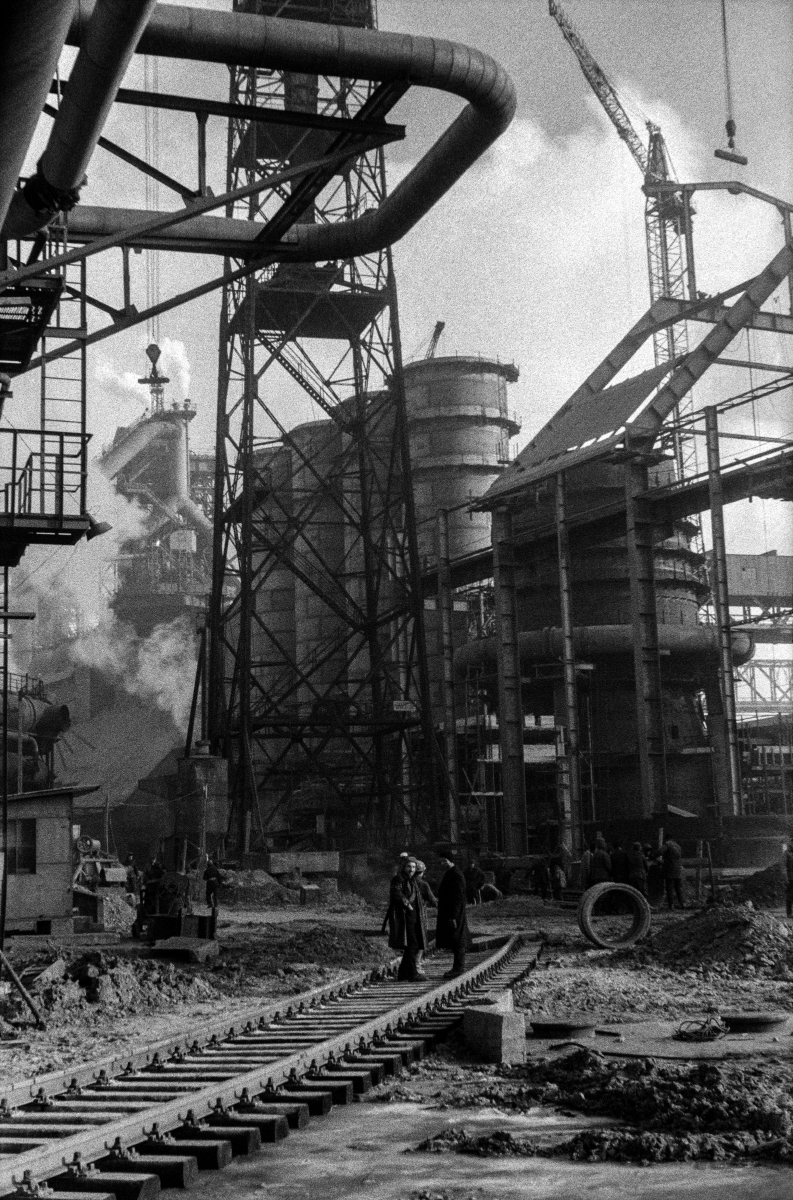CITY UNFINISHED
Dorota Leśniak-Rychlak
Conjuring Up a City
From villages and little towns, they come in carts
to build a foundry and dream out a city,
dig out of the earth a new Eldorado.
With an army of pioneers, a gathered crowd,
they jam in barns, barracks, and hostels,
walk heavily and whistle loudly in the muddy streets:
the great migration, the twisted ambition,
with a string on their necks-the Czestochowa cross,
three floors of swear-words, a feather pillow,
a gallon of vodka, and the lust for girls.
Distrustful soul, torn out of the village soil,
half-awakened and already half-mad,
in words silent, but singing, singing songs,
the huge mob, pushed suddenly
out of medieval darkness: un-human Poland,
howling with boredom on December nights….
Adam Ważyk, A Poem for Adults
The two banks – the years 1949 and 1955 – have already been connected by a giant bridge resting on six piers: the grand structure of the Six-Year Plan. A dream has been captured in a net of mathematical calculations – its image depicted in technical drawings. We say: Nowa Huta is growing.
The output of this new industrial plant is going to exceed the product of all industrial plants of the same type in Poland heretofore. Today, the Kraków flatlands are resounding with the clangour of creative construction. Tomorrow, they will fill with the buzz of a great working city.
With every brick, with every square metre of removed soil, people of a new era, unknowing poets, are writing the grandest industrial poem in Polish history.
It is on its unordinary stanzas that the further fast progress of basic industrial branches depends, production of machine tools, tractors, agricultural machines, transport means, etc.
It is not by accident that a large percentage of these unknowing poets, and knowing constructors of the new city are young.
The youth: the first rows of a classless society in the first socialist city in Poland. The most enthusiastic elements, best suited for development.
Sławomir Mrożek, “Młode miasto”, Przekrój, 22 July 1950, no. 276
I begin by juxtaposing excerpts from two texts about Nowa Huta, written only within five years. Placing Mrożek’s reportage side by side with Ważyk’s poem highlights the clou, the basic tension inherent in the message about Nowa Huta. The propagandist image feeding off the ideal, the want, projections of future, remains in constant friction with the real world with its ongoing, and incapacitating deficiencies, impotence, and people whose darker sides, or even ordinary ones, prove incompatible with collective happiness. Persisting in the troubled relationship these two pictures encounter yet another one – the story of the communist system, its structural contradictions, and the reasons why it failed. The sunlit squads described by Mrożek are formed in the period of Stalinist terror, veiled in obscurity by the authorities issuing coaxingly reassuring newsreels, and press articles to divert attention away from mass incarceration, terror, elimination of democratic opposition, while propaganda insists on the ever-lurking imperial foe, and saboteurs. Just like the language of communist propaganda has become part of our world, and some phrases fix the entire narration of the system, so Henryk Makarewicz and Wiktor Pental’s photographs of Nowa Huta contain a coded rhetoric related to working people, and optimism inspired by the building of a new world, and a new society. These pictures, however, carry much more than social realist poetry commissioned by the authorities does: a city is rising out of magma and mud, and what we see is a clash of two worlds – Little Poland’s countryside, with horses and carts, and a big city broadway; we see huge furnaces and metallurgists’ daily toil. There are green trees, and a nursery as pretty as a picture, but there is also mud, and a rubbish heap instead of a pavement. Winter light and long summer days, and many shades of grey.
Let us take another look at Mrożek’s reportage written in a language that is one of the means employed to convey immense propagandist enthusiasm for establishing a new order, the construction of a city to fulfil the dream of a fairer world. Although Mrożek’s style is strikingly grandiloquent (many years later the writer will strongly distance himself from the text), the young journalist gives a concise sketch (on the centrefold in the Przekrój weekly) of a fairly complete project of the new reality. It shows Nowa Huta as a component in a bigger scheme for state reconstruction (the Six-Year Plan), a new industrial centre (industrialisation of Poland), offering tools for the rearrangement of the whole country; it also shows the new men of the future – junaks assembling a scale model of new estates right by the tents they live in during the construction. Educated still by pre-war masters, they are supposed to be the flickering embers of a brand new classless society. Mrożek’s piece is brimming with ardour: the youthfulness of the city, the youthfulness of its constructors and architects, and a tremendous sense of optimism, faith in a better tomorrow. The new man also emerges in many documentary photographs by Pental and Makarewicz, as well as in newsreels filmed when Nowa Huta was built. The sun is shining, causing geometrical shapes of the new city to cast sharp shadows, while builders’ muscles escalate their poses, their bodies captured in motion, at work. The meticulously composed picture must not have imperfections, difficulties are surmounted for the sake of the “bright days of tomorrow,” emphatically announced by a voice-over in a 1951 newsreel titled Kierunek – Nowa Huta! [Direction – Nowa Huta!]. The objective of Nowa Huta is clearly outlined in an article by Roman Dzięciołkiewicz, an editor with the newspaper Budujemy Socjalizm [We’re Building Socialism]: it ought to be “the most convincing token of the creative power of man altering nature to ensure happiness of the nation, erecting gigantic buildings.”[i]
[i] R. Dzięciołkiewicz, “Z przeludnionej wsi – drogowskaz Nowa Huta”, in: Nowa Huta – Duma Narodu, Kraków, propagandist publication of the WKW Frontu Narodowego w Krakowie, p. 30.
Some images must have been taken in bad weather, in wintertime or on rainy autumn days, because they disagree with the vision developed to excite optimism and zeal, as well as – it could not have been different – a rosy future. In Andrzej Wajda’s Man of Marble (1976), the newsreel showing a concrete mixer bogged down in mud, gentle chiaroscuro, and an uproar over meagre food rations directed against the local party representative, is deposited in the archive, kept out of sight. A lot of such ‘waste’ documentary shots can be found in Pental and Makarewicz’s output, and it is these records that constitute perfect material for research on daily life, a contribution to uncovering the genuine picture of Nowa Huta, to replace its black and white image created in communism, and strongly promoted after 1989.
We shall return later on to discrepancies and tensions carried within the pictures, yet now it is the utopia that comes to the fore; the utopia present in the social realist vocabulary of Mrożek’s reportage, and in its contact with human lives, emotions, wants, and weaknesses, which tended to run counter to the design of a socialist new man. The article could easily replace the voice-over in Polska Kronika Filmowa newsreels, so strictly was the linguistic depiction determined by socialist rhetoric (however, the unbearable propaganda could not veil Mrożek’s major literary talent). Adam Ważyk, on the other hand, a celebrity in the party, a party member, a propagator of socialism, in 1955 takes a look at the gloomy reality, and points out it is a vast distance from propaganda. His tale is meaningfully addressed to adults. The very titles of the two texts present a significant opposition: the youth versus the grown-ups. The diagnosis made by Ważyk, whose publication in 1955 in Nowa Kultura was synonymous with public suicide (and presaged Gomułka’s thaw), implied that the new system, and its approach to people were marked by naivety, and indeed immaturity (or, perhaps, Gombrowicz’s replacement of fatherland: “sonland”). However, it should be remembered that the poem by the former socialist celeb ended with an invocation to the party (“we appeal through our Party”). It was hence the party that was to effect change, and Ważyk may have been suggesting that the objective pursued by the system was right, but the idea underwent deformation, and it was time to return to the source to repair the world, and the city. In both literary visions, we see a frozen image of Nowa Huta in construction, assuming a regular shape, conditioned by technology, architects, and planners, as well as the more or less involved builders – junaks and the labour mass that brought “Frits” to Ważyk’s mind. The coming-to-be of a city has been recorded in Pental and Makarewicz’s photographs, revolving also around the very structure taking shape amidst empty fields, the geometrical power of cranes and scaffolding, as well as cubic skeletons of buildings, or boxes to contain human lives.
Nowa Huta is situated halfway between the ideal city, and utopia. It constitutes an attempt to create an urban ideal, taking into account the new order of the world after the Second World War.
Utopia has been known to humans since antiquity, although its name was coined by Thomas Moore who first used it in his novel under a rather longish title A truly golden little book, no less beneficial than entertaining, of a republic’s best state and of the new island Utopia, published by the English thinker and politician in London in 1516. So utopia is both a literary genre, and a political and social concept of a new order of interpersonal relations. The term “utopia” comes from Greek, and stands for a “non-place;” it is by definition impossible to be achieved, so it can be applied somewhat to everything – starting from distant blissful islands where the sun never sets, to human rights, emancipation of women, or universal education. An ideal social order has always been aimed for. The first comprehensive discussion of such organisation within the framework of city-state is Plato’s Republic, in which he criticises the orders he knew, and outlines a vision of the first utopian city avant la lettre – Kallipolis, governed by a philosopher king, and with commonly owned property. A picture of social and spatial relations is also found in Aristotle’s Politics; the author rejects Plato’s suggestions, and mostly the key aspect for all conceptions of urban transformations, the question of property.
Plato advocates common property, while Aristotle claims that it would result in diffusion of responsibility; he speaks for diversification of classes, and hierarchy, rather than unification. He writes:
Below this spot should be established an agora, such as that which the Thessalians call the ‘freeman’s agora’; from this all trade should be excluded, and no mechanic, husbandman, or any such person allowed to enter, unless he be summoned by the magistrates. It would be a charming use of the place, if the gymnastic exercises of the elder men were performed there. For in this noble practice different ages should be separated, and some of the magistrates should stay with the boys, while the grown-up men remain with the magistrates; for the presence of the magistrates is the best mode of inspiring true modesty and ingenuous fear.[i]
[i] Aristotle, Politics, Book Seven, trans. B. Jowett, http://classics.mit.edu/Aristotle/politics.7.seven.html (accessed 17 Sep 2018).
It is clear that a hierarchy of residents is crucial, and established relationships should not be abolished; instead, the best possible system should be developed. However, I would like to emphasise the last sentence of the quotation, related to “the presence of the magistrates,” which is supposed to inspire the right civil attitude. This method of maintaining discipline – via observation – will find its extreme expression in the spatial concept of the Panopticon by Jeremy Bentham (who was a teacher of utopian Robert Owen, by the way), his design for the organisation of prison. A resident of Nowa Huta was also observed by the authorities, his or her attitude could be assessed by a collective (the notorious acts of repentance performed at many meetings and conventions), and spatial relations increased the visibility of citizens and their daily lives by means of squares, broad roads, and interior yards; whatever happened in the yards was watched by neighbours through windows.
In literature, Nowa Huta is discussed as an instance of an ideal city built from scratch as the title of the exhibition at the Historical Museum of the city of Kraków and the accompanying catalogue show: Nowa Huta. Architektura i twórcy miasta idealnego [Nowa Huta. The Architecture and Creators of the Ideal City].[i] I shall try to outline the history of utopian thought along with its social ideas, as well as to present the created structure against ideograms and plans related to concepts of the ideal city. Dealing with utopia, one has to remember that Nowa Huta was a product of a specific political system, and its project reached far beyond the limits of the city or country, unlike in a literary utopia where the capital city is the most obvious example of the planned and imagined reality, and its fullest reflection.
[i] Nowa Huta – architektura i twórcy miasta idealnego. Niezrealizowane projekty, Kraków, Muzeum Historyczne Miasta Krakowa, 2006.
It is worth venturing a look beyond the schemas related to the political system in the Polish People’s Republic in its Stalinist version so far. There are two common approaches to socialist realism which view it as a power thrust upon the country and consequently discredited, or a period in history which lacks subjectivity, shaped exclusively by external forces. They are confirmed by recent suggestions that the Palace of Culture and Science should be knocked down to accentuate the end of Soviet domination, an idea which pays no attention to the fact the vast spaces of the Palace are actually used by people (though not necessarily the masses), and that it is the largest public building in the capital. The second approach is characterised by selective nostalgia transforming the Polish People’s Republic into folklore, part of people’s biographies (pining for one’s youth), a system that now comes across as bizarre, and potentially able to make monetisation of nostalgia possible (e.g. Nowa Huta Crazy Tours in the 2000s), with selected elements that can be seen as museum exhibits (milk bar, Lenin’s monument, Trabant). In the introduction to their recent anthology Socrealizmy i modernizacje [Socialist Realisms and Modernisations], Aleksandra Sumorok and Tomasz Załuski postulate an interpretation of socialist realism as a period of modernisation (of which Nowa Huta is a perfect example) and abandonment of clear-cut dichotomies in studies devoted to that time; instead, actual social transformations should be scrutinised in their own right rather than being regarded as a mere background for political processes. They insist that extensive research into daily life should be undertaken,[i] and it has indeed been undertaken in relation to Nowa Huta. The work of the pair of researchers from Łódź belongs to the trend of studies reaching further than a political perspective, and taking into account the living conditions in the Polish People’s Republic, but also peculiar biographical autonomy of the heroes from those days.
[i] Socrealizmy i modernizacje, A. Sumorok, T. Załuski (eds), Łódź, ASP, 2017, pp. 7–45.
This is just one of many possible questions which cast light on Nowa Huta’s contradictions. A workers’ town on the outskirts of a historical and intelligentsia centre, which – as legend has it – it was meant to destroy by polluting the atmosphere of Kraków, and indeed kept contaminating it with its fumes for decades, eventually became the arena of workers’ rebellion and, through its residents and people working in the steelworks, substantially contributed to the fall of the system. Kathrine Lebow even believes that the process of steelworkers’ emancipation in the Stalinist era, and the fact that they absorbed selectively (individually against the collective) the emancipating discourse educated them to the rebellion that came with Solidarity…[i] The ultimate significance of the end of the system for labourers of Nowa Huta as well as their lives in the transformation period requires a separate discussion. In any case, when we write or talk about Nowa Huta nowadays, we cannot but impose multiple clichés, myths as well as our bias towards the communist system, and the history of the place is turned into a metaphor of the fiasco inherent – as we have had the chance to learn from public debate – in the communist project.
[i] K. Lebow, Unfinished Utopia, Nowa Huta, Stalinism and Polish Society, 1949–56, Ithaca–London 2013. Lebow demonstrates that the tools to fight were obtained from a selective memory of Stalinism, while effective political protests were possible due to the urban planning, pp. 11, 152–177).
The central void in Nowa Huta suggest incompleteness, it indicates failure. We know from plans and drafts what was supposed to be located in the middle of the socialist city; numerous contest were run.[i] Like a classic town it was to have a town hall, and a theatre: the headquarters of the city council, and a temple of culture. But there is disingenuity in the idea. Even if we could justify references to historical architecture by claiming that they were to enable communication between the project and the working people (national form, socialist content), why was the functional scheme for the centre equally traditional? Why was the heart of the new town not dedicated directly to the new man, by means of a building – let us say – a centre of socialist culture, or a union house; why did it not point to the agency of the new structure: the party? The answer to this question is far from metaphorical: the reasons behind the lack of a town hall are administrative, and political: firstly, Nowa Huta is incorporated into the city of Kraków quite soon, on 1 January 1951, and in 1956 social realism is over in Poland, the form of the new centre is no longer strictly defined, and speculations will go on for years.
[i] Nowa Huta – architektura i twórcy miasta idealnego. Niezrealizowane projekty, A. Biedrzycka (ed), Kraków, Muzeum Historyczne Miasta Krakowa, 2006.
Anyone looking at Nowa Huta today, at its spatial organisation, must be struck by a conspicuous absence: the centre of the starlike construction in the Renaissance/Baroque style is void. The place where all axes converge, and which comes across as being the heart of the city remains incomplete. Emptiness, and the picturesquely descending slope of the River Vistula. The blue-and-pink post-modern Centrum E estate (design by Romuald Loegler and his team) and the Nowa Huta Cultural Centre (both dating back from the 1980s) enclose the space, rendering the lack of the centre even more evident. Nowa Huta’s rigorous layout is the result of an arbitrary gesture; the order and transformation given to that space is impressive in terms of scale, and consistency. As we know, the ideal presumes some sort of completion, wholeness – an ultimate perfection, providing a model for other enterprises. Historical ideal cities rely on symmetry, their layouts seem close and complete, which is also why they drew criticism – the arrangement was not consistent with actual dynamics of urban areas, frequently leading to them acquiring the character of open air museums.
One could venture to say that every utopian idea, through its totality and determination in having the only formula for common happiness, holds a dystopian version of its own, like a seed, from the very beginning. In Adam Czyżewski’s fascinating study Trzewia Lewiatana devoted to Ebenezer Howard’s concept of garden city, we discover the names of architects connected with the Gartengesellschaft, who designed the estate located by the death camp in Auschwitz, and the camp itself – according to the author – contains a whole programme of modern eugenics, and hygiene.[i] The dark side of modernising processes was also highlighted by Anda Rottenberg in the famous show Progress and Hygiene, an essay on horrifying endeavours to make people better by design, and architecture.[ii]
[i] A. Czyżewski, Trzewia Lewiatana: antropologiczna interpretacja utopii miasta-ogrodu, Kraków, Państwowe Muzeum Etnograficzne, 2001, p. 156.
[ii] Progress and Hygiene, curated by Anda Rottenberg, Zachęta – National Gallery of Art, 2014–2015. About the exhibition: “The exhibition presented in Zachęta, “Progress and Hygiene”, is devoted to the pitfalls of modernization in the context of the idealistic faith in progress and the possibilities of “betterment” common to both art and science at the beginning of the 20th century. It was conceived as an essay which critically analyses such phenomena as genetic engineering, eugenics or research into the purity of races, also drawing attention to their continued impact on today’s world.” https://zacheta.art.pl/en/wystawy/postep-i-higiena (accessed 17 Sep 2018).
Despite these reservations, the concept of utopia seems to be functioning effectively, and its content to have lost nothing of its relevance, even though contemporary utopia undeniably displays symptoms of a crisis; in the case of Nowa Huta it may actually provide a significant point of reference for social reality, and the space it generates.
Then she goes on to quote Jerzy Szacki:
«in point of fact, the boundary between utopia and non-utopia is fluid to some degree and dependent on opinion because what some people call utopia may be a programme, a prognosis, or a thought experiment to others.»[i] To classify something as utopia is not merely an instrument of analysis, but a judgement exposing a researcher’s intention and the orientation of personal involvement. It is not only a positive or negative qualification of a system as utopian that is problematic, but also the very act of considering them as utopian.[ii]
[i] J. Szacki, “Utopia”, entry in Encyklopedia socjologii, vol. 4, K.W. Frieske (ed), Warszawa, 2002, p. 285., quoted after: D. Jędruch, “Utopia jako kłopot”, p. 14.
[ii] D. Jędruch, “Utopia jako kłopot”, p. 14.
It is important to realise that the term ‘utopia’ is often used interchangeably with ‘ideal’, and there is no precise definition separating one from the other, especially that the term ‘utopia’ comes directly from literature, a sphere of fiction. In Autoportret, Dorota Jędruch points out:
We never cease tracing utopias with unfading enthusiasm, uncovering their fantastic structures, delighting in all sorts of paradoxes they display. And as the concept distends, every utopia reveals a counter-utopia: socialist versus liberal; progressive versus conservative; godless versus God-fearing; futurist versus traditionalist. Utopia is there for all to take, whoever needs it, to be employed in every debate for every possible purpose.[i]
[i] D. Jędruch, “Utopia jako kłopot”, Autoportret, no. 2, 2011, p. 14.
An ideal contains a smaller critical component, it is closer to the real world and provides a model whose perfectness is meant to be alluring. If we analyse concepts of ideal cities, they tend to revolve around form, or to constitute an aesthetic rather than social question; their negation of found world is by no means as powerful as in utopias, but they are more directly involved with real space. Izabela Mironowicz points out:
Despite apparent similarities based on regular form, ideal cities differ from utopian ones. Firstly, they relate to real cities, instead of reducing them to metaphors. Secondly, their unordinary regular form derives its rationality from an initial functionality. Ceremonial axes leading to the ruler’s palace integrate form and function just like parks for labourers enjoying a healthy lifestyle after work.[i]
[i] I. Mironowicz, Modele transformacji miast, Wrocław, Oficyna Wydawnicza PWr, 2016, p. 101.
These two concepts require delimitation. Jerzy Szacki defines creators of a utopia in the following way:
Utopians reject found world, and find no satisfaction in available possibilities: they dream, anticipate, plan, experiment. It is this act of non-acceptance that prompts a utopia. It comes to be when a split appears in the human mind between what is, and what should be […]. Utopians’ non-acceptance of the world as it is […] is total. […] Not every person thinking of changing reality is a utopian. But a person wishing to replace an absolutely evil world with an absolutely good world is one indeed.[i]
[i] J. Szacki, Utopie, Warszawa, ISKRY, 1968, pp. 27–28.
Utopias mushroomed in the Renaissance which provided space for reflection on humans as well as the faith in their ability to bring order to the world, related for instance to the breakthrough that came with great geographical discoveries. According to Emil Cioran, “As long as Christianity satisfied men’s minds, utopia could not seduce them; once Christianity began to disappoint them, utopia sought to conquer them and to establish itself there.”[i] The Utopia of the Renaissance, created by Thomas More in 1516, is an island. On it, the narrator, More’s protagonist Raphael Hythloday observed a perfectly uniform city where everything, laws, clothes, and customs were harmonious, and the same for everyone. Utopia constituted a criticism of “property-obsessed London,” as Joseph Rykwert put it, in More’s time.[ii] The capital city, Amaurote, had a square layout.
[i] E. Cioran, “Mechanism of Utopia”, Grand Street, vol. 6, no. 3.
[ii] J. Rykwert The Seduction of Place. The History and Future of Cities, Vintage Books, New York 2002, p. 46.
Marx and Engels named Robert Owen as the precursor of the trade union movement. He started to introduce the new organisation of ownership and labour relations already in the cotton mill in New Lanark, improving working conditions, building cheap flats, and establishing schools. He wanted to found a communist social system, and to create communities of up to 1,200 residents who would raise up children together. Having attempted that in England, Owen continued his efforts in America, and started a colony known as New Harmony in Indiana in 1825.
The proposals formulated by Owen and Fourier pertained to an overall transformation of the socio-economic structure which in an industrial city relied on terror and oppression. Industrial progress led to dramatic expanse of cities, while living conditions and labour relations were deplorable. Epidemics kept sweeping urban areas, there were no sewerage systems, and people coming from the countryside lived in overcrowded basements near smoking factories. In his poem “Jerusalem,” William Blake described the city as he knew it as “Satanic Mills.” The poem actually became an anthem for English workers, who sang it as they protested against capitalist exploitation. British socialism stemmed from Christianity, and the Victorian tradition of improving the world. Its futuro-nostalgic version was found in the work of William Morris, the author of another literary utopia – News from Nowhere – and initiator of the Arts and Crafts Movement with the objective to revive the humankind through crafts and arts. It seems worth mentioning that the work devoted to Morris’s achievement was composed by Edmund Goldzamt, one of the main ideologists of Polish socialist realism. In 1967, after the doctrine had been compromised, and more than a decade after Gomułka’s thaw had begun, he published a bulky volume William Morris a geneza społeczna architektury nowoczesnej [PWN; William Morris and the Social Genesis of Modern Architecture].

The new world order usually involved equality for all citizens, different ownership and labour relations, as well as a different framework of social life – commonly suggested egalitarianism offered endless possibilities. Early utopians seldomly came up with a definite spatial shape for a systematised world. Thinkers stick to the forms they are familiar with – Charles Fourier’s phalanstère looks like the Palace of Versailles in the entre court et jardin style, which is consistent with his theory of systemic transformations, paying attention to human passions rather than their needs, including the need for luxury. I will just mention that in one of the periods in the development of humankind described in detail by Fourier the seas would be full of orangeade. It is this picture that Adam Ważyk refers to in his poem quoted at the beginning.[i] On the other hand, Robert Owen’s New Harmony (founded in Indiana) has the shape of a quadrangle with an inner garden, and important buildings surrounded by walls in the medieval style – a place for labourers.
[i] “Fourier, the dreamer, charmingly foretold / that lemonade would flow in seas. / Does it flow? / They drink sea water, / crying: / “lemonade!” / returning home secretly / to vomit.” A. Ważyk, “A Poem for Adults”, translation unattributed, http://konicki.com/blog2/2009/06/04/june-4-a-poem-for-adults-by-adam-wazyk/ (accessed 17 Sep 2018).
Although the organisation of the new society, or utopia, was described in numerous literary works, its precise spatial form was rarely presented. Sir Francis Bacon’s New Atlantis, significant though unfinished, has no definite shape, even though the author provides detailed descriptions of buildings or dress in Bensalem, an island somewhere in the Pacific Ocean, not far from South America. Scores of utopian ideas emerging in the 18th century failed to offer specific spatial solutions, they rather related to traditional concepts of utopia relying on return to nature. For the authors, new social organisations were societies living in places untouched by civilisation, where primeval harmony among people, as well as between people and nature prevailed. These visions elicited a literary response in the form of parody – Gulliver’s Travels by Jonathan Swift. Bacon himself played an important role in the creation of English colonies: Carolina, Newfoundland, and – aptly enough – Virginia, unspoilt and pure places where a better version of the old European world would hopefully emerge. In the 17th century, the creation of new colonies and communities tended to be driven by religious beliefs, and was related to various interpretations of Christianity, also those close to historiosophy. The gnostic character of utopian organisations, regardless of their apparent reasonability, connected with the religious nature of the concept presuming that people are capable of transcending the real world, and that there was some sort of a higher order is conspicuous; in The City of the Sun it was a supreme cosmic being.
Another utopia is found in the Late Renaissance novel by Tomasso Campanella, The City of the Sun; there the urban settlement has a circular form relating to the eponymous star in the Solar System. Interestingly enough, Stalinist architect and urban planner Ivan Leonidov was inspired by this book, and the Sun became a leitmotif in his planning efforts as well as in his symbolic idealising creative work made after he had fallen from grace with Stalin, even though – unlike many other architects – he was not detained in the Gulag, or executed.[i]
[i] More about Ivan Leonidov’s work in the article:
Ideologists of the new style were conferring in the capital of the empire about the ultimate embodiment of the idea of socialism, accusing one another of being inconsistent with the indefinite doctrine. It could happen that architectural solutions were actually determined by a gesture of the General Secretary as in the story about Generalissimus Stalin who signed two different designs of the Moskva Hotel, thus forcing the architects to merge both plans.[i]
[i] V. Bass, “Paradoksy socrealizmu”, p. 17.
The concept of an ideal city is in fact a concept of an idealising urban form – in the Renaissance, it involved a central and symmetric layout – a circle, a hexagon, or a regular polygon. Such Renaissance developments include, for instance, Palmanova designed by Vincenzo Scamozzi, or Zamość designed by Bernardo Morando, commissioned by Jan Zamoyski. They tended to be connected to forts and took the shape of state-of-art polygonal bastions. Street layout in a Renaissance city resembled a checkerboard with a market square in the centre, but as Rome was rebuilt under Sixtus V diagonal axes started emerging in the urban composition. Among the first urban settlements with streets diverging in a raylike fashion from a circular centre was Palmanova, built in 1593, with its nonagonal fort and hexagonal square, as well as Glückstadt near Hamburg, designed in 1616 by François Pacherval as a half-hexagon. Diagonal arteries or radiating layouts found continuation in Baroque palaces, with the Palace of Versailles as the supreme achievement. The architecture of the city of Zamość, dating back to the Renaissance, with a checkerboard-like street arrangement, provided direct inspiration for the creators of Nowa Huta in need of ideas of local origin, and testifying to the triumph of ‘secular’ architectural thought on Polish territory. It is worth mentioning that the predilection for the Renaissance as a period dominated by reason coincided with demands for Classicistic references, and it was even in the very centre of where the doctrine of socialist realist architecture was formulated – the capital of the USSR – that debates were going on about what its proper and ideal form should be.
Discussing paradoxes of socialist realism, Vadim Bass writes:
Stalinist architecture is in principle not even what it is. Each building performs two simultaneous functions: as a material and perfectly useable thing, and as a promise – the outline of an ideal future with ideal «people-functions» resembling the pioneers and scientists depicted by reliefs in metro stations.[i]
[i] V. Bass, “Paradoksy socrealizmu. Architekt a władza w stalinowskim ZSRR”, Autoportret, no. 1, 2008, p. 16.
Christianity in the Middle Ages also pursued an urban ideal, a new Jerusalem (for instance Saint Augustine’s Civitas Dei). Although its vision was pretty concrete (cube), it was to be attained only in the afterlife so there was no specific place on earth determined as its location.
It was in the 18th and 19th centuries that utopian ideas evolved in greatest numbers, following industrial development and critical attitudes towards living conditions in early capitalism. And here appears another important feature of newly proposed systems and communities, frequently triggering disapproval – a sort of enclosure, a sense of definiteness which rules out progress and adaptation to changing conditions. Such impression was produced by closed Renaissance structures, but also Ebenezer Howard’s garden cities which was to be encircled by railway so that the form would be finite, and once the planned number of residents was reached, the outskirts would not expand.
Despite the fact that all enterprises related directly to Howard proved unsuccessful, the garden city movement achieved huge popularity in the early 20th century, and we may find remains of such places across Europe, America, or even Australia. After the Second World War, the need arose for a grand reconstruction model, and here again Howard’s concept was implemented – it affected the new towns movement in the United Kingdom. The urban layout of Nowa Huta with its alleys radiating from the centre and greenery in the quarters displays distinct echoes of Howard’s ideas.
Communities and cities are in close connection. In The Seduction of Place, Joseph Rykwert writes:
Representation […] suggests reflection, intention, even design in this context: a project. Since it is always willed fabric and image (however unsatisfactory we may think them), a town or city can never be quite passive, and because there is constant interaction between society and the urban fabric, we cannot tinker with our cities without making some adjustments to society as well–or vice versa.”[i]
[i] J. Rykwert, The Seduction of Place.
In 1904, a contest for design of the first garden city was announced; it was won by architects Raymond Unwin and Barry Parker. They departed from Howard’s concentric arrangement for the benefit of a more free and painterly planning à la Camillo Sitte. Both creators presented numerous designs of typical houses representing a version of simple vernacular architecture, well-planned in terms of exposition to sunlight, and comfort. Unwin and Parker’s design, originating in their interest in home architecture and the Arts & Crafts ideas, became an emblem of the garden city, its global future-nostalgic showcase.
In 1938, Lewis Mumford named three conditions a garden city needed to meet: collective ownership of land, the territory and number of residents should be limited, and lastly there should be functional connections between the city and surrounding terrain.[i] Soon after Howard’s book was published, actions were taken to put his ideas into effect. The Garden City Association was founded, which in 1899 formed the First Garden City Ltd. with the aim of creating the first garden city – Lechworth. The company purchased land in Hertfordshire, about 50 kilometres away from London. As the prototype was being constructed, it turned out that Howard’s belief that a city for all could be made was simply unrealistic. Investors in the garden city – including such magnates as Edward Cadbury (owner of chocolate factories) and William Lever (soap manufacturer) – were interested in profits generated by the income from land rent. No worker cooperative in Great Britain was won for the idea, and consequently – and contrary to the ambitions of its founder – the social structure of Lechworth was from the very beginning different from ordinary urban areas; it was inhabited chiefly by freelancers, and highly skilled artisans. Workers could not afford living in the city, they commuted to work by bikes from inexpensive suburbs.
[i] L. Mumford, The Culture of Cities, New York, Harcourt Brace, 1938, pp. 396–397.
It is obvious that Nowa Huta was about the collective mode of living, although the modernist block was to appear there quite late because of the dominant socialist realist doctrine. Despite the collective architecture, the layout with radiating roads may be traced down to the first realisations of Ebenezer Howard’s ideas, or the pioneering Lechworth Garden City established in 1912. The garden city was an idea of a visionary who wanted to combat the problem of poverty and overcrowded 19th-c industrial cities with their fumes, penury, and deplorable working conditions. Howard suggested fusing the benefits of living in the city and the benefits of living in the country, while trying to eliminate the evils of both. In a diagram depicting magnets attracting to the countryside and the city, he asked the question which would draw people. The answer – the garden city presupposed establishment of urban developments with a maximal population of 50,000, living in a concentric arrangement with broad green roads converging in a central park. Each resident would have a house and a garden, city grounds would be owned by the community, and the inhabitants would be shareholders in the company managing the city.
The question that arises is whether the spatial form advocated by the visionaries of new organisms contains their social programme. In his article on utopia, Robert Fishman claims that rather than being merely a set of images presenting relations organising an ideal society, the ideal city is mostly a model that makes transformations of these relations necessary, it presages them.”[i] The place where the genuine transformation of social relations occurs is the flat, and the way it is arranged. So on the one hand, there are estates of single-family houses in industrial towns related to paternalist capitalism, and on the other collective living compounds, mostly connected with socialist concepts.
[i] R. Fishman, “Utopia in Three Dimensions: the Ideal City and the Origins of Modern Design”, in Utopias, P. Alexander, R. Gill (eds), London, Duckworth, 1984, pp. 95–108; A. Czyżewski, Trzewia Lewiatana, p. 43.
It is thus important to acknowledge this continuous and, which should be stressed, mutual interaction between the structure and the human. Bilateral change and ongoing exchange. Joseph Rykwert’s opinions are even more convincing, and the relationship more perceptible in relation to an urban structure that is created from scratch, as much the urban fabric as the new man, the builder of the system, the Nowa Huta labourer, and the society.
This picture of the real life and the hardship of living in Nowa Huta was especially difficult to be accepted by the authorities; from the moment socialist realism was adopted in 1948, Nowa Huta – along with the reconstruction of Warsaw, and the construction of the Marszałkowska Dzielnica Mieszkaniowa (MDM) estate – constituted a major rhetorical spatial argument in the struggle for socialist order. Architecture and urban planning of the period were supposed to be ideological declarations about the superiority of the present world over the pre-war order.
Bolesław Bierut explained the meaning of architecture for the regime of the early Polish People’s Republic under Stalin:
Architecture is particularly significant for the party, because it is a specially weighty ideology, and the party cannot be indifferent to ideology. Ideology is postulating desired values for the future, it is drawing a picture of the future. And architecture by its nature gives shape to developments which are meant to last. Ideology finds a grand form of its incarnation in architecture. There is no better way of presenting our objectives, but the panoramic models of new cities.[i]
[i] A. Skalimowski, “«Budowniczy stolicy». Warszawski mecenat Bolesława Bieruta w latach 1945–1955”, Pamięć i sprawiedliwość. Pismo Instytutu Pamięci Narodowej, no 2(24), 2014, quoted after: P. Lipiński, Bierut. Kiedy partia była bogiem, Wołowiec, Czarne, 2017, pp. 158–159.
The seemingly coherent nature of Nowa Huta reveals the stages of its coming to be, as well as references to various design and ideological concepts. What may at first appear to have been precisely planned, was in fact created in a gradual progress (maybe even without a plan, or necessary infrastructure), while what had been planned was to a great extent not put into effect. Hence the lack, the absence mentioned at the beginning. Nowa Huta as we know it today conveys the impression of a perfectly designed city, but it took time for the urban form to develop its final shape. Firstly, junaks from the paramilitary organisation Służba Polsce lived in tents and barracks, then in blocks of flats as they were constructed, frequently before the infrastructure was installed, or with a faulty heating system. Nowa Huta needed lots of workers, but their living conditions remained deplorable for a long time. In the picture, the walls are growing high, the operation of sewage system is presented, but the truth is that the housing needs were not satisfied for decades. Kathrin Lebow writes about married couples living separately in hostels, or evicted single mothers.[i] The housing shortage is confirmed by the data from the period, and by a reportage by Ryszard Kapuściński, which was commissioned to expose the untruth of Ważyk’s poem; however, the article titled To też jest prawda o Nowej Hucie [This Is The Truth about Nowa Huta As Well] published by Sztandar Młodych in 1956, only discussed the problems described in Poem for Adults in detail.
[i] K. Lebow, Unfinished Utopia, pp. 97–123.
Some processes and discourses of modernity within the state persist: similar modernising aspirations were observed in the interval between the wars. Models for Nowa Huta – in terms of sheer scale, and the idea of mass industrialisation – were provided by the ambitious enterprises of the Second Polish Republic: the construction of a new port in Gdynia, and the Central Industrial District with the steel mill in Stalowa Wola. The idea of industrialising the agricultural region of south-eastern Poland which involved grubbing out the Sandomierz Forest to make space for the steel mill was reflected in the construction of a steelworks in the agrarian region south of Kraków. Eugeniusz Kwiatkowski’s initiatives of the period between the two world wars provoked the popular narrative of modernisation and industrialisation as the determining factors of a modern state. This narrative proves a fertile ground for the foundation myth of Nowa Huta – the first socialist town merged with a steelworks, a workers’ town. Polish territories, the theatre of war, were demolished by WWII. Manoeuvring German and Soviet armies brought along death for millions of Polish citizens, extermination of Jews, devastation of land, as well as industry, and residential houses. But the prospect of peace, and reconstruction despite Soviet domination inspired Poles to make the huge effort of rebuilding the country. Designers of the new city were not hard to find, young graduates of architecture many of whom were former soldiers of the Home Army, led by Tadeusz Ptaszycki, a former scout, a pre-war architect, who had fought in the September Campaign, and been detained in a prisoner-of-war camp.
According to Juchnowicz,
The scale and shape of specific housing units are closely connected with the layout of the city. Four estates compounds (A, B, C, D) have been designed, each capable of taking about 20,000 inhabitants. Each compound consists of three or four estates, able to house five to six thousand people. […] The implemented social concept of Nowa Huta is founded on the Anglo-Saxon neighbourhood unit concept, forming groups of residents around elements of social relations. This is connected with the hierarchic system of service centres.[i]
The emergence of cities consistent with visions of new socioeconomic organisation is related to the search for places that offer the chance of staring anew, unburdened by physical fabric which is an emanation of the previous – erroneous – system. Nowa Huta reflects the Howardian model of constructing an urban settlement in a location formerly uninhabited, although the space it entered was not empty. The designers of the new town, Tadeusz Binek or Stanisław Juchnowicz, stated in many interviews that situating the settlement on terrains of old villages, on fertile lands, was imposed by the Soviet Union, and the decision was taken centrally. In Andrzej Wajda’s Man of Marble, a bold study of the disintegration of the new man – the model worker, there is a metaphoric scene from the censored Polish Film Chronicle – fruit trees in bloom are fallen by bulldozer tracks. The soil now bearing new estates and the combine used to belong to Lesser Polish peasants, expropriated, and ousted. This transformation of ownership relations, a component in the catalogue of utopia’s rhetorical means (in the photographs: an old house contrasted with a new estate, or horse-draw carts against the background of blocks of flat under construction) brought about many tragedies, some peasants even committed suicide. But it is still undeniable that builders of Nowa Huta came from extremely poor villages of Lesser Poland, and their involvement in the construction of the city had an emancipatory dimension: having abandoned hard toil in the field, and more often than not unfloored shacks, they found themselves in a large urban settlement where they could acquire new skills, obtain qualifications, and begin earning money.
[i] S. Juchnowicz, op. cit., s. 29.
These ideas are associated with Jean-Baptiste Godin’s Familistère (fulfilling Fourier’s idea of community), Robert Owen’s conceptions, and the Harmonist settlements in the United States, while they were implemented by Soviet constructivists in Nakrofin. A radical reconstruction of relations postulated during the Russian Revolution affected the very foundations of established models. The socialist realist town was no longer wishing to do away with the family as a recreational element, but it could not afford to celebrate its isolation in a single-family house. Witold Cęckiewicz recalls that designing this kind of buildings was forbidden, and attempts to ‘smuggle’ them within estates could upset the authorities.[i] Collective living establishments also satisfied the great accommodation needs, and constituted effective space management. The first estates in Nowa Huta, built before a general plan was produced, came under criticism for their extravagant treatment of parcels, and excessive greenery, similarly to Ernest May’s designs for Magnitogorsk before the Second World War (1931). At first, the blocks were in the Heimatstil with no strictly historical features, but rather in a generally traditional spirit. The later quarter arrangement was inspired by the neighbourhood unit proposed by Clarence Perry, and the interbellum estates in Red Vienna. Perry’s concept was a comprehensive response to the quest for housing solutions connected with basic services, and their separation from traffic. The design sketched by Perry for New York included quarter arrangement with internal courtyards for neighbours to interact in. The dimension of particular units was conditions by the capacity of educational institutions – schools, or nurseries. In his book Housing for the Machine Age, published before the war in 1939, he not only developed the concept of neighbourhood as such, but also defined the spatial form of housing.
[i] Witold Cęckiewicz in a conversation, May 2013. Cęckiewicz designed a socialist realist estate of single-family houses in the Dębniki District (ul. Jaworowa) in Kraków. He planned terraces for semi-detached houses which could be later transformed into garages by owners. Designing and building garages was illegal. This was also where the system showed inconsistencies, which the authorities would overlook.
Connecting worker districts with the place of work goes back to the 18th-c capitalism, and it became extremely widespread in the United Kingdom in the 19th century. In Poland, the best-known examples of such places are found in Upper Silesia (Giszowiec, Nikiszowiec). These were new post-feudal systems of organising social life of workers, bound to repay the houses their families lived in for years, while any rebellion was practically made impossible by subtle mechanisms of control, which was already criticised by Engels as solutions delaying the desired and inevitable confrontations of classes, and, as a consequence, a global revolution.
The expectation that a socialist city would guarantee the reproduction of system was not different – in the context of continuity of social order. It was the foundation of the new order that was defined in a dissimilar fashion – it was not a single family, but a collective, a worker cooperative with its own council. All this was also expressed by the spatial arrangement determined by the dominant ideology – children were sent to collective institutions and raised up by appropriate units, many everyday activities were performed collectively: cooking, or washing.
Industrial districts or towns in the 19th-c capitalism reflect an organisation of social life that is subordinated to factory work. Company towns emerging in the United Kingdom and the United States were directly related to towns built for steelworkers, even though they were at the same time criticised by socialist luminaries and party members. The whole life and residential cycle in a company town revolved around work performed for the company, including keeping consecutive generations of workers in the town. Hence the preferred model of the development of social life was based on the basic unit: family. The figure of a similar, patriarchal structure is the factory owner (Lever, Cadbury). Starting with first estates founded by patrons, factory owners often followed the principle of “good paternalism,” with manufacturers taking care of their workers, but also steering their lives. Founders of the first workers’ quarters meant to create a new ideal labour society by improving their living conditions. However, the decision to build houses for labourers was frequently taken for economic purposes: rents in the areas surrounding great industrial plants were going up, which could result in labour shortages. Moreover, workers who owned houses became dependent on land owners, and living in panoptic quarters they were continuously controlled. Even the goods available in inns were subject to planning, and unmarried labourers were stationed on the outskirts as a socially hazardous element with an incendiary potential.[i]
[i] P. Jaworski, “Tak wykształca się stopniowo spokojny, inteligentny, wartościowy robotnik przemysłowy”, Autoportret, no. 2, 2011, pp. 26–35.
There was enormous pressure on the builders, who were mostly unqualified boys from the countryside of Lesser Poland, seeking work and social advancement. It was the time of great Stalinist terror when people could be sent to prison for telling a joke, while informing on others to party units was commonplace, and a reason to be proud; still, young people – changed by the cruel war – were full of genuine enthusiasm, and eager to rebuilt the state as they truly believed in a new order. The very fact that peace prevailed moved people to participate in creation of life, also by joining the system. Architects Stanisław Juchnowicz or Tadeusz Binek claimed that it would not be right to refuse to take part in the ambitious project of building a new city. It should be stressed that the previous world order brought about terrible catastrophe to the world they knew, so the search for a new model was more than justified. The most serious manoeuvre, which operated at the psychological level, was indicating a new hero – the community. Naturally, there were numerous subgroups within the community: working people (labourers), activists of the Party, junaks, socialist youth, and smaller groups. Individual fate was only important if it contributed to the construction of a new reality. This is why model workers occupied such a major role; and so did propagandist tools creating new heroes. At the same time, there was no place for weakness or nuance of message in socialist rhetoric, for instance in reportages Ryszard Kapuściński wrote early on for Sztandar Młodych. Any criticism could exclusively be constructive, and right – following one specific pattern, and the inflated picture kept swelling, and generating an unbearable pressure even for the creators of media, as we would call them today.
The most precise description of the essence of the new architecture was provided by Bierut in a paper delivered on 3rd July 1949:
Our architects must draw to a larger degree from the healthy traditions of our national architecture, adopting it to new objectives, and new possibilities, infusing into them new socialist content.[i]
In photographs and newsreels young men flex their muscles, and briskly go about constructing what young architects have sketched for them on drawing boards in the city construction office. Still, all involved builders admit that the propagandist dimension of the steelworks construction project obliterated the rational plan. The construction site was muddy, because no dewatering had been planned or performed; land improvements were constantly delayed. The first residential buildings lacked the necessary infrastructure – electricity, sewerage, or gas network, so urgent was the need to provide accommodation. Road and rail communications also came late, the first tram connecting Nowa Huta with Kraków began to run in 1952.
[i] B. Bierut, Plan Sześcioletni Odbudowy Warszawy, Warszawa, Książka i Wiedza, 1950, p. 120.
But let us return to the moment when the city was created. In a 2006 article, Stanisław Juchnowicz points out the basic problems while designing a new development – lack of experience of building a city from scratch, shortage of building materials and workers, the brisk pace of work connected with the production schedule in the steelworks, and the rural origin of residents, not used to living in the city.
Designers created a new city in a specific style which was supposed to allude to historical forms. Socialist realism was the official style of the Soviet Union from the 1930s, in Poland it became the obligatory doctrine after the war, in 1949 (and remained so until 1956, or the so-called Thaw). The choice of costume was compulsory. Juchnowicz writes:
Around the centre, architecture is monumental, historicising. Having seen the broad road towards the combine, one of the American journalists wrote in the 1950s: «sucking communist architecture that witnesses people marching to the sounds of snare drums.» […] A great number of shops and their arrangement attracted people from all around Kraków; Nowa Huta was their favourite place to shop. Among the significant buildings in the centre that were designed but never constructed were the town hall, and a compound of offices. Instead, a pretty park was created in the very centre. Green spaces constitute an integral part of the city centre.[i]
[i] S. Juchnowicz, op. cit., s. 31.
A brand new world – how did its builders perceive it? On the one hand, there is the steelworks, the need of industrialisation, and progress in a predominantly agricultural country. We have a labourer undertaking so elevated physical work, simultaneously building, and living in a new town which forms one body with the steelworks. The speed of constructing the socialist city meant that not all aspects of life (perhaps also because of the nature of existence) could be controlled. Moreover, the worker himself, and the steelworks compound became the flickering embers, and the place of rebellion against the system.
On the other side of the political barricade, Leopold Tyrmand adopted a similar tenor commenting on the MDM:
Communists advance the thesis that urban planning demonstrates how a city should be built to be best suited for gigantic and submissive political demonstrations, and at once to rule out a military rising against their power, and to rear human termites crowded in cramped little rooms of huge residential blocks.[i]
Socialist realism showed the power of authorities, and offered – to quote Fourier – collective luxury, at least in the organisation and decorations of the most important spaces. The luxury was an intended gift. Criticising the social segregation in the pre-war capitalist city, Edmund Goldzamt wrote about the reconstruction of Warsaw:
[But today] on the ruins of the old city centre, the new Poland is erecting its representative forum – a huge homogenous development taking up almost 50 hectares, with a complex of buildings, parks, palace [highlighted by DLR] interiors, meant to meet the housing, recreational, and cultural needs of people.[ii]
[i] L. Tyrmand, Dziennik 1954 wersja oryginalna, Warszawa, Wydawnictwo Mg, 1999, p. 197.
[ii] E. Goldzamt, Architektura zespołów śródmiejskich i problemy dziedzictwa, Warszawa, PWN, 1956, p. 487, quoted after M. Murawski, Kompleks Pałacu. Życie społeczne stalinowskiego wieżowca w kapitalistycznej Warszawie, Warszawa, Muzeum Warszawy, 2015, p. 64.
Later uncensored accounts of life in Nowa Huta reveal a more shaded and ambiguous picture. The process of construction stopped by too much mud, waiting for never-arriving supplies, or basic infrastructure. There are stories of social advancement, of people who moved from primitive unfloored cottages to flats with electricity and a bathroom; but also of rural habits grafted into the city, like keeping pigs on balconies.
Witold Cęckiewicz, Chief Architect of the City of Kraków in 1955-1960, recalls:
I was showing those French people around Nowa Huta, and the selected flats they were supposed to visit. We go to the first one, then the second one, and the third one, and suddenly the door opens and a woman comes out complaining about running water. So we go there to check, and I see her bath is full of all sorts of things. The bathroom was crammed with things, they were new residents, and they would wash in a basin just because they were used to doing so. The society had to be educated. Nowa Huta was about a huge social revolution. Flats for workers involved in the construction of the combine had to meet established standards.[i]
[i] Witold Cęckiewicz. Projekty, M. Karpińska, D. Leśniak-Rychlak, M. Wiśniewski (eds), Kraków, Instytut Architektury, vol. 1, 2015, p. 31.
The new man – even if working as a labourer – still carried the burden of peasant identity, and the modernising split was frequently lessened with alcohol, as Kapuściński’s later articles demonstrate. People raised up in Nowa Huta in its early days remember chronic poverty, as well as the fact that children of Party members were better off. But there were also authentic communities with people helping each other. All local children would gather in front of the only TV set to watch Miś z okienka, a broadcast for kids.
Let us take a look now at the rhetorical and spatial solutions. To begin with, a couple of excerpts from Ryszard Kapuściński’s socialist realist poems. Our days:
When / you see in the charts / the picture of days to come / when you cast the concrete of socialism with your dreams and labour / when the heart beats as impatiently as a piston – you are a labourer of victory and a poet of grand plans. [And on:] The foundation must be soaked in toil and lime. Draw the building with the chisel of your hand. / So that before we see the end of the six-year plan, the hot open hearth furnace can swell and spurt the steel flame. / … So that the immensity of socialism grows with the shine and power of steel.
The very form of architecture in Nowa Huta’s centre with accentuated piano nobile, detail, attics, and sophisticated interiors (parquet floors) seemed to be an incarnation of Fourier’s luxury, and refer to the Palais Royale, a palace – a city for the people, a space not of the everyday, but of celebrations (according the Michel de Certeau’s terminology). This excess (although never complete) was one of the reasons why Krushchev and Gomułka were criticised, as well as why plants manufacturing prefabricated flats, and classifying residents according to needs, rather than excess, were initiated.
Modernisation was originally situated in the steelworks, the giant organism which was supposed to, from the political perspective, give rise to a modern worker society producing steel for the country rebuilt after the war. A transformation of social relations was going on, a gigantic revolution through which we sleepwalked, as Andrzej Leder put it.[i] The object – and at once the subject of this revolution was agrarian society which was to create a new socioeconomic order. However, it would be wrong to claim that the multitudes of young people working in the steelworks did not affect reality, or the development of power relations in the new settlement.
Next, the residential estates were built. The compounds consistent with Charles Perry’s neighbourhood units or Red Vienna were semi-private spaces, meant to be used by a community, but their spatial arrangement were also designed to maintain control – windows opened to the courtyard, allowing surveillance of neighbours. The architecture of these compounds reflected the political situation with fallout shelters and corridors connecting all entries (which were later used as escape routes during demonstrations). In stories related by people who remember the Stalinist period, there is terror, fear of supervision, denunciation, enemy, but also the fact that even the most intimate relationships were controlled.
[i] A. Leder, Prześniona rewolucja. Ćwiczenia z logiki historycznej, Warszawa, Wydawnictwo Krytyki Politycznej, 2015.
In a natural way, the construction of a great socialist worker city became a metaphor of the construction of a whole new state system. For this reason, this pars pro toto – the construction site of Nowa Huta was a place that had to be celebrated with boundless enthusiasm – there were few young writers who did not devote a poem or a reportage to the building of the new city. Just like in the case of Pental and Makarewicz’s camera, the lens of words worked in a selective mode, and employed specific means of expression. The catalogue of popular terms reveals a range of figures of speech used to describe the pride in the new state. And this how the photographs should be read, as rhetorical statements, like poems. Although, admittedly, they lack the grandiloquence which shamed writers.
Instead of conclusion, here is another excerpt from Adam Ważyk’s Poems for Adults:
I have heard a wise lecture:
“Without properly distributed economic incentives,
we’ll not make technical progress.”
These are the words of a Marxist.
This is the knowledge of real laws,
the end of utopia.
There will be no novels about ritualists,
but there will be novels about the troubles of inventors,
about anxieties which move all of us.
This is my naked poem
before it matures
into troubles, colors, and odors of the earth.[1]
[1] A. Ważyk, “A Poem for Adults”.
The time we live in has pushed any dreams of a better world away as “dangerous,” and the neoliberal system that shaped today’s cities, stubbornly claims that there is no alternative for the existing order of our globe. The photographs of Nowa Huta seem like images of a world long gone, both in terms of industrial production, and the production of a city. They deserve close attention.
There is one photographs in the set that impressed me more than any other, one of the few colour ones. It shows a nursery in Nowa Huta, children playing in the grass under the supervision of a nursery assistance. Their clothes – trousers, shirts, and headscarves – are identical. The picture brings to mind Aldous Huxley’s Brave New World – rearing new people to perform concrete tasks, unification within the castes of Alphas, Gammas, and Betas. This one moving shot reveals everything: youth and optimism behind the concept, its terrifying totality, social engineering, and the fear of becoming identical with other unified individuals.
In years to come, Nowa Huta would be the district with the greatest number of children in Kraków, which is confirmed by photographs depicting proud parents with prams, and children playing in front of blocks of flats (e.g. the drawing competition). The vast collection of pictures taken by Pental and Makarewicz also shows practices of the everyday – classes in nurseries and schools (possibly staged somewhat), daily walks of mothers with children, queues in shops, motorcycle races, processions and parades, Party meetings, and sailing on the reservoir. We can see a new order emerging from the mud and soil, crystallising into an urban structure. Frail trees are planted along the main communications routes, a layout of paths is taking shape, crenellations appear on attics, buildings are gradually covered with plaster, and paths with slabs. A city is coming to be. In a specific political reality, which presupposed a new social order, but also developed tools of oppression. It is hard to claim that the communist system was a utopia as it was actually implemented in a large part of Europe, and the world. Its doctrine surely assumed the possibility of reducing human beings to functioning elements of the world, the boldness of utopians towards the reality, the notion that they knew the solution. In the photographic records we see the hope that an ideal city is possible, and the haughtiness of its initiators. Nowa Huta presented by Pental and Makarewicz is young and promising, impetuous and extensive, combined with the life stories of its residents it reveals the story of a socialist city.
The collection also constitutes a photographic record of the whole social programme in the new city: gradually, though not fast enough, educational establishment were emerging – nurseries, kindergartens, schools; health facilities including the Stefan Żeromski Hospital (not surprisingly one of the estates was named Szklane domy (Glass Houses), a symbol of a better future used by the writer in his novel Przedwiośnie), and cultural institutions – cinemas and theatres. Founding nurseries reflected emancipation of women, whose former duties were delegated to educational institutions. Women volunteered as brick layers and actively contributed to the construction, Kathrine Lebow calls them women of iron. A new moral order also appeared in the early days of Nowa Huta, bringing many unintended pregnancies, and abortions. Appalling conditions young couples were forced to live in were described by Kapuściński in his hard-hitting reportage:
Now, take the few hundred young married couples for whom there are no flats in Nowa Huta. Try to figure out what a young girl expecting a child is thinking. That should not be difficult.
Do you know where young married coupled spend the nights round here? In gateways or in ditches. Stefek S. keeps telling me: »I’m not going to marry, I’ll never get married as I would have to have no respect for my wife as things stand.«[i]
[i] R. Kapuściński, “To też jest prawda o Nowej Hucie”, Sztandar Młodych, no. 234, 30 Sep 1955.
Finally, let us scrutinise Pental and Makarewicz’s photographs. Most pictures depict the steelworks, the raison d’être of the new city, its construction, operation, steel production, pig iron, and soiled faces of worn-out steelworkers. We see an extensive collection revealing the construction of consecutive buildings and estates, scaffolding and cranes, brick elevations waiting to be plastered, prefabricated elements installed in successive stages of the construction of blocks, quarters, and estates. Next to the growing architecture we see its creators, including moving portraits of model workers. Competition at work was among the main methods of the Party’s management, and unreasonable norms exerted pressure, and stimulated social mobilisation. Model workers were loathed by ordinary labourers, because their exceptional records became the new norm to be met by the multitudes building new houses. The story of Piotr Ożański – a model worker beating record after record in laying bricks – became the subject matter of Andrzej Wajda’s film, his brilliant interpretation of the fiasco suffered by the regime, while at the same time it destroyed individuality. In the case of Wajda’s protagonist, Mateusz Birkut, his disappointment in the system, and his apolitical stance would inspire his son to revolt, and lead to the foundation and triumph of Solidarity during the 1980 strikes at the Gdańsk shipyard. The real model worker would stay in Nowa Huta for the rest of his life, working in the coking plant, avoiding politics, his career would be ruined by alcohol, he would lose his flat, and be expelled from the Party.[i] In Wajda’s film, it is the woman who turns out to be an alcoholic, Birkut’s would-be wife, an athlete, beautifully played by Krystyna Zachwatowicz.
Broad roads were supposed to separate traffic from pedestrians, but also to provide space for demonstrations related to new rituals of power. In the photos by Pental and Makarewicz we can see demonstrations of two orders – marches of model workers on Labour Day, as well as religious processions in a new environment. The roads were also meant for the army, for tanks or armoured vehicles, first aimed against the imperial enemy, then – against labourers who opposed the Party. The first struggles were about the cross, and the position of the Church for which there was no place in the rational reality of socialism. Religiosity transplanted from the countryside (the Czestochowa cross in Ważyk’s poem) needed space, and it inevitably sparked an internalised conflict of two orders, as well as negotiations with the Church. When the authorities decided that a school should be built on the plot on which a church was to stand, the first rebellion broke out. But the rebellion is not in the photographs, it was not officially captured by the camera.
[i] http://www.mowiawieki.pl/index.php?page=artykul&id=138 ((accessed 17 Sep 2018).
